This is an A-to-Z guide on how to dominate real estate search engine optimization (SEO).
In this new guide, you’ll learn exactly how to use marketing to promote your real estate business, including:
- Real estate branding
- Offline marketing
- Website optimization
- SEO
- Email marketing
- Social media
- Listing promotion
- Online reputation signals
- Blogging, video, and lots more
Who is this for?
You are:
- A real estate agent, office manager, managing broker, admin, tech lead, or anyone else who wants to improve your real estate website’s SEO and rank higher for relevant Google searches.
- Knowledgeable about the process of buying and selling real estate. You’ve worked in real estate, in a brokerage, with other agents, brokers, admins, and assistants, and you are seeking to understand how SEO works and how to use it to improve your own website.
- Interested in how you can use SEO and higher search rankings to effectively generate new business, get more referrals, and stay top-of-mind with the clients you already know. You are eager to learn more, while recognizing that there are no silver bullets.
You want:
- To understand enough about SEO to use it wisely and intelligently incorporate it into your larger marketing plans.
- To create a steady stream of buyer and seller leads in your area and your niche.
- A focused strategy for promoting your business using proven, powerful tactics.
- To create a system for marketing your business that relies more on search engine results than paying for advertising.
- To be super-effective supporting others with real estate SEO needs.
- To leverage one of the steadiest, most reliable channels for reaching leads instead of hopping from platform to platform, hoping something will stick.
- A long-term strategy that you can focus on and execute instead of running in circles chasing the next big thing (that really isn’t).
By the end of reading this guide, you will:
- Understand what SEO is and why it works so well for real estate websites.
- Know exactly what boosts your website in Google rankings and what can hurt you.
- Be able to prioritize the SEO projects that will steadily increase your search rankings.
- Know how to talk to developers, designers, content writers, and the rest of your website support team.
- Understand how to integrate your SEO efforts with other marketing strategies, such as social media.
- Know what makes your competitor’s websites so good (and how you can replicate what they’re doing, only better).
- Be able to measure the results of your SEO endeavors, iterate on what’s working, and discard what isn’t.
Let’s dig into SEO.
What is SEO? Explaining the basics

Whether you got your real estate license decades ago or yesterday, when you got into the business, you might not have anticipated that you’d have to learn at least the basics of how search engines work. After all, what does Google have to do with buying or selling a house?
In 2021, the answer to that question is: Quite a lot! We know from the National Association of REALTORS®’ (NAR’s) 2019 Profile of Home Buyers and Sellers that more than half (55%) of buyers started their home search online, based on NAR’s data around the first step that buyers take.
If this many buyers are starting their home search online somehow, it’s a pretty good bet that they’re going to use Google, especially if they’re looking online for information. The search engine behemoth consistently captures more than 90% of search engine market share (91.98% in March 2020), trailed by Bing (2.55% in March 2020), Yahoo (1.66% in March 2020), and Baidu (1.44% in March 2020).
So real estate agents need to understand search engine optimization (SEO) because it outlines how Google and other search engines find and deliver search results to users—for agents, this means buyers and sellers looking for information about how to buy or sell a house online. Understanding and using SEO can help elevate your brand on Google and in real life, and you can use it to guide searchers toward specific valuable content on your website.
One thing agents should know about SEO is that it is not an overnight strategy. Google rewards websites that are consistent and that provide high-quality results. You can’t just throw up a website tomorrow, stuff it with keywords, and hope that Google will start ranking it on the first page of results tomorrow; in fact, that strategy is bound to backfire for more than one reason (and we’ll explain why).
If you’re hoping that SEO will create demand for your real estate services and build your brand immediately, it’s not going to work well for you. The foundation of solid SEO is links and engagements, and you’re going to have to work to get both of those things. But the good news is that not everyone is willing to put in this work, and if you are consistent with your SEO efforts, Google will reward you for it.
How does SEO work as a real estate strategy? This guide will walk you through everything you need to know as an agent (and then some).

SEO as a real estate strategy and why it works
Getting your page to the top of Google’s search engine ranking positions (SERPs) is an accomplishment in and of itself… but it isn’t a business goal. In other words, SEO is a means to an end, and you have to know why you want searchers to click on your website so that you can tweak your SEO strategy accordingly.
Many real estate agents use SEO as a lead-generation tool; they want to grow traffic to their websites in order to attempt converting some of those visitors into clients. Others might want to increase brand awareness of their name in their market or area. You don’t have to choose just one goal, but you should understand the foundational goal or goals behind your desire to rank well on Google before you start shaping your website to support those goals.
For real estate agents, SEO as a strategy simply means trying to rank on Google when people need an agent in your market, and ideally a specialist in your exact niche. To do this well, though, you’ll first need to get a sense of the different types of search results you can target.
The top organic search result on Google has a whopping average click-through rate of 31.7%, according to Backlinko. And on average, moving up one spot in the rankings will increase your click-through rate by 30.8% (though of course this varies depending on which spot you were in and which spot you achieved).

Why SEO?
According to the National Association of REALTORS®, the first step that 44% of all buyers take when they start thinking about buying a house is to search for homes online, while 11% look for information about buying a house. In other words, more than half of buyers turn to the internet when they want to answer a question or see what’s available in their market. An SEO strategy is your chance to be the first agent who makes a good impression on those buyers by:
- Understanding what keywords (terms) buyers and sellers type into Google
- Attempting to rank as high up in the search results as possible to capture buyer and seller traffic (and, ultimately, buyer and seller business)
Some agents might think that they can never compete with some of the bigger brands in the market for the buyers who are seeking homes for sale, but that’s not true.
One Keller Williams brokerage has created a website specifically for lofts and condos in Lowell, Massachusetts: Lowell Lofts. It ranks at the top of search engine results for the most important combinations of “lofts” and “lowell” and “ma,” making it a key resource for anyone seeking to buy or sell a loft in Lowell. For the highest-volume keywords, lowelllofts.com ranks first and second.
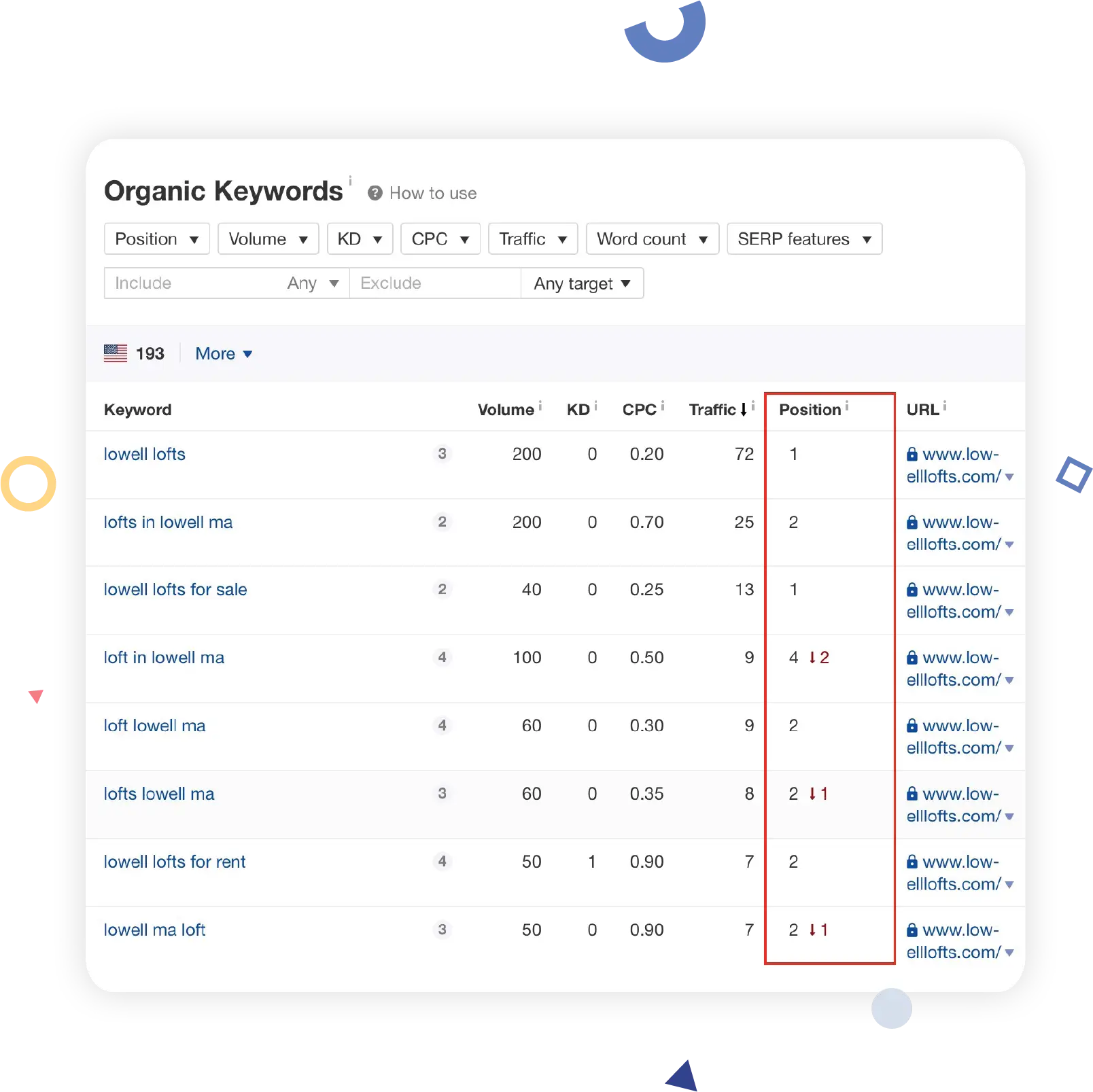
Just based on the top eight keywords surrounding Lowell and lofts, the website gets 150 visits every month from high-intent searchers who want to know more about a specific type of residence (lofts) in a specific area (Lowell, Massachusetts).
That’s one example of a keyword that’s high-intent but generates relatively few searches and visits every month. Real estate agents who master SEO can take advantage of larger, more lucrative keywords, such as:
- “condos for sale nashville tn” is searched 5,500 times per month
- “san antonio homes for sale” is searched 4,100 times per month
- “studio apartments for sale in nyc” is searched 250 times per month
Remember that you’ll get about 31.7% of total clicks for the keyword if you rank in the first position, which translates to:
- “condos for sale nashville tn” would generate 1,744 clicks per month
- “san antonio homes for sale” would generate 1,300 clicks per month
- “studio apartments for sale in nyc” would generate 79 clicks per month
A buyer (or seller) who’s already looking at properties for sale is a pretty hot lead, but that doesn’t describe most of the people who are searching Google for real estate information. Some buyers aren’t ready to pick the property yet, for example—they might have financial or legal questions that they should answer before they can get serious about shopping for a house.
It’s still worth your time to target those searchers with informational keywords. Providing detailed, helpful content will help build brand awareness and cultivate goodwill toward you with possible future clients. Always a good thing to do!
Here’s one example of how Redfin is using this strategy to educate buyers about real estate purchase agreements.
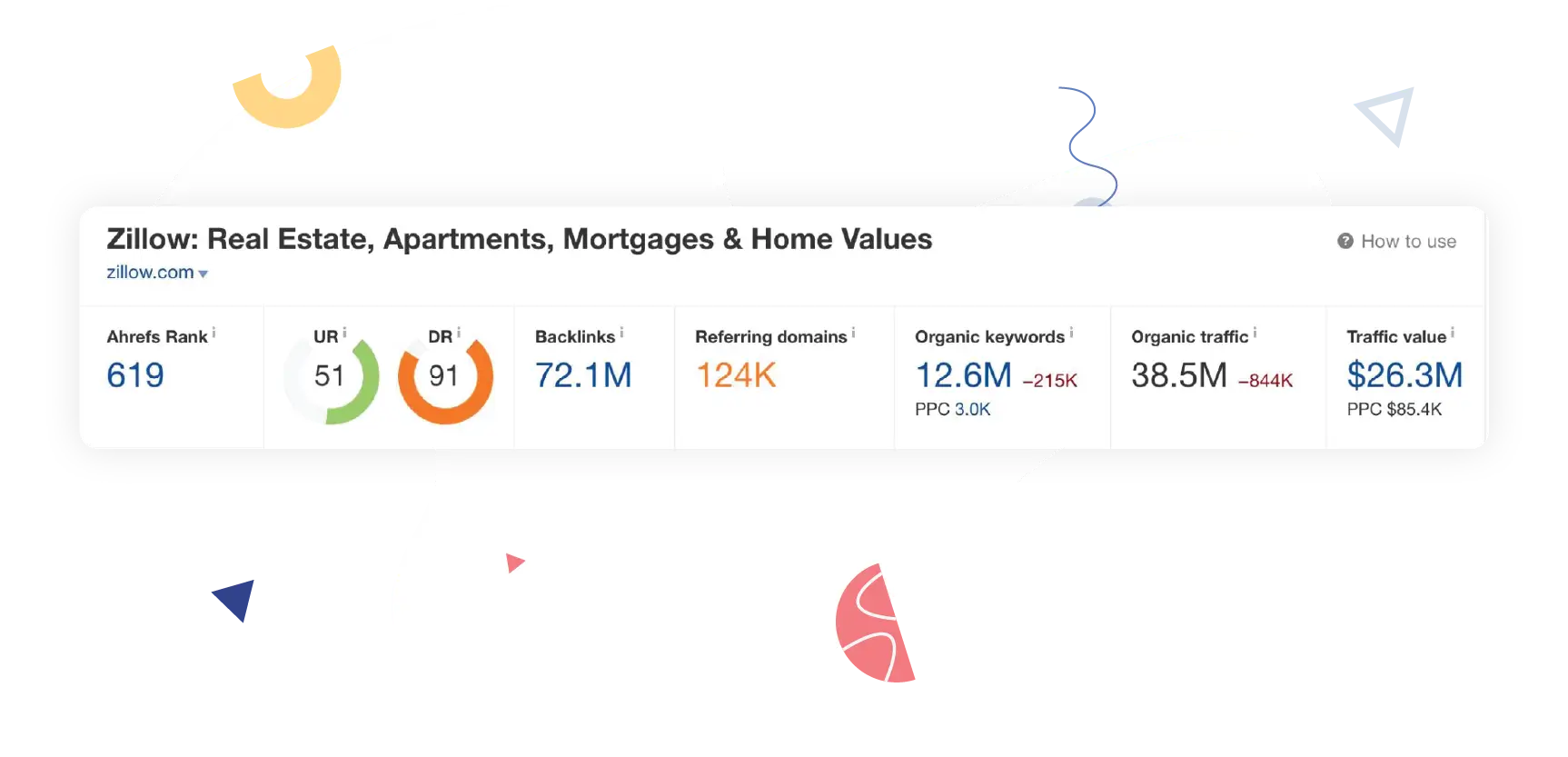
This post ranks for 228 different organic keywords and drives more than 600 visitors to Redfin’s blog post every month. When those visitors arrive at the post, they see an informative, clearly written article that explains different components of a real estate purchase agreement, then gently invites the prospective buyer (or seller) to talk to a real estate agent and learn more with a call to action (CTA).

It’s not enough to know that you want to rank for a keyword and then create a high-quality page with a CTA. You also need to know where you want to rank on Google’s search results pages; there are a lot more options than there used to be.
Sponsored results and ads
The first results that show up on Google for many searches are sponsored results or ads. Google’s ad program (Google Ads, formerly known as Google Adwords) allows you to purchase keywords; you’ll rank at the top of those keyword results and, if a user clicks through to your website, you pay Google for the click.
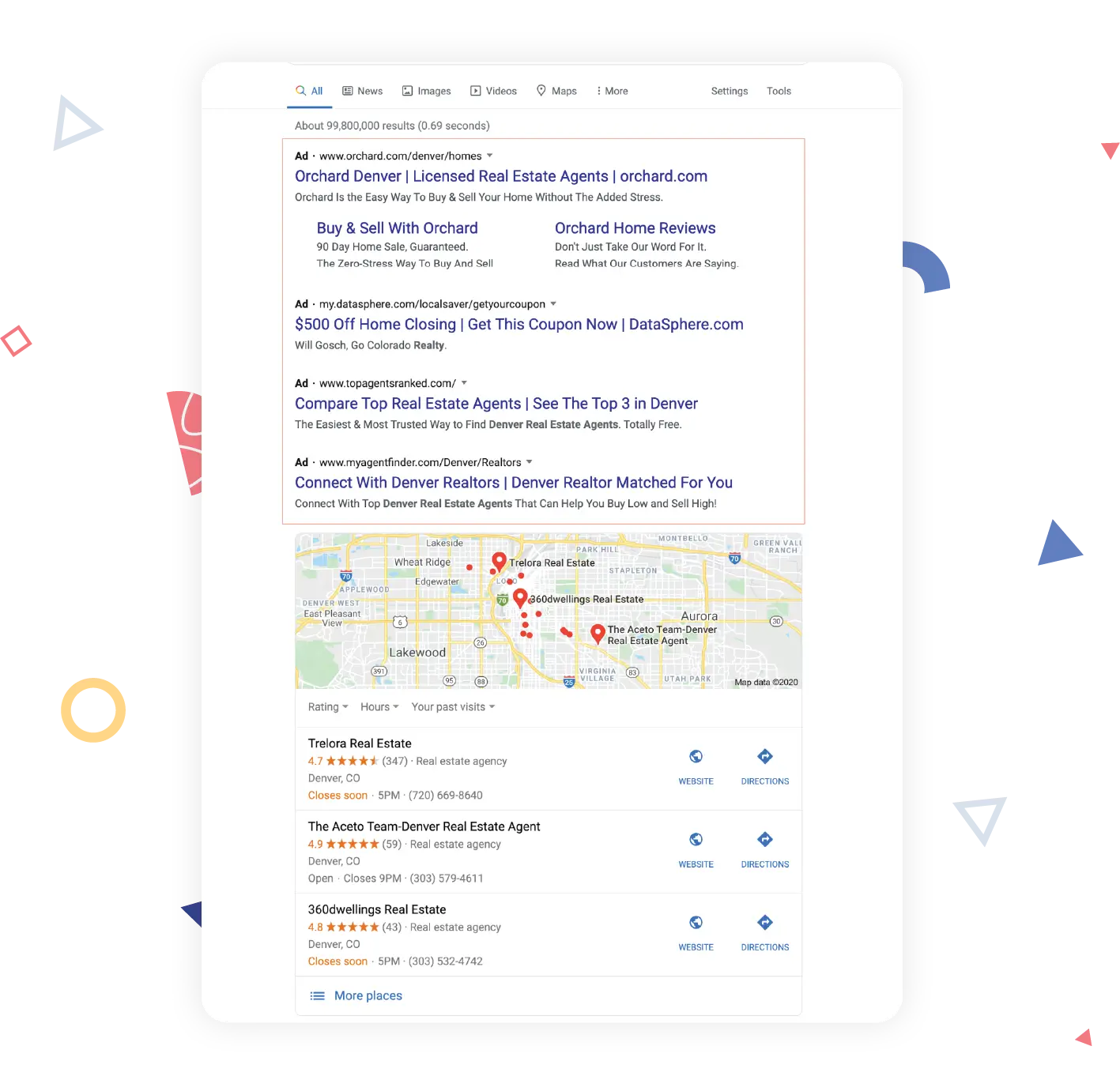
Google Ads also allows you to place your ads on participating, relevant websites. They will appear in the formats that the site owner allows, and website visitors can then click through to your own website. This service is known as Google’s ad display network.
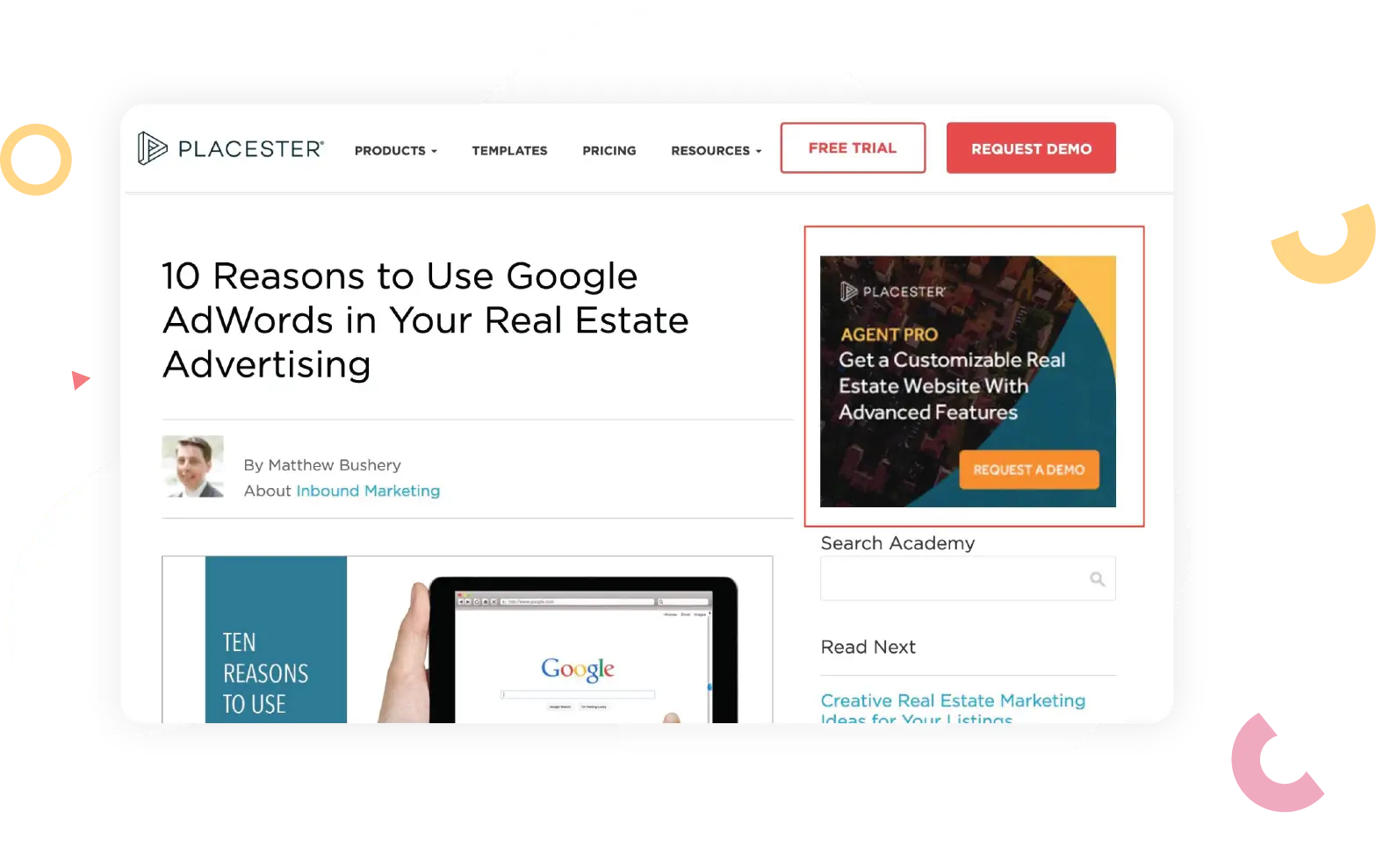
Is it worth adding Google Ads to your lead-generation arsenal? Be aware that click-through rates aren’t all that high for ads; the average click-through rate for Google Ads (across all industries) is 1.91% on the search network and 0.35% on the display network. For real estate, the results are better, though: 3.71% for the search network and 1.08% for the display network. So if you know what keywords to target, Google Ads might be a solid part of your lead generation strategy.

Featured snippets
Google will populate certain search results (usually those in which the searcher seems to be looking for the answer to a question) with a featured snippet, a chunk of text that Google has deemed useful and therefore features at the top of the search results.
In real estate, you’re most likely to see featured snippets for keywords and phrases such as “how to save for a down payment,” for example.
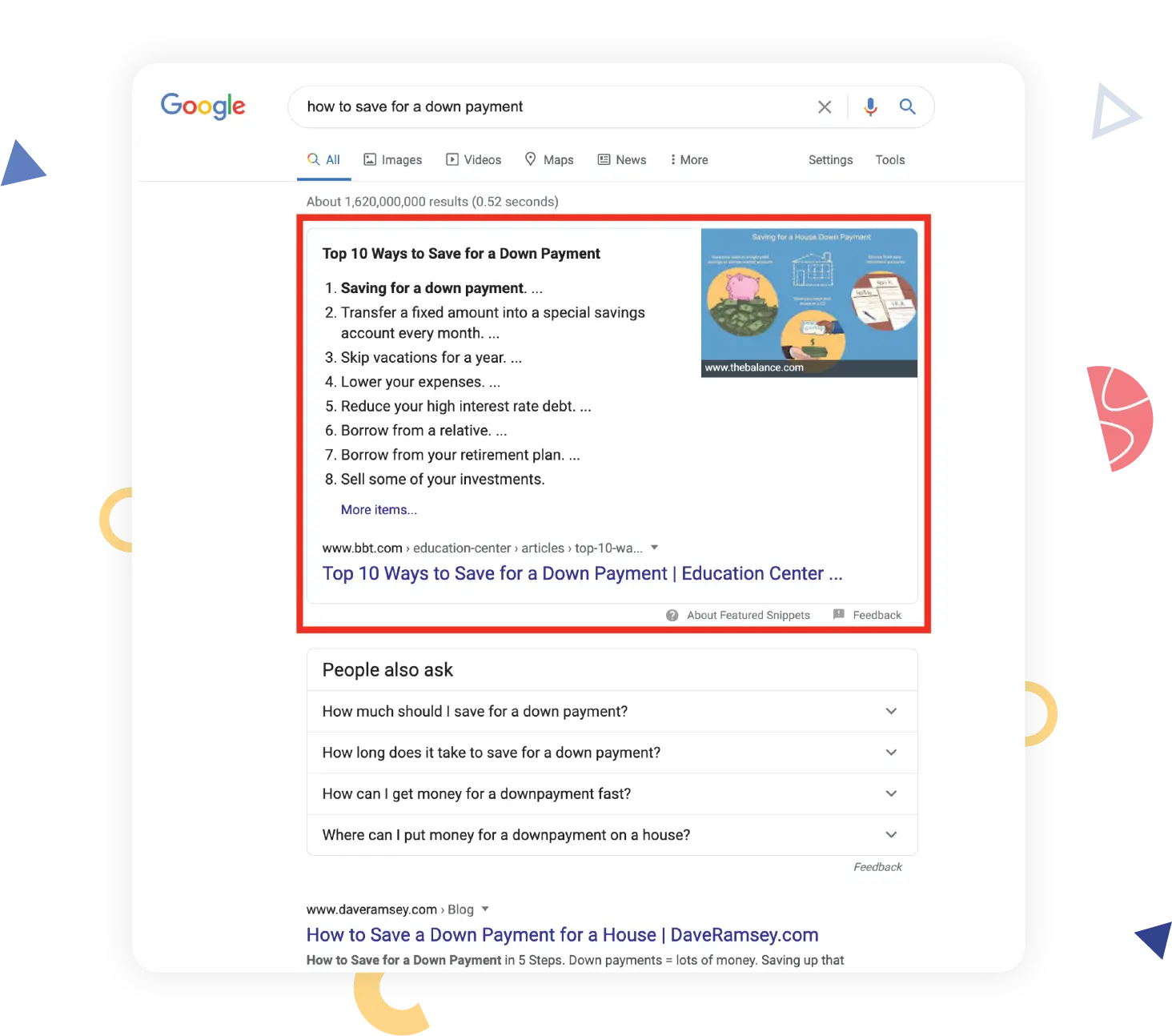
Getting your own text snippet featured on Google is as easy (and difficult) as creating answers to questions that are better than anything else Google can find online.
Map results
Another type of search result (and one that can often show up above organic results on Google) is map results. Google produces these results most frequently when the searcher is looking for a place (such as a business—including a real estate brokerage).
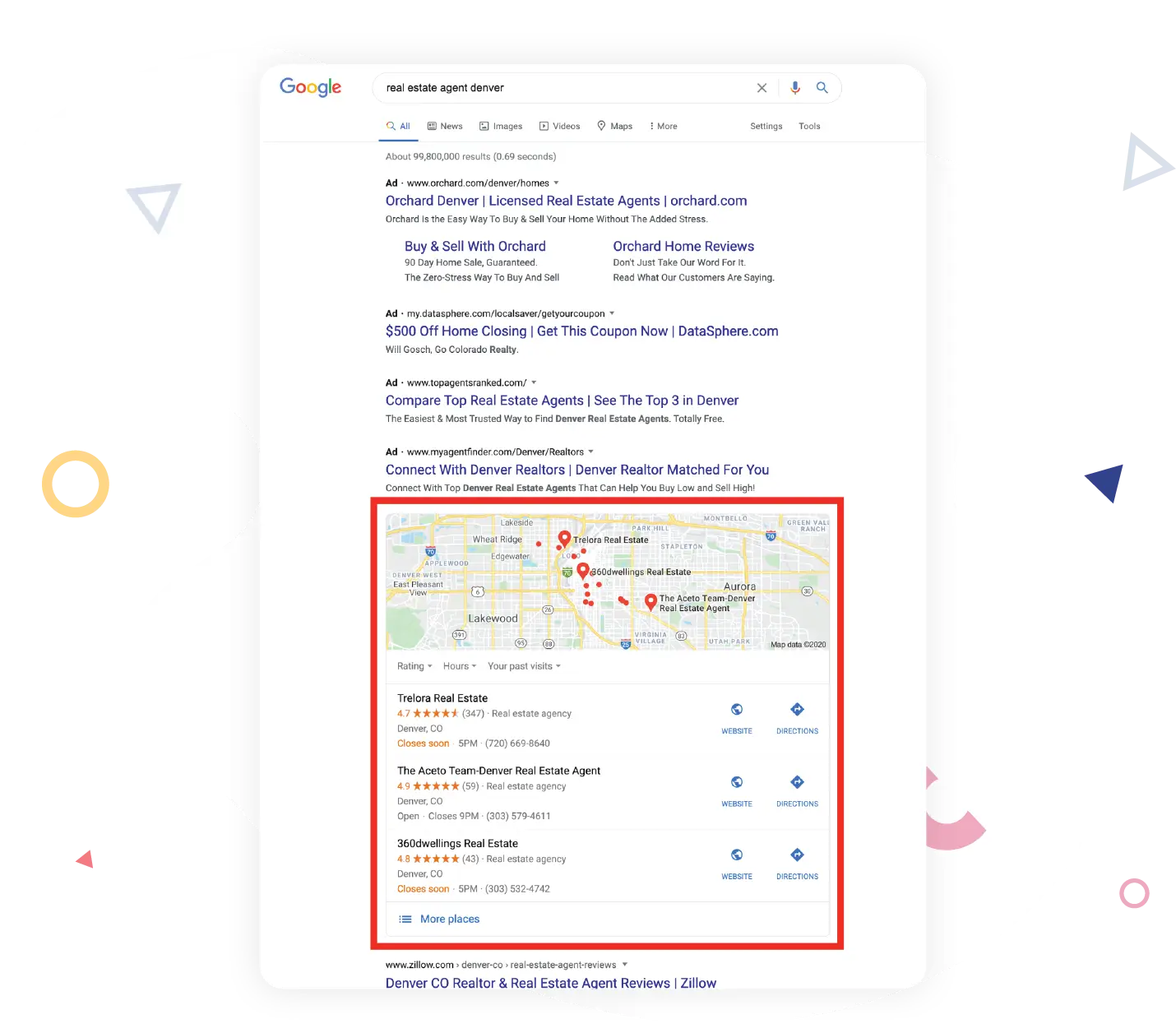
To rank in Google’s map search, you have to make sure that your name, address, phone number (NAP) and website profile are all filled out consistently everywhere, including (especially!) on Google.
Organic search results
This type of search result is what most people think of when they start thinking about SEO. In the early days of search engines, when users looked up a keyword or a key phrase, they’d get a list of links to click, ideally with the best results (links) toward the top of the page.
You don’t have to pay Google any money to rank in organic search results, but it’s not easy. The search engine has become increasingly sophisticated with every algorithm update, and today, it prioritizes websites with the best content and user results.
Another thing to note about organic search results is that, depending on the search term, you’ll find them in different places on the page. Sometimes organic search results are still the first thing you see; sometimes they’re superseded by sponsored results or ads, maps results, or snippets.
In a search for “how to save for a down payment,” organic results are shown after the featured snippet and “people also ask” features on the page.
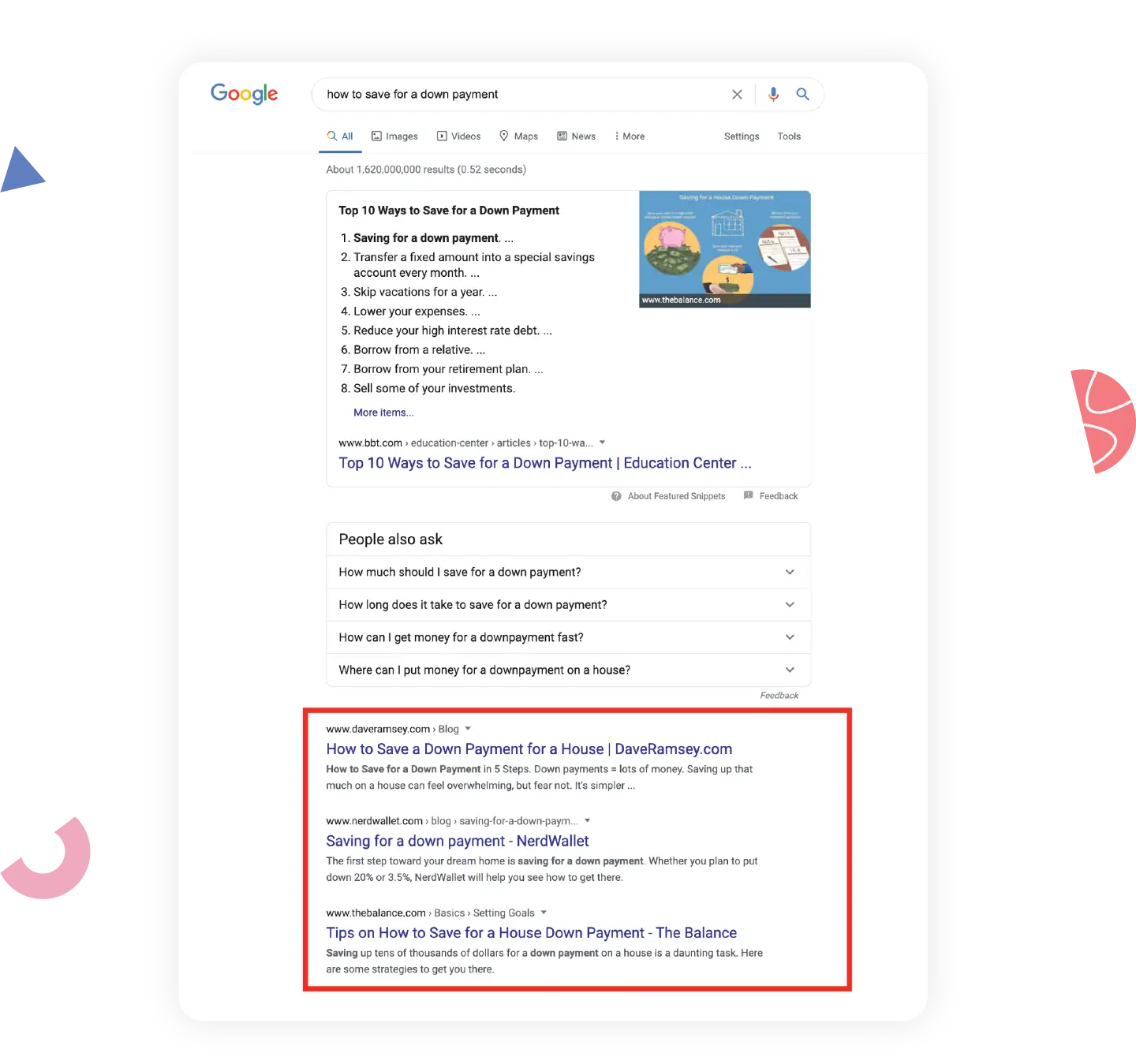
Mobile vs desktop searches
Put yourself in a buyer’s shoes for a moment and think about how they might search for information about a home if they’re standing right in front of it, looking at the “for sale” sign, versus how they’ll look for those details from a laptop in their own living rooms. The search terms are going to be a little bit different, and the buyer’s behavior once they complete the search is likely to be different, too.
Mobile searches have been gaining in popularity over the past few years, capturing up to 60% of organic search visits, but their popularity also seemed to be stabilizing throughout 2019.

Ranking at the top of Google’s search results is not easy, but the benefits are real. Real estate agents who are serious about using SEO as a business strategy have to understand which types of search results and keywords to target (for which types of searches) if they want to compete with big brands in this space.
Love/hate relationships: The reasons search engines might like (or dislike) your website
Now that you’ve got a sense of why it’s important to rank well in Google’s SERPs, let’s dig into what the search giant adores—and what it despises. Nobody has clear, transparent insight into Google’s search algorithms, but we do have a general sense of what Google prioritizes and what it de-prioritizes when it comes to search results.
Google likes
Google employs search quality raters, people who evaluate pages according to both page quality and “needs met.” You can view the detailed instructions that the search giant gives these raters, but mostly what you need to know is that your pages are going to be evaluated according to both their quality and how well they are able to meet a searcher’s needs.
Searcher satisfaction
Another way to think about searcher satisfaction is: Did you provide the reader with what they were hoping to find when they typed in that keyword and your website surfaced?
The more you can give searchers what they want and reduce the friction and frustration they might feel due to things like page load times, ease of website navigation, or simply the quality of the content on your website, the higher Google will rank your pages. The search engine notices how long searchers stay on your site and how quickly they abandon it, and it adjusts search rankings accordingly.
We know that Google considers your domain’s authority, the page’s level of detail and how comprehensive it is, link data, content data, and performance data to help assess searcher satisfaction. There’s a lot you can do on your page to help searchers find it and to make sure their experience on your website is positive.
Mobile optimization
A joint study from the National Association of REALTORS® and Google in 2013 found that 89% of new home shoppers use a mobile device to search at some point during the process; that percentage is likely to be even higher in 2021.
Google’s mobile-first indexing means that Google has been parsing mobile and desktop search data separately, but it uses both sets of data to determine both mobile and desktop rankings. In other words, if your website performs well on a desktop but is a misery to load on an iPhone, then your rankings on both mobile and desktop Google searches are going to suffer.
The good news is that there’s a very easy way to see if Google considers your website to be mobile-friendly—Google itself will tell you. Go to the Mobile-Friendly Test page and type in your website URL. If everything looks good, you should see this message:
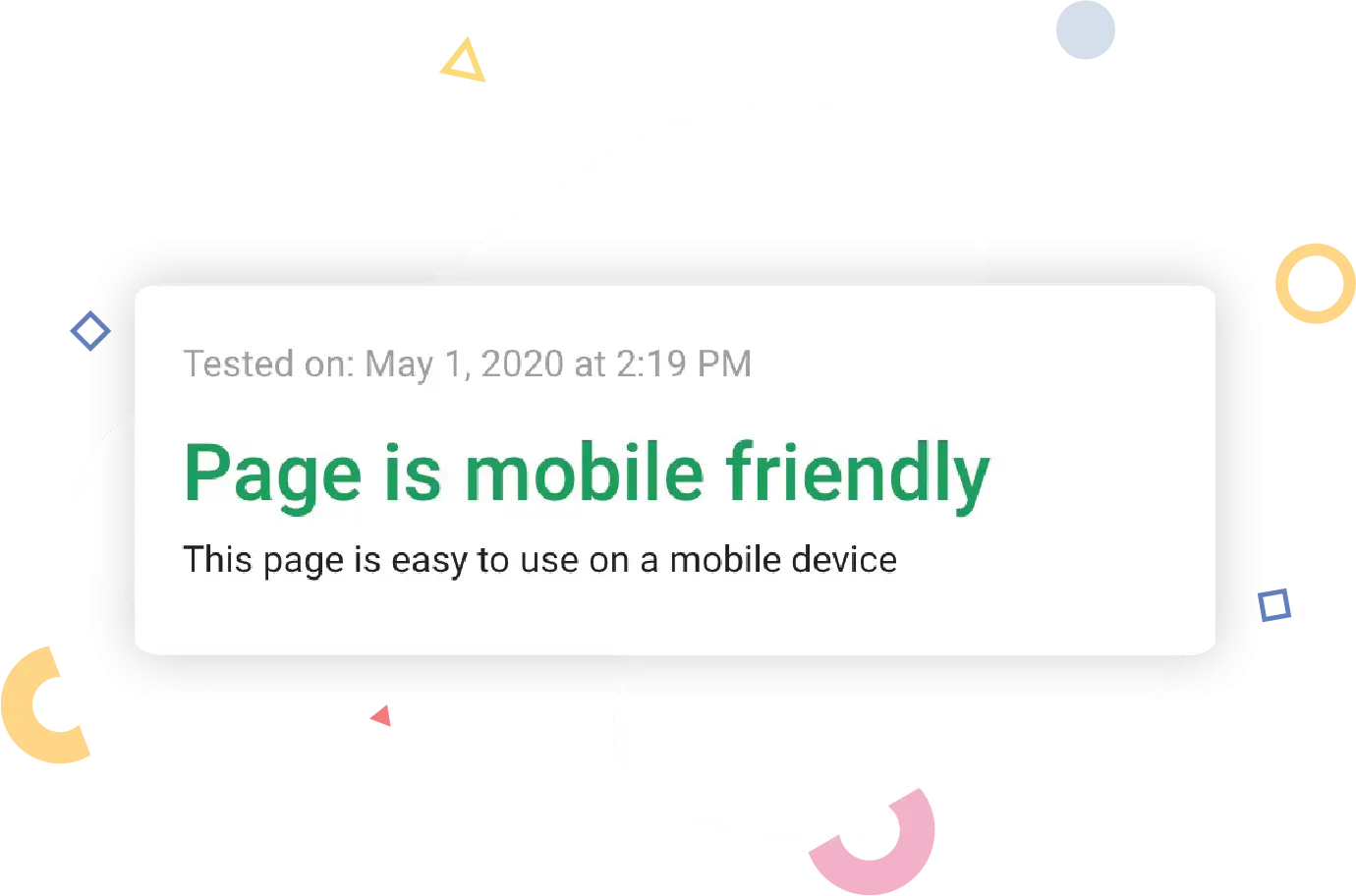
If not, Google will tell you what’s wrong, and you’ll be able to share this information with your website provider or your own technical support team.
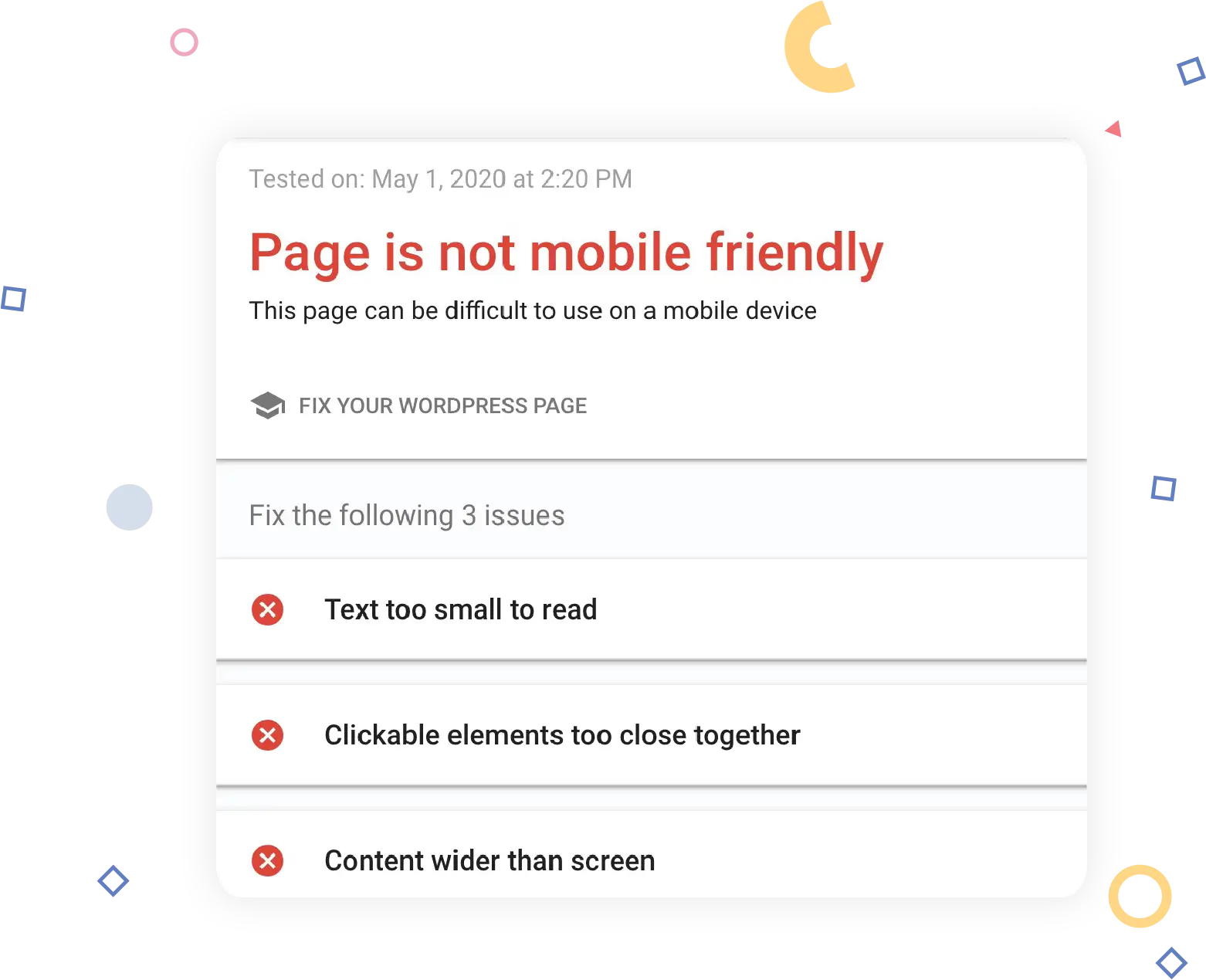
As the website’s owner, you can also access a mobile usability report and other resources after you test your website’s mobile optimization.
Page load speed
What happens when you try to load a page and it takes what feels like forever? Some users are patient enough to stick around, but most of us don’t bother waiting for results, and that can really hurt your website’s search rankings. After all, if a page frustrates the majority of searchers who find it, why would Google recommend it to new searchers?
When it comes to page load speed, seconds are critical. The longer it takes your page to load, the less likely you are to convert a visitor to a lead, according to research.
Just like with mobile optimization, Google offers its own tools to help you assess your page load speed. Type your URL into the PageSpeed Insights field and then use what Google tells you to help your site load faster.

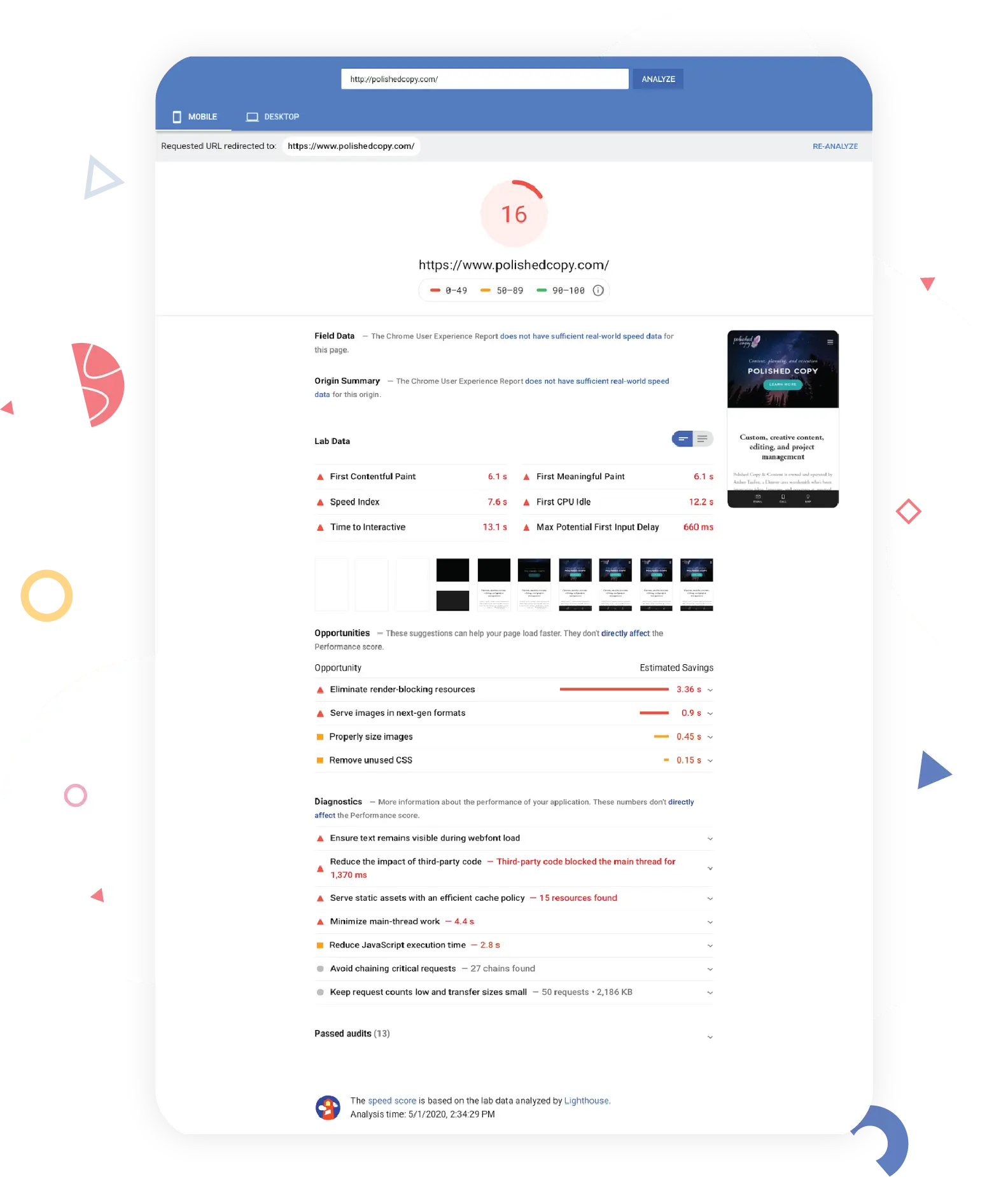
On-page optimization
Optimizing your website pages involves two steps. First, you must identify the words and phrases that you want to target. Ideally, you will have a different word or phrase for each page of your website, and those words and phrases should be relevant to your audience. (We’ll cover keyword research later.)
In the early days of search engines, website builders would “optimize” pages by “stuffing” the keywords everywhere they possibly could. Google’s algorithms have become much more intelligent since those days; they can now identify (and penalize) this keyword-stuffing behavior. Optimizing a page for Google today is more nuanced and involves:
- Writing a compelling headline
- Creating a click-worthy meta description
- Assigning the appropriate URLs
- Thinking about featured snippets in your introduction
- Targeting keywords intelligently in subheads, copy, and links
- Using rich snippets
- Optimizing images
- Mixing up content type
Compelling headlines
We’ve all experienced the email subject line that sends the missive directly to trash, the book covers that are entirely forgettable, or the hilarious-looking headline on social media that leads to a pop-up hellscape of a website.
For marketers, the scenario is even more dire.
You can spend countless hours creating the best resource available online for buyers, sellers, and homeowners, but if you slap on a title or headline as an afterthought, this heedless behavior will kill your click and conversion rates. Even if your page makes it to the first page of Google rankings for the topic because the content is amazing, most of the people who see the headline will scroll right past it. Talk about a waste of effort!
There are a number of formulas you can use to create headlines (and really, it’s best not to stick to just one). The CoSchedule Headline Analyzer uses a simple algorithm to grade your headline. Headlines that get high grades typically:
- Follow a formula that converts (for example, how-to or list-based headlines)
- Use a mix of common, uncommon, emotional, and “power” words
- Are the right length—not too short but still digestible
The Advanced Marketing Institute also offers a free headline analyzer that specifically assesses the emotional marketing value of your headline.
Let’s say you want to create a post about selling a house fast in a specific market. The keyword you’re targeting is “sell my house fast denver.” Some headlines you might consider could include:
- How To Sell Your House In Denver (In Less Than 24 Hours)
- 15 Steps To Selling Your House In Denver—Fast
- Can You Sell Your House In Denver In A Day? Yes! Here’s How
- The Secret To Selling Your House In Denver In Just One Day
- The Quickest And Easiest Way To Sell Your House In Denver
If we plug the first one into CoSchedule and the Advanced Marketing Institute, we can see where it’s weak and find ways to improve the headline.
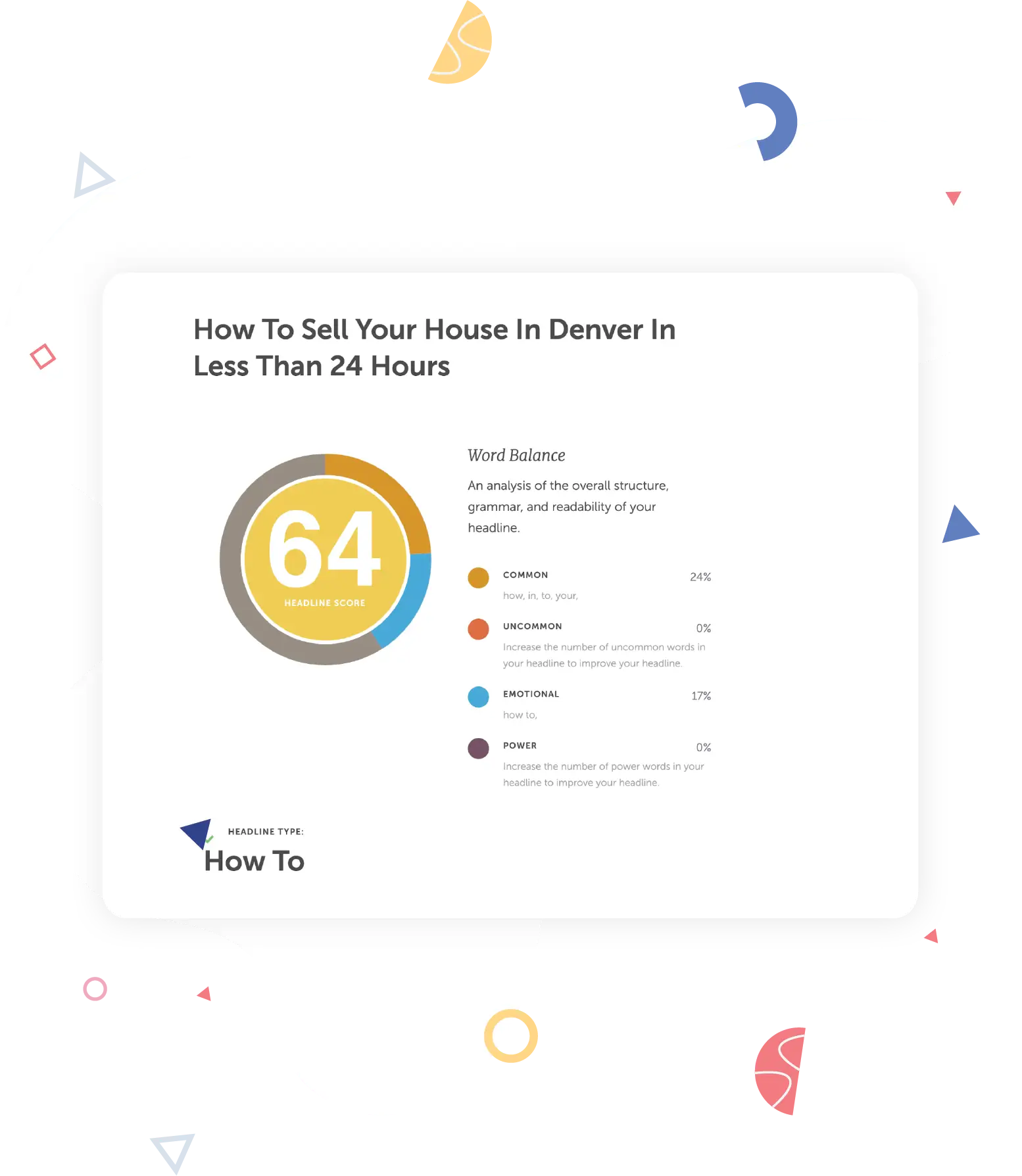
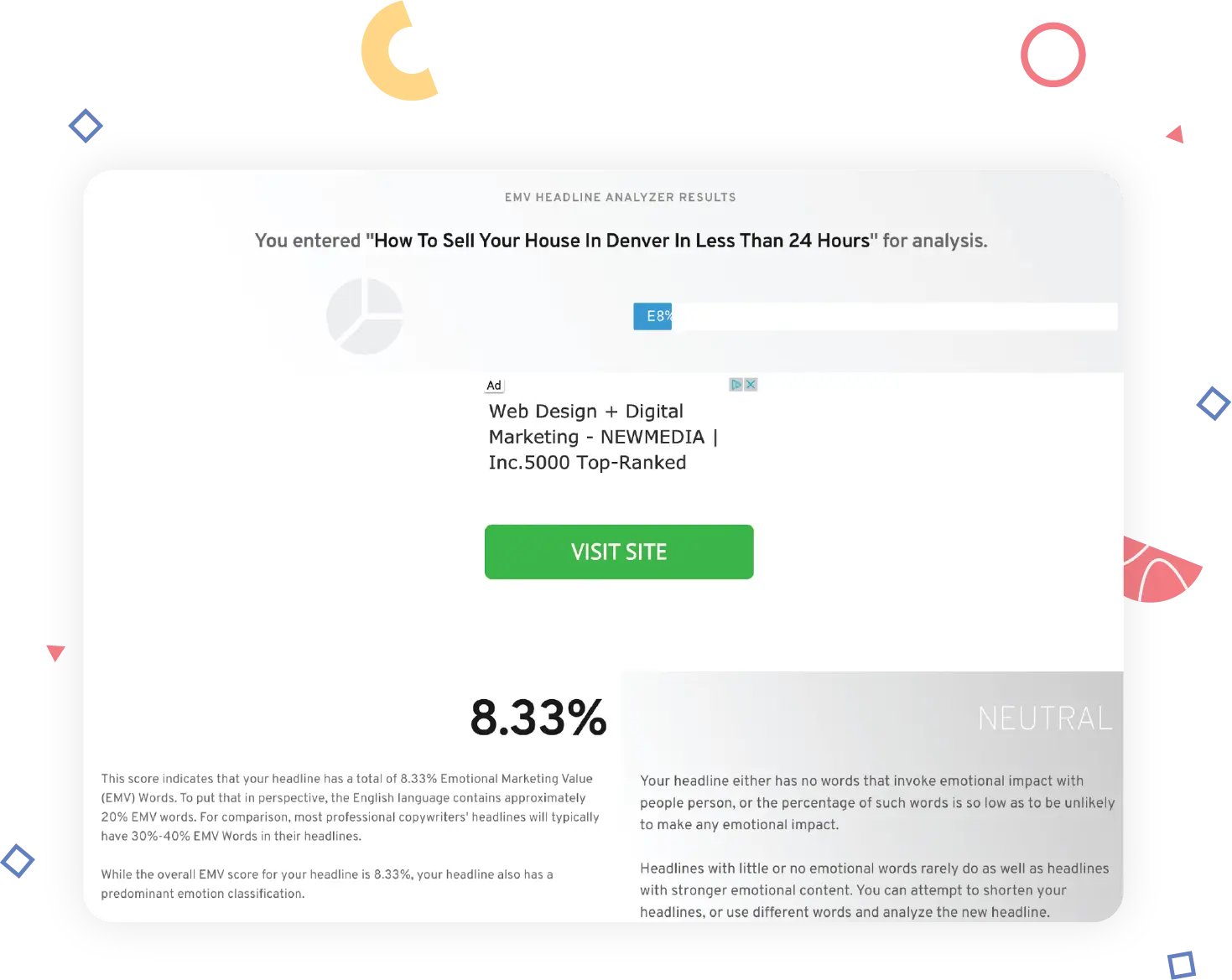
Both CoSchedule and the Advanced Marketing Institute analyzers show that tweaking a couple of words in this headline can make a big difference to its emotional appeal. If we keep the “how to” structure and the general headline sentiment, but change the wording to “How To Instantly Sell Your House In Denver (For Top Dollar)” …
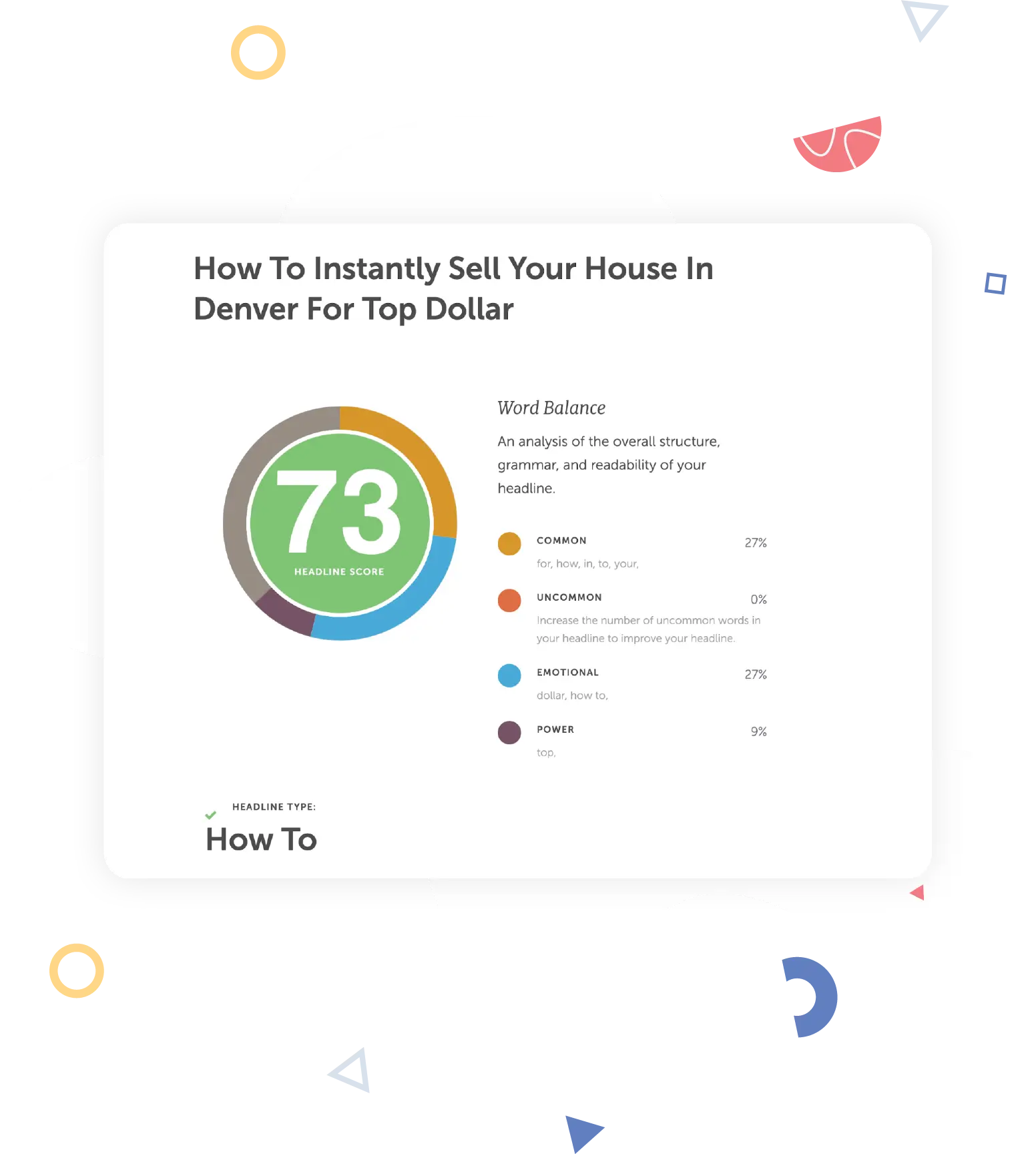
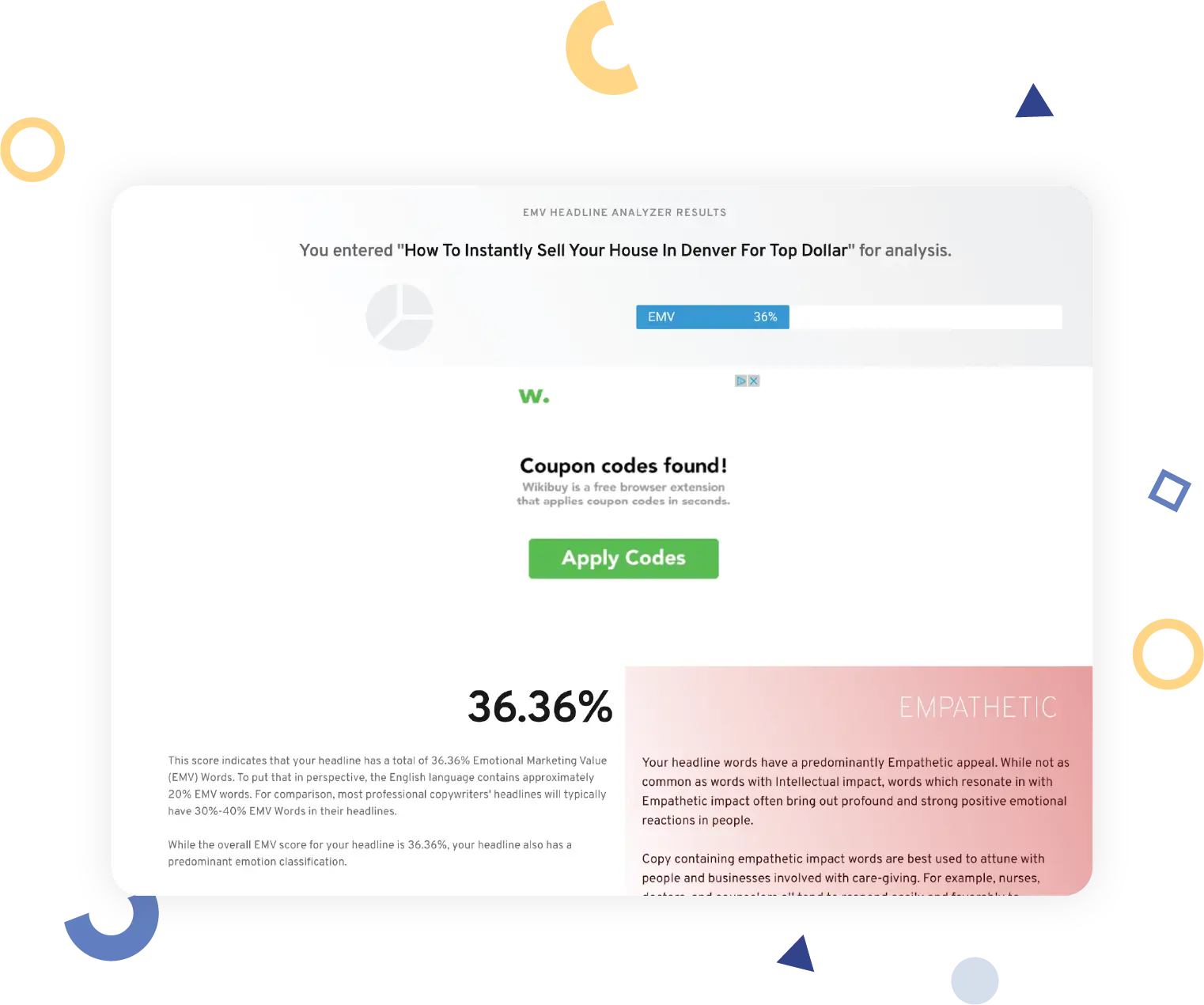
According to the Advanced Marketing Institute, professional copywriters’ headlines usually rank between 30% and 40% for emotional marketing value (EMV) words. This score of 36.36% is therefore pretty respectable!
Writing a click-worthy meta description
The meta description is a short description (about 160 characters at the time of this guide’s writing) that appears underneath the headline and page URL in Google’s search results. It’s just long enough to fit a sentence or two of description about what searchers will find on the page and how it might (or might not) meet their search needs.
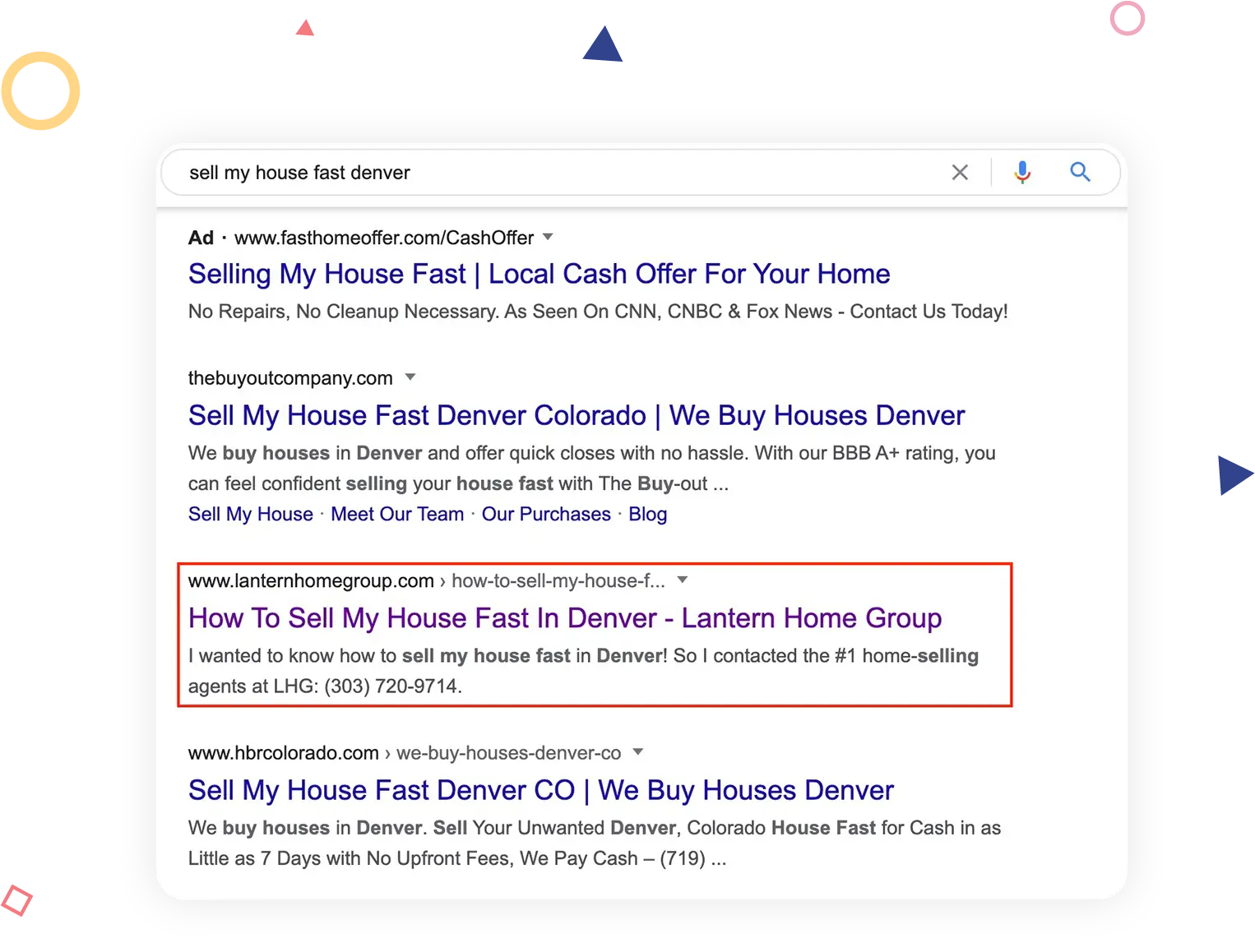
That’s not a lot of real estate (pun intended) to make your point. A good meta description will always include:
- The keyword you are targeting
- A reference to the searcher’s problem
- A promise to solve it
For our “sell my house fast Denver” keyword, a click-worthy meta description might read:
You’ve decided: “It’s time to sell my house fast in Denver.” But how can you make sure you still get the best price? Our guide will explain everything.
Easy-to-read, sensible, short URL
Real estate brokerage Lantern Home Group in Denver ranks on the first page of Google for our “sell my house fast Denver” experimental phrase; it’s the second organic result. On top of providing a ton of tips for sellers who are hoping for a fast sale, Lantern Home Group was also smart about the URL chosen for this page-keyword combination.

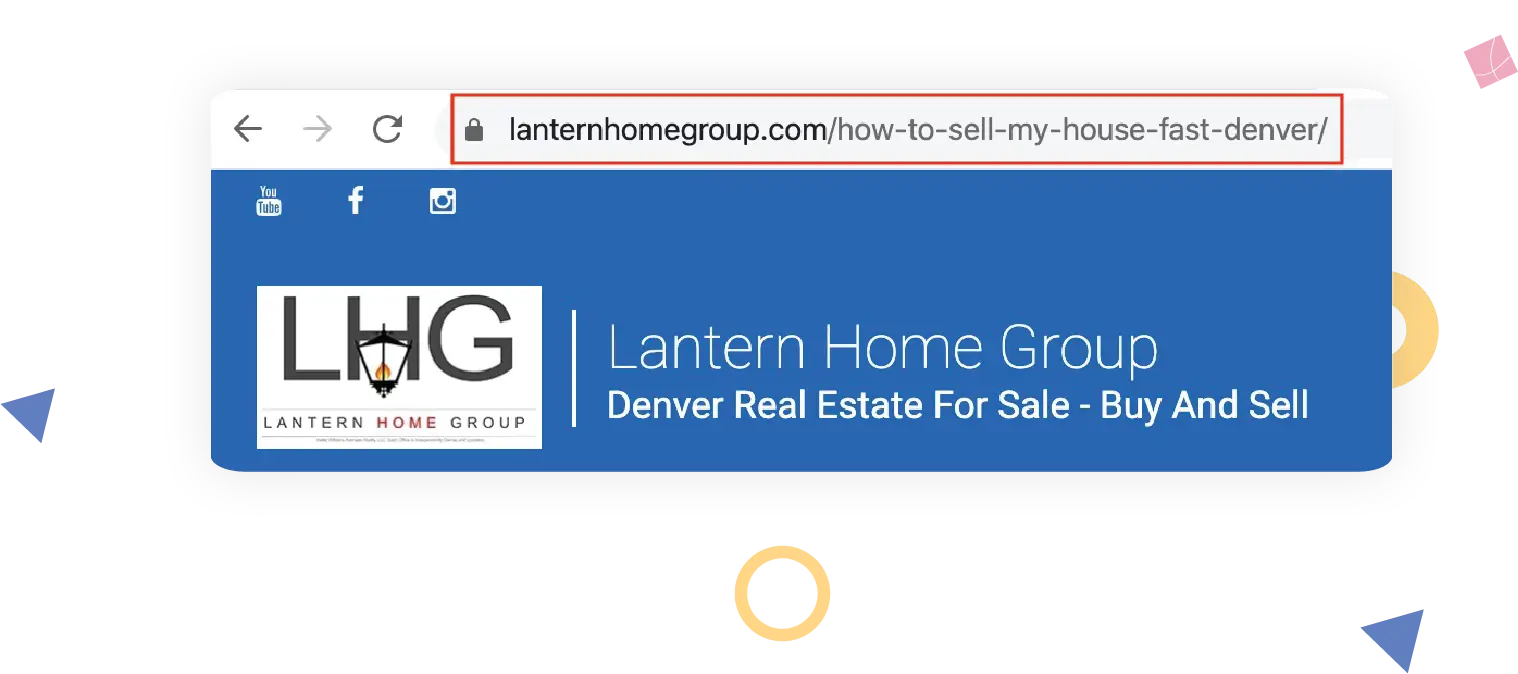
Introduction optimized for featured snippets
Featured snippets are most common for informational searches, where the reader is looking for an answer to a specific question or more detailed information around a topic. It’s not clear exactly how Google chooses the featured snippets, but it seems apparent that focusing on the search intent and trying to answer the searcher’s questions is the best way to get your content in the featured snippet.
A student newspaper at the University of Colorado currently populates the featured snippet for this search on “boulder homeownership programs”:
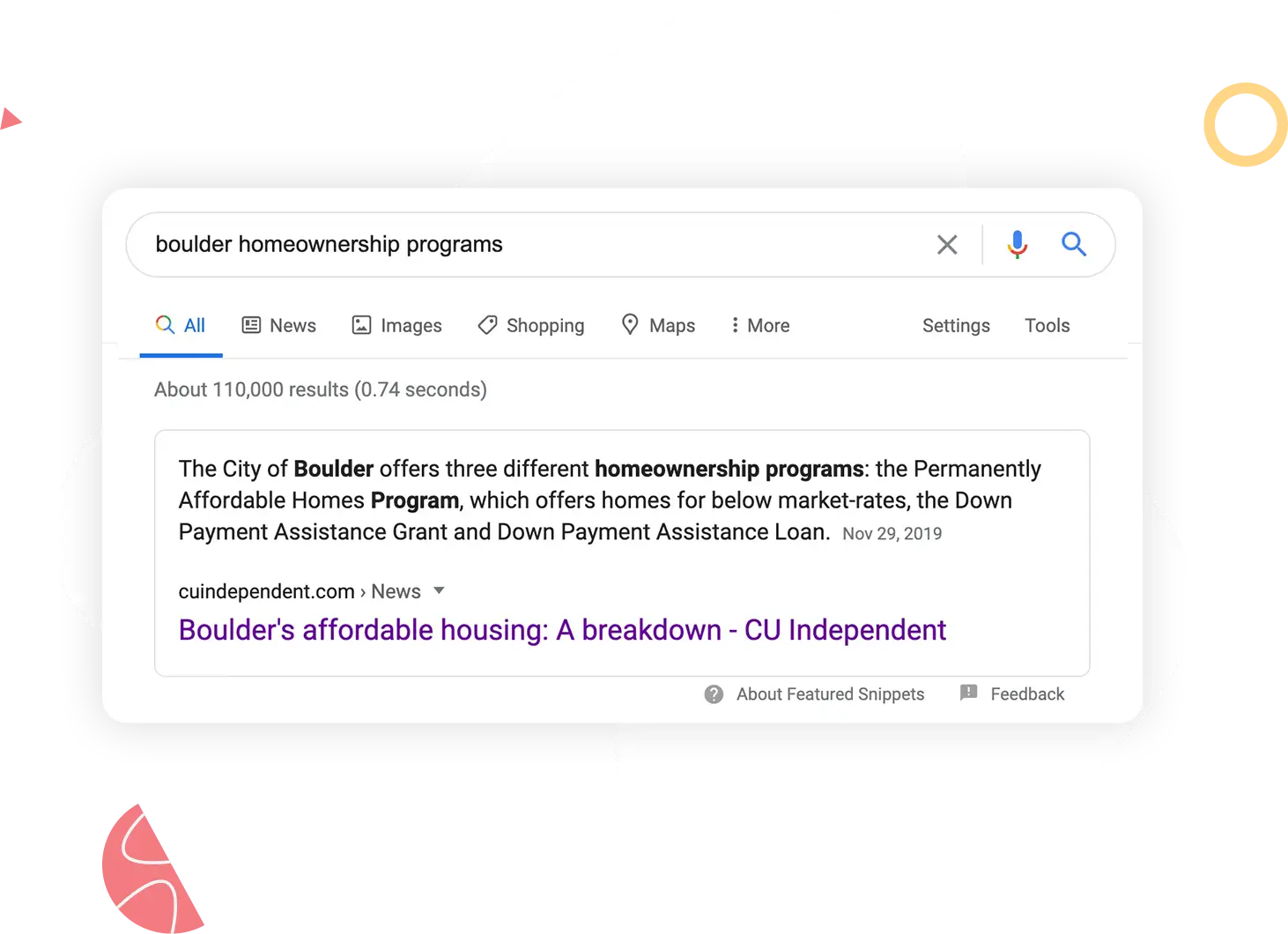
Intelligent keyword optimization
This is not the same thing as keyword-stuffing. We’ve mentioned using the keyword strategically in the headline and meta description, but Google will also look for your keyword in the first paragraph of your page copy, throughout the page content, and in internal link anchors to the page. (In other words, once you’ve published your guide on how to save up for a down payment in your area, you’ll want to link to it when you refer to down payments on other parts of your website.)
Use appropriate rich snippet options
A rich snippet is an additional piece of information that you can give to Google for display in search results. This is done through your website’s structured data in the page’s HTML. You add the information to your page and use structured markups (or schema) to show Google the rich snippet data and details.
Some examples of rich snippets that might be pertinent or relevant to real estate could include organization rich snippets, star rating rich snippets, or events (for example, for open houses).
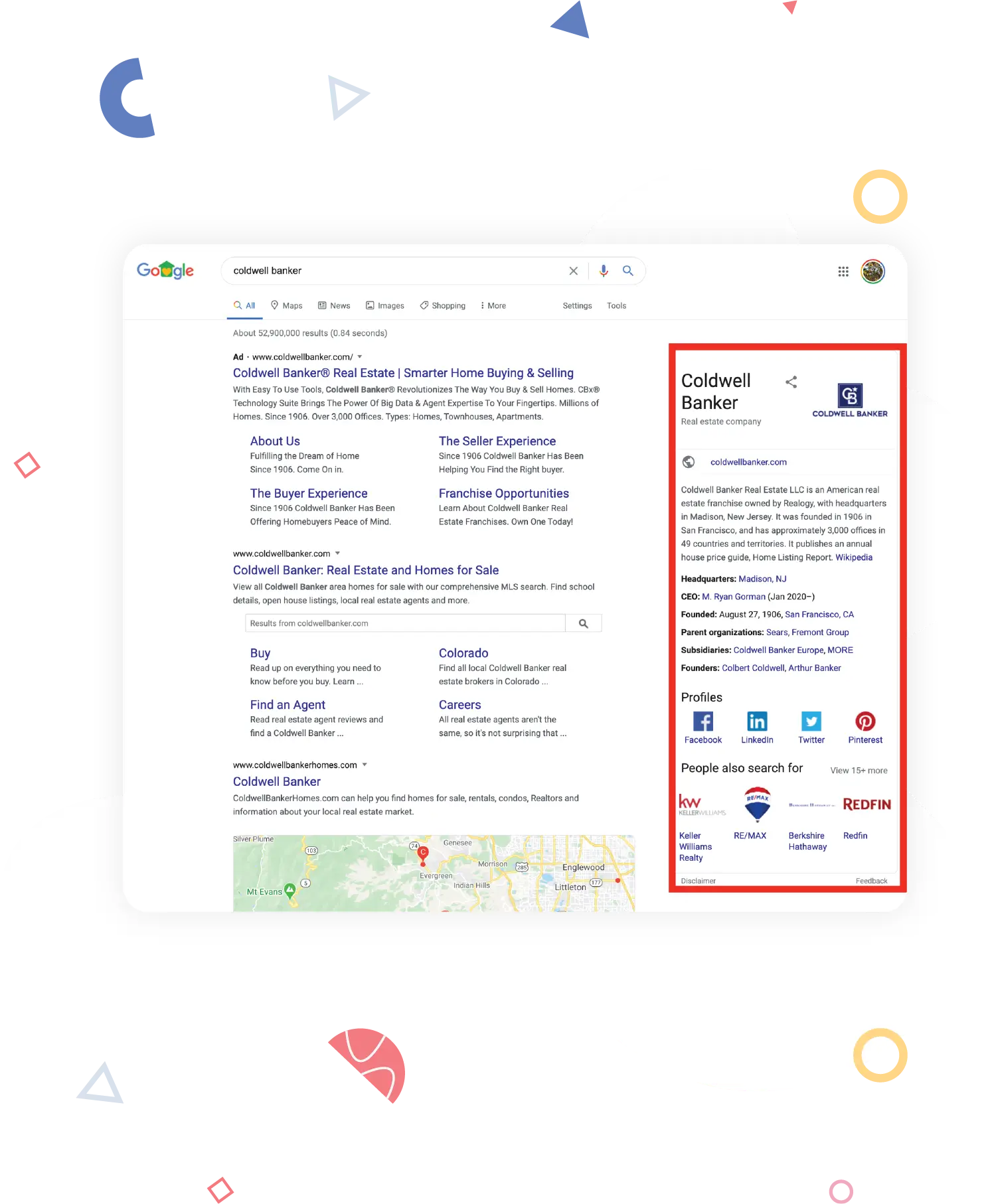
Optimizing images
Google’s algorithm doesn’t just crawl the copy and code on the page; it also “looks” at the images (or, at least, the image file names, alt attributes and tags, captions, and domain storage details). A study of on-page SEO found that the most common issues by far were image-related, more than all other types of issues combined.

High-quality, attractive, intensely local images are a great way for real estate agents to boost their page rankings if they also make sure those images are appropriately optimized. This means the images should include:
- Descriptive, keyword-rich file names
- Descriptive, keyword-rich alt attributes or alt tags
- Appropriate caption text
It’s easy to upload image after image to your website without paying attention to those image attributes, but you’re losing a ton of potential traffic when you do. The more descriptive you can be (and the more closely you can adhere to your keyword), the higher Google will rank your images.
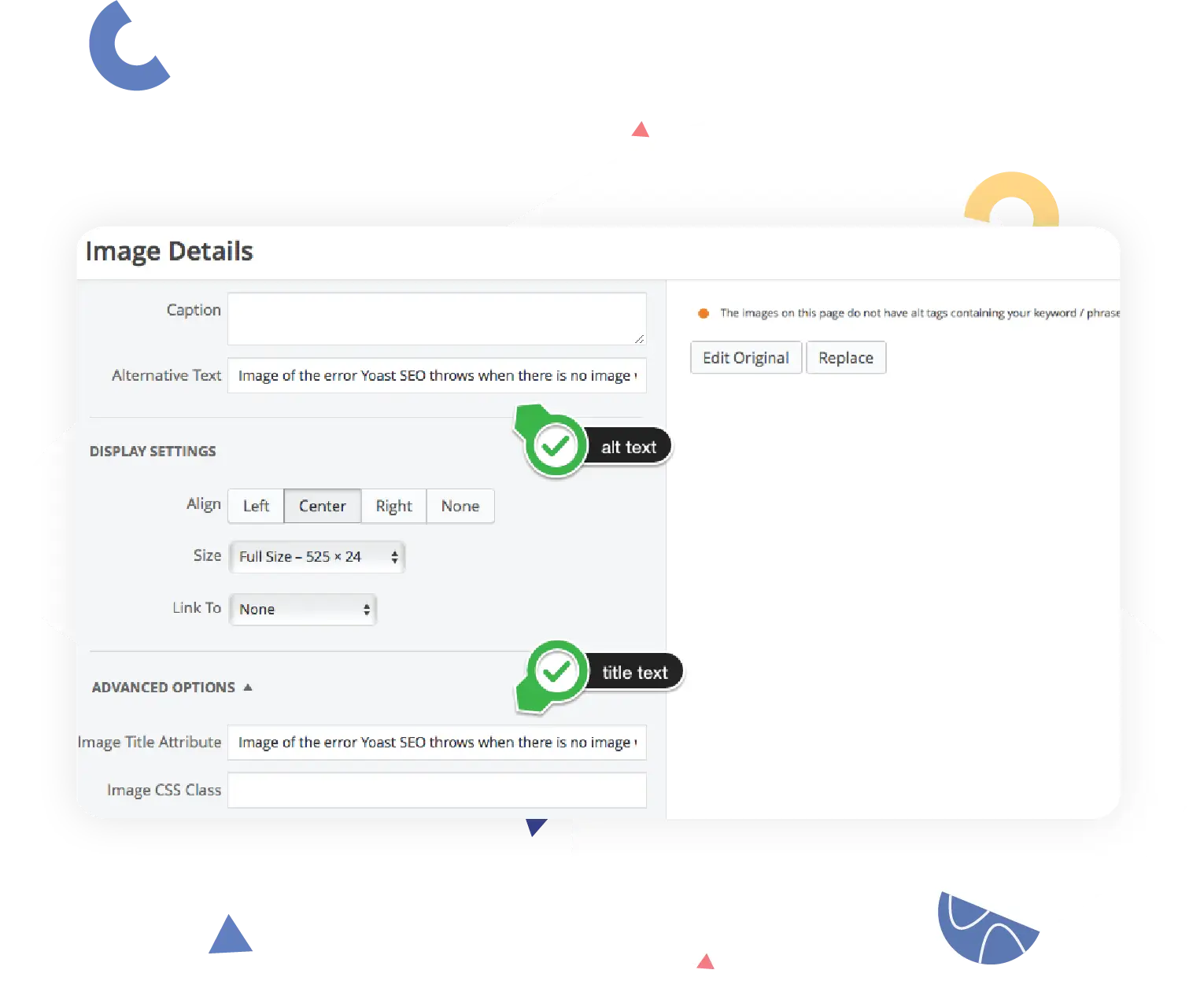
For example: On a neighborhood page where you’ve included images of restaurants, recreational facilities, public transportation, and other local amenities, all of those images should include the neighborhood’s name and a clear description of whatever appears in the image. A neighborhood page about Denver’s LoDo (Lower Downtown) area, targeting the keyword “lodo condos Denver” might include an image of Union Station with the caption, description, and alternative text: “Union Station is a transportation hub near many developments of LoDo condos in Denver.”

Mixing up content types
How do you feel when you land on a page that’s one massive wall of text? It’s more than a little daunting, right?
We use the internet to answer questions about the world, but we expect those answers to come in better packaging than the standard school textbook. That’s why you’ll want to intersperse the text on your page with images, graphics, videos, charts, or other visual elements that will help the reader understand the topic and break up the monotony of the page.
Infographics can be a good way to provide some visual relief and information in one—plus, they’re insanely shareable. Here’s a good example that a property renovator put together for a post about renovating a property for profit:
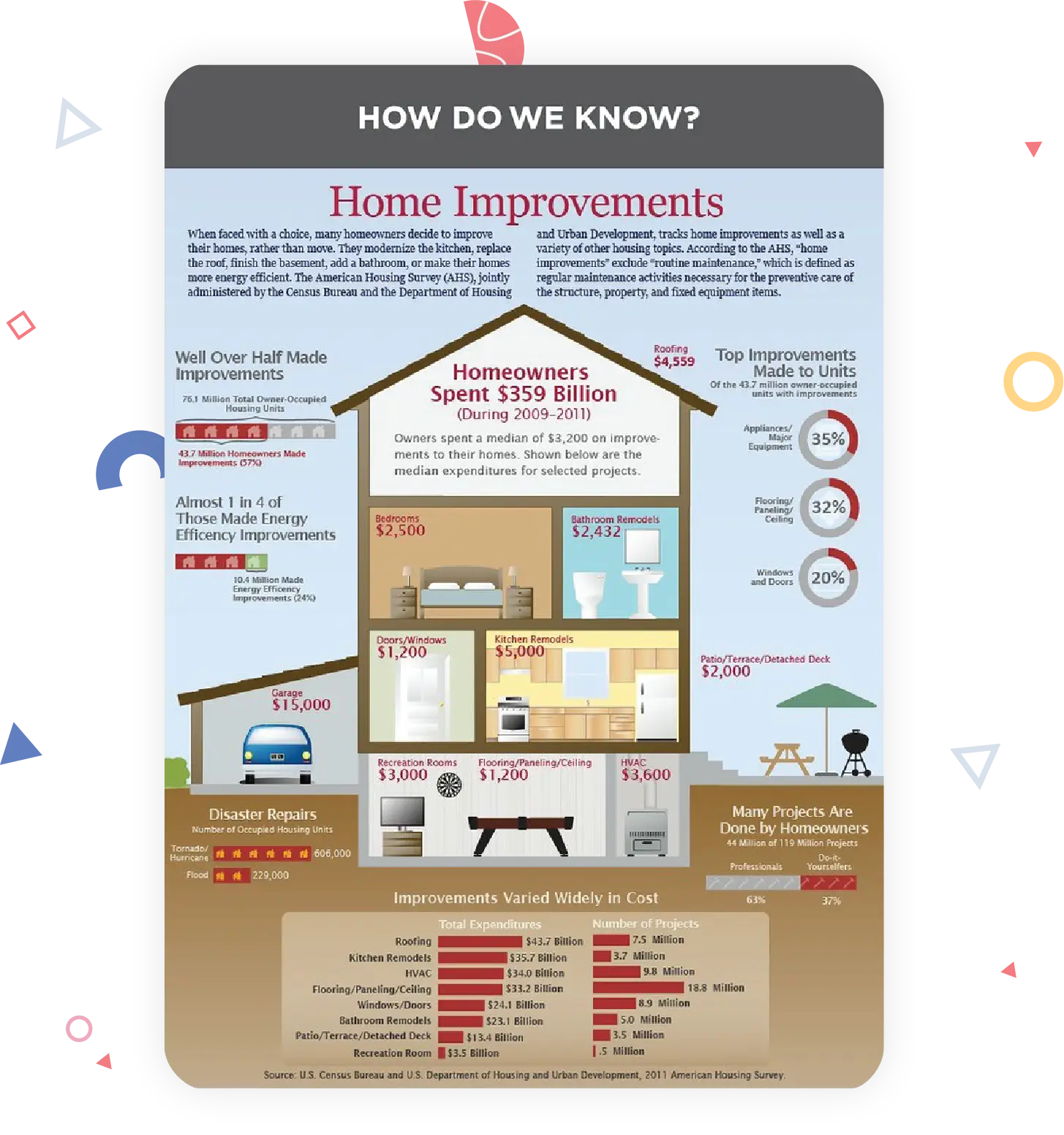
You can also embed video presentations, neighborhood tours, property tours, and other video assets:

In fact, video is an ideal way for real estate businesses in particular to capture attention and keep visitors engaged with their content. Visitors spend significantly more time on pages with videos embedded than on pages with no videos.

According to BoldContent, real estate listings that include videos get 403% more inquiries from buyers than listings without videos, but only 15% of real estate agents are using videos.
You’ve also got an opportunity to rank on Google for your videos if you create a YouTube account and upload them there. YouTube is a Google/Alphabet subsidiary, and you’ll see lots of YouTube results on any Google video search.
Backlinks
Google uses links to your website to determine how reliable your website is. If you’re producing high-quality content, and local websites that Google trusts are linking back to it, this will boost your SERPs because those backlinks are telling Google that these trusted websites trust you.
The best links should contain relevant anchor text (something that pertains directly to your website’s resource—for example, the property address for a listing landing page). And the best links do not include a “nofollow” tag in the HTML.
Links from powerful, authoritative websites are high-value because these are trustworthy sources. Google looks at the diversity of domains linking back to you, the rate of backlink growth, and the editorial nature of the backlinks, among other factors, to assess backlinks.
Are links still important to Google? Prioritizing backlinks was one of the algorithm quirks that propelled Google ahead of Yahoo! in terms of search engine popularity, but in the years since Google became the dominant search engine, it’s natural to wonder whether the algorithm still looks at backlinks (or looks at them quite as hard as it used to).
The short answer is that yes, Google still cares a lot about backlinks. Although the algorithm has added dozens of new metrics to determine SERPs, backlinks have remained about as important as they have always been to the search engine. In this Spearman correlation study, we can see that links are a significant ranking factor for Google (correlation scores above 0.20 suggest the existence of a relationship; links as a ranking factor score 0.293).
Google dislikes
Keyword stuffing
If putting your keyword in the headline, meta description, introduction, and content copy is a good SEO practice, then wouldn’t including more keywords be even better?
That’s a strategy known as keyword-stuffing … and no, it doesn’t work like that. Today’s search engines are not only intelligent enough to prioritize websites that satisfy searchers, but they also understand basic language structure and semantic relationships between words. The last time keyword-stuffing worked well for SEO was well over a decade ago.
Here are some common keyword-stuffing tactics that you should avoid:
- Adding irrelevant keywords: Keep each page on your website as focused on the target keyword as possible. Don’t add a ton of irrelevant or broad keywords with the hopes of ranking higher on Google because it won’t work. (For example, you shouldn’t stuff your neighborhood guide pages with “buy house in My Town” keywords.)
- Including too many keywords: Include keywords where it makes sense, but you don’t need to repeat the same keyword (or similar ones) several times in the same sentence or paragraph. Consider the difference between these two sentences:
– “Learn more about real estate trends in Massachusetts, eastern Massachusetts, and the Greater Boston area from the real estate trends experts in Boston, the North Shore, and Cape Cod.”
– “Learn more about Massachusetts real estate trends from experts in the Greater Boston area.” - Keyword cloaking or invisible text: Another once-popular “black hat” SEO tactic involves “hiding” keywords on a page—for example, by making the text the same color as the page background. Users can’t read the text, but search engines can still pick it up. It seems like it could work, but it doesn’t, and your site’s SERPs will get dinged if you try it.
Instead of trying to game the system, focus on including keywords within the appropriate context in a thoughtful way.
Link lists or directories
Given Google’s affinity for backlinks, it may seem like a good idea to create a page on your website that’s a single long list of keywords that you’re targeting, with links to the pages supporting those keywords. But a page like that isn’t actually useful to searchers, and given what we know about how much Google prizes searcher satisfaction, a link directory is going to backfire.
Instead, it’s much better to incorporate internal links throughout the site with thoughtful anchor text that points to a relevant blog post or landing page on your website.
Like keyword-stuffing, once upon a time, getting listed on a link farm was a decent way to boost your search rankings. That was a long time ago, though; screenshots of link farms include Windows XP browsers. (Microsoft hasn’t supported Windows XP since 2014.) When Google’s algorithm shifted, websites using this tactic were penalized.

Bait-and-switch content
Everyone who’s searched the internet has had this experience, or a similar one: You’re looking for information about the best place to take someone on a date in your city, and you find a website that’s a list of links about restaurantsC in the area. So you click on the link for the best French restaurants in town … and it takes you to another list of links.
Is that a happy search experience, or a frustrating one?
There are two lessons here: First, don’t make your website visitors click all over your site to find what they’re seeking. If you’ve made a resource that provides timely, relevant information for buyers, sellers, or homeowners, make it easy for them to find! Don’t send them on a wild goose chase just to earn some more clicks and links.
Content that promises something but doesn’t deliver it might get a lot of clicks, but the time that users spend on your website, pages they browse per session, and bounce rates are going to tell Google the truth about the bait-and-switch. The analytics will show that users clicked, rolled their eyes, then closed the tab.
Link buying
Just like influencers can buy followers on Twitter or Instagram, it’s possible to buy backlinks to your content. Or, you might receive an offer from someone to link back to their website in exchange for a payment.
This is never a good idea. Think about what happens when Instagram or Twitter eliminates an influencer’s paid followers; their popularity takes a big hit. The same concept applies to search rankings and Google.
Duplicate content
It might seem like an efficiency to cross-post content on multiple pages—it saves time writing new copy, for example. Although it’s more than okay to use short, commonly used phrases across your site (such as your keywords), you don’t want to cut-and-paste paragraphs of content across multiple pages of your website.
When you do this, Google gets confused. It assumes that there’s potentially no original content between your website pages and decides which single page should rank. In other words, you can only rank once for a piece of content; you can’t copy it onto another page of your website, rearrange it or reorganize it, and hope that Google won’t recognize it as the same content.
Outsourcing localized content
Real estate agents might not feel confident in their writing skills, or they might just be too busy to spend time on tasks like blogging. That makes sense, but working with contractors who don’t understand real estate or your market is probably not the best use of your budget.
The reason is simple: You know your real estate market like the back of your hand. A writer who can only research your local area, market, and industry online can subsequently only offer very basic, surface-level knowledge.
If you are going to work with an outsourced contractor on localized content, be prepared to spend a lot of time with that contractor on the front end, providing the details and context they’ll need to create something useful for searchers. For many agents, it’s more efficient to at least outline the content themselves, or to outsource it to an in-house staff or team member instead of a contractor.
Neglecting the overall real estate marketing plan and not waiting to rank
Remember that ranking on Google is a means to an end, not an end in and of itself. You need to have a wider marketing strategy that SEO is serving, and you also need to understand that this is a long-term strategy; it’s going to take time to rank.
How long? A study by Ahrefs shows that the top-ranked Google result is, on average, just shy of 950 days old.
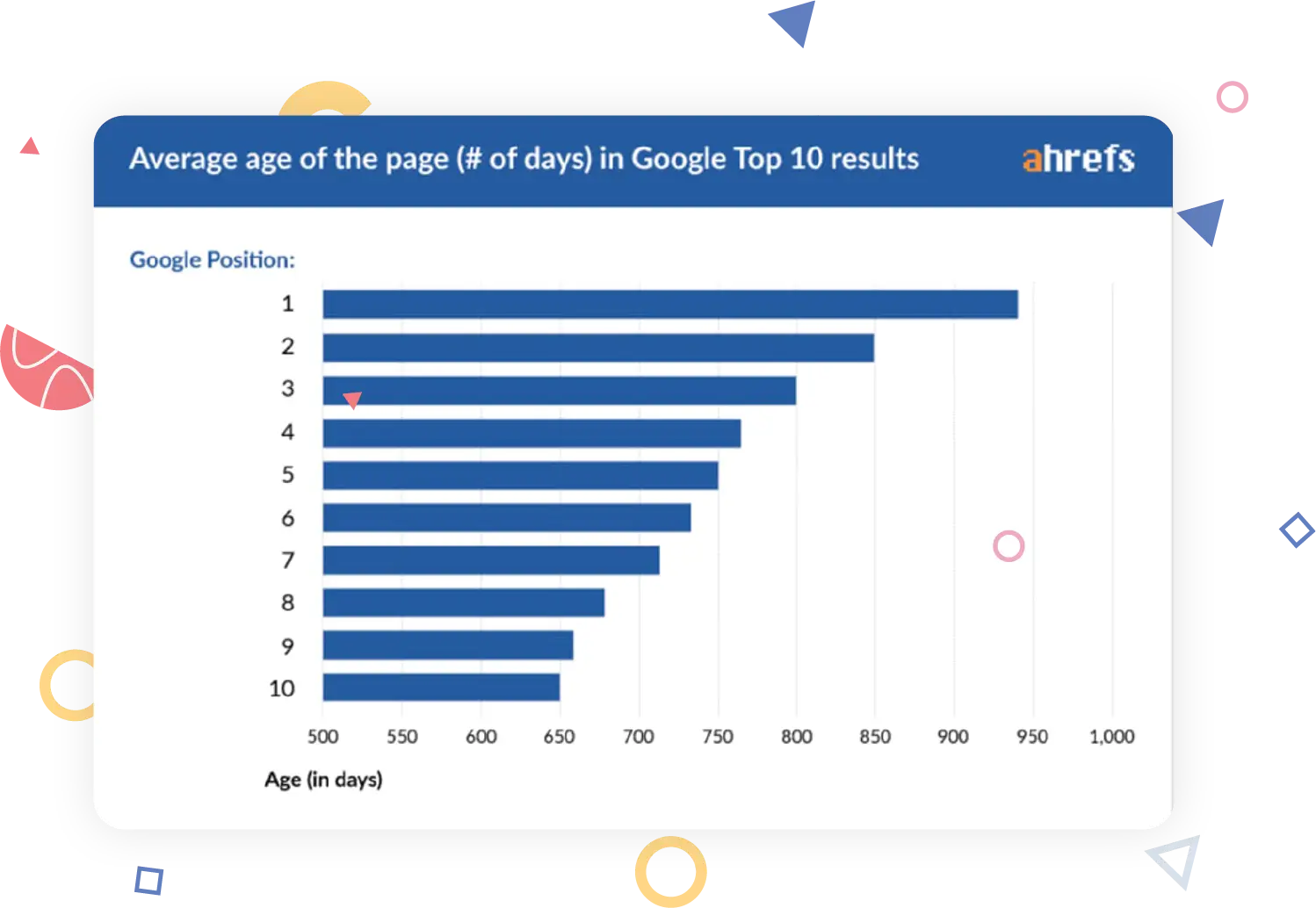
That doesn’t necessarily mean that you’ll have to wait close to three years for your website to hit the top of the Google rankings; these are averages, so some top pages have been live for more than three years, and some for less. But it does mean that you shouldn’t expect to hit the first page of search engine results in one month; it’ll take closer to six months to a year before you start seeing significant results from your SEO efforts.
If you’re wondering what you can do to improve your SEO without taking shortcuts, there is one tactic that won’t steer you wrong: create interesting, informative, helpful content on your site to help educate and entice potential customers. This will not only build a solid foundation for strategic link building, but also help make your brand a trustworthy source for real estate expertise.
Now that we’ve determined what Google likes (and dislikes), let’s dig a little deeper into specific tools and tactics to help you give Google what it wants.
Can your leads find you? Name, address, phone number, website
Given that your clients are starting their real estate search online, it’s important for them to be able to find you online at the most basic level. You need to make your business name, address, phone number, and website (NAP+W) clear and consistent for Google.
That sounds simple (and it is), but many real estate businesses don’t bother to ensure that their basic contact information is accurate, searchable, and consistent. When you do that, you’ll have a chance of ranking in Google’s map results, and you can also include some rich snippet information (such as your business star ratings).
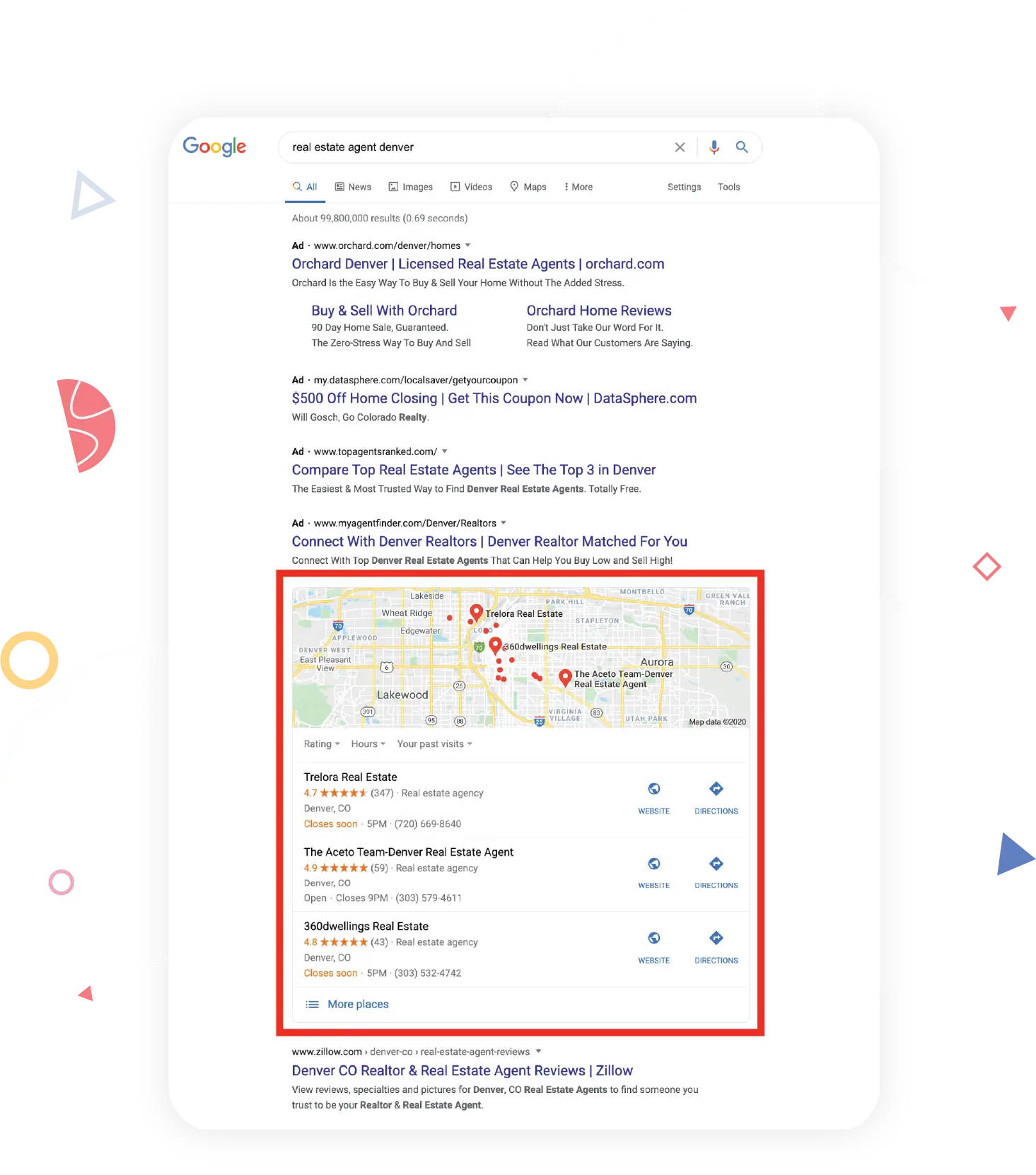
Here’s how to set up your real estate business to show up in these map results.
First, go to google.com/business. Once logged in, fill out the details:
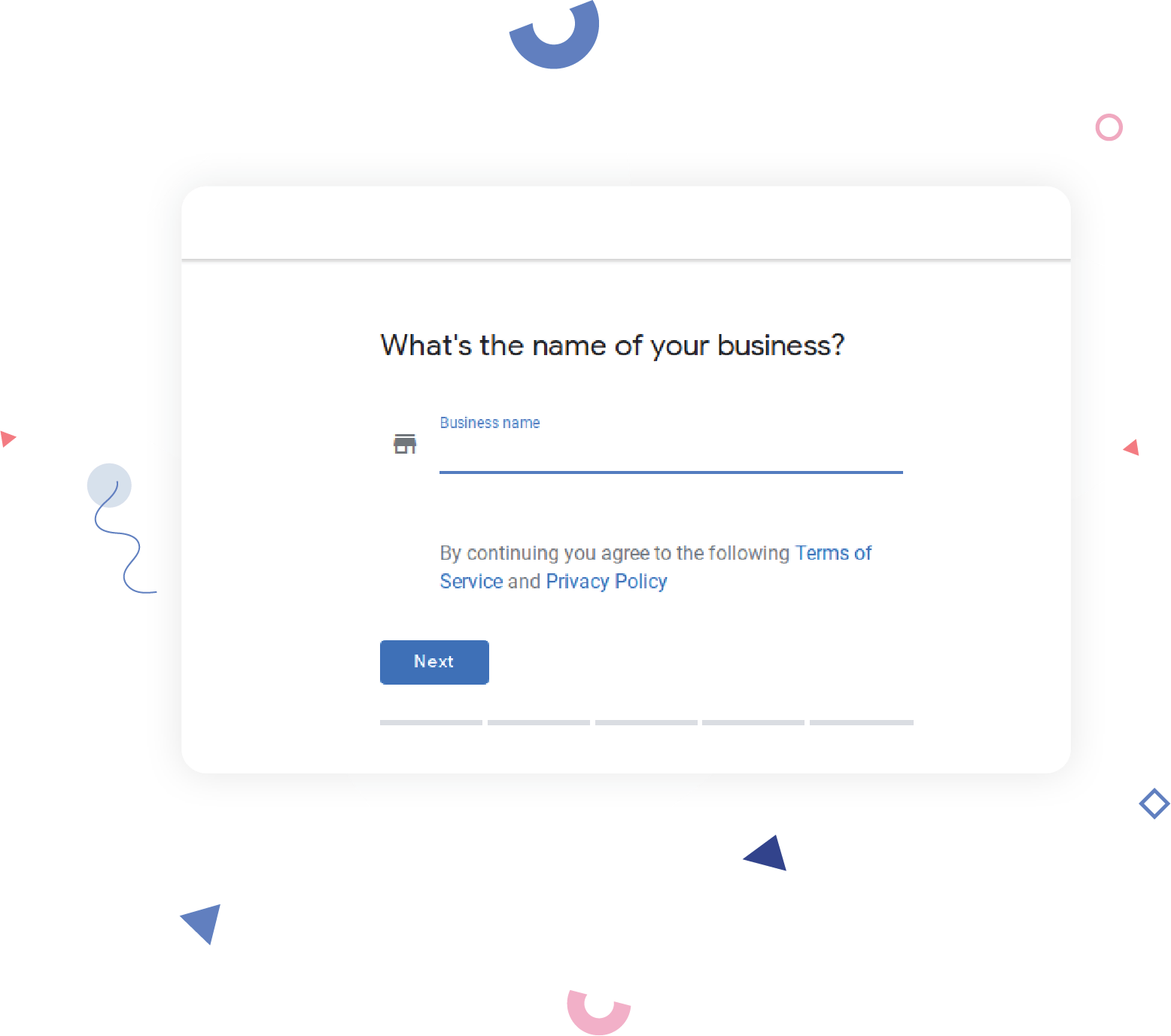
Make sure the profile is 100% complete and up-to-date:
- Exact location on map
- Opening hours
- Website
- Telephone number
- Description
- Photos
- Primary and secondary categories (real estate, commercial real estate, etc)
Your NAP+W details should be consistent between what you enter into Google, what’s visible and available on your website, and what you list on other internet portals and platforms—from Facebook to Yelp to Zillow.
Google ranks a maximum of three results for local searches (like “real estate agent denver” above). Businesses with complete information have the best shot of making it into these results. Formatting the phone number with dashes and parentheses will enable one-click calling from mobile map results:
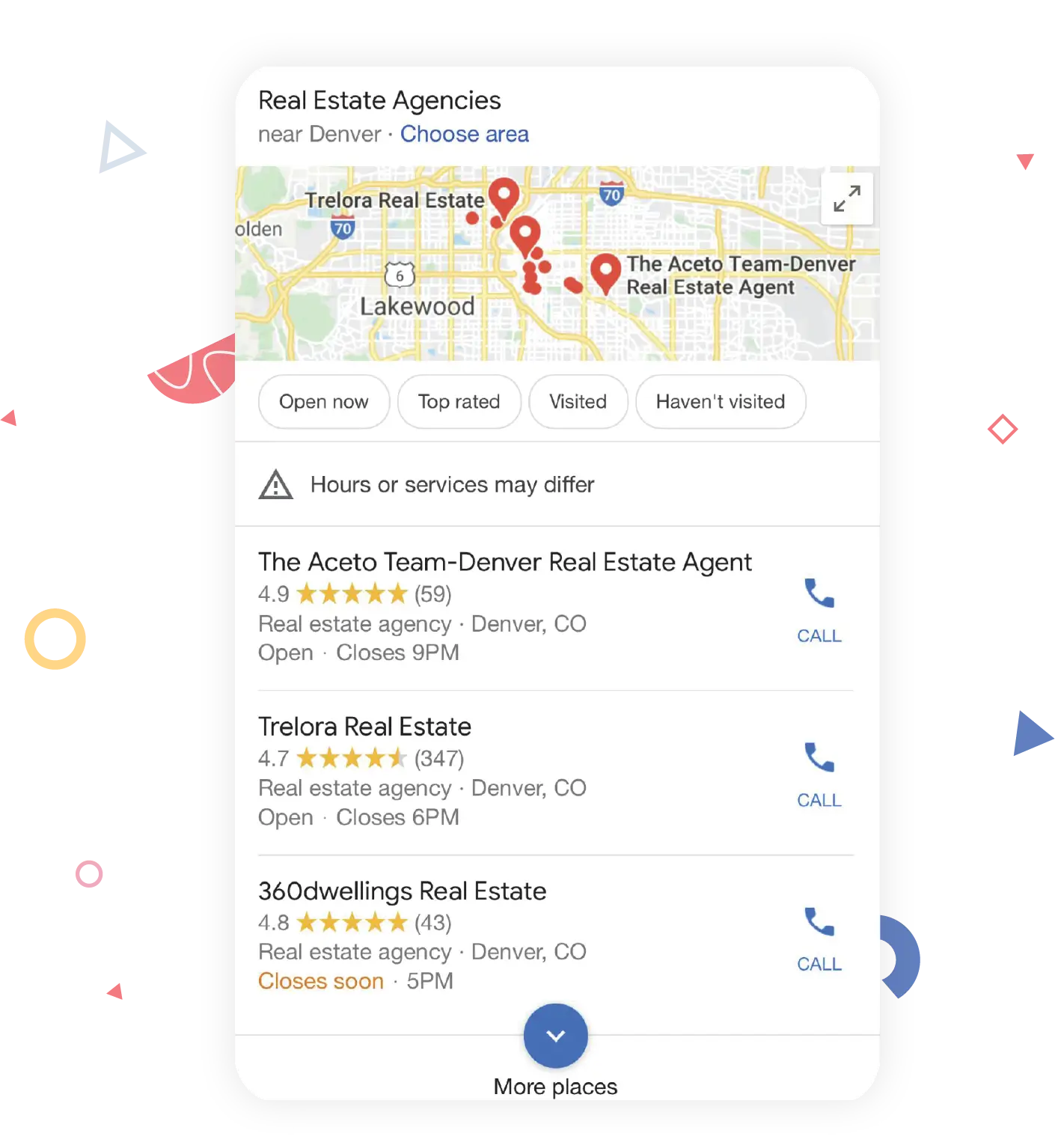
This might seem obvious, but cleaning up your NAP+W is easy to neglect when things change. A ConstantContact survey found that 49% of small business respondents said they had never updated their online business information. When you think about all of the places where online business information can appear, you can see how this might hurt your search rankings.
NAP+W tool: Yext
Tools like Yext can help you identify holes in your NAP+W and push new business listing information out to all major directories.
Yext identifies where your business appears on the web (Facebook page, local directories, and more), where it doesn’t, and how you can optimize existing listing information.
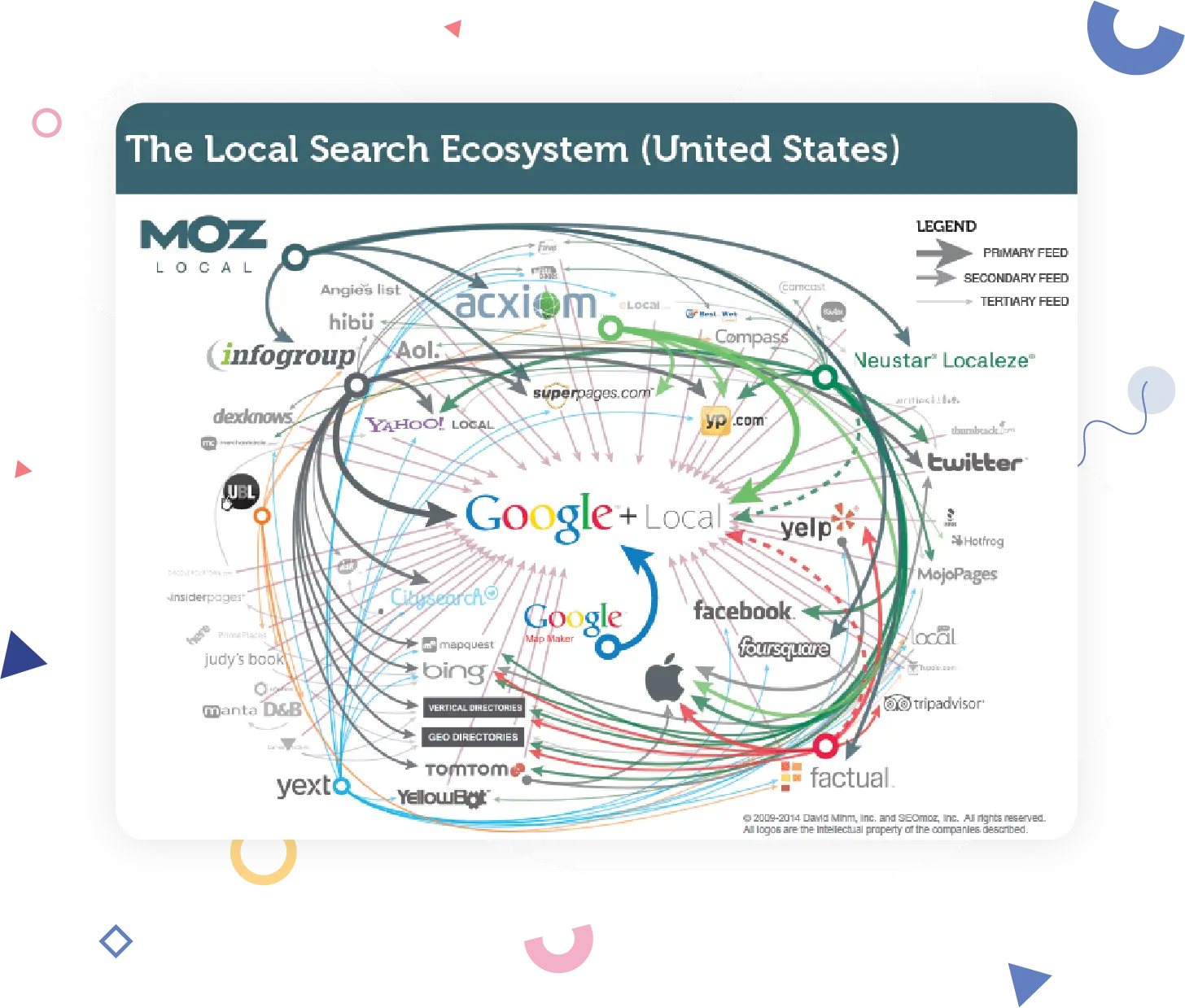
Yext gives you all this information:
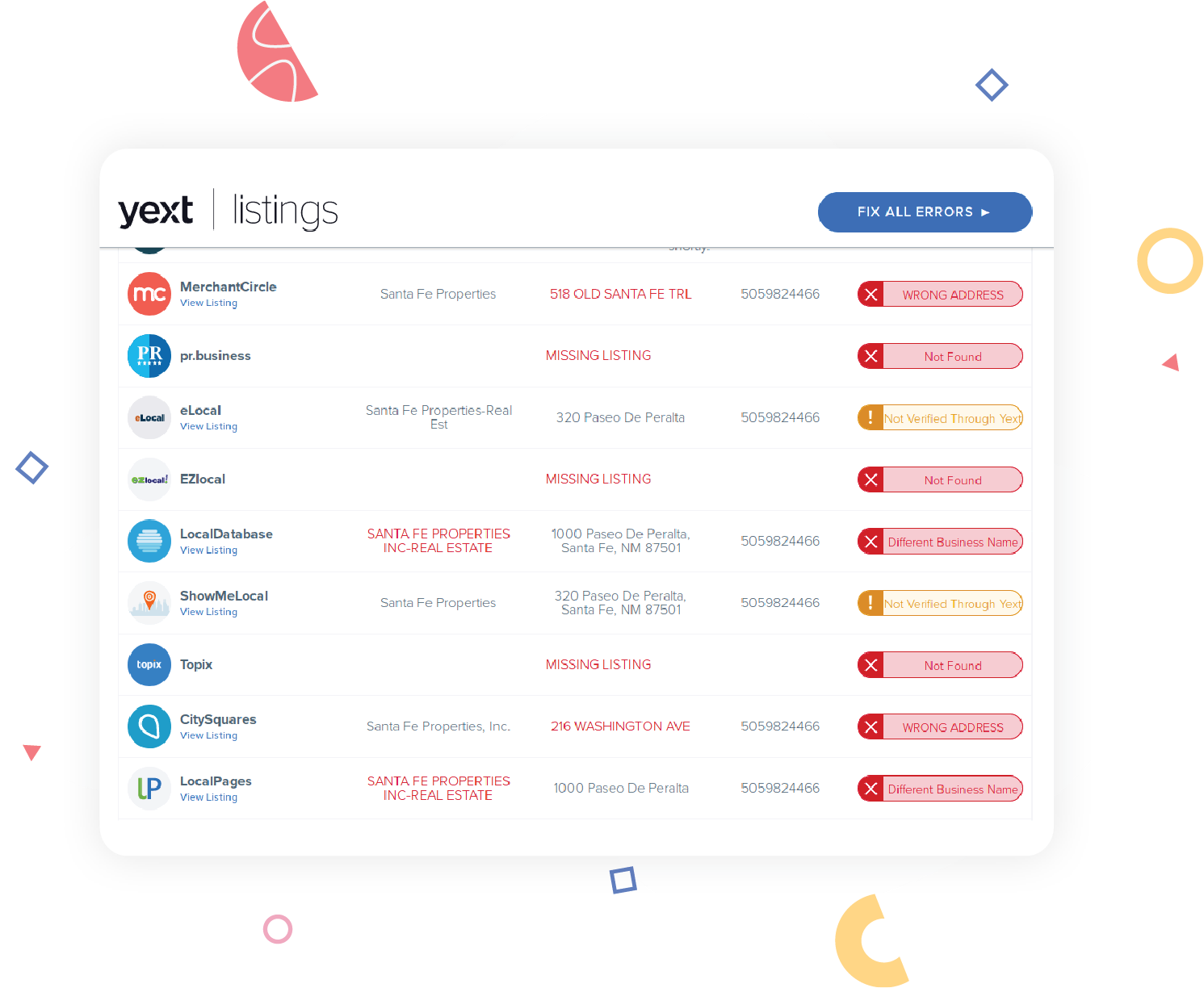
Yext has a direct integration with the largest data aggregators. You can upload the correct business information and it will push this information out to all the missing directories, in addition to updating existing directories.
NAP+W tool: BrightLocal
Much like Yext, BrightLocal connects with thousands of local directories, including Yelp, Google Maps, and Facebook. It’s a good tool to use in addition to Yext because you can find additional niche and local directories where you can submit your business information, layering even more SEO citation authority on top of your business.
Using keywords to deliver content searchers crave
By now you should understand why keywords are important for SEO, but which keywords should you prioritize? You can’t optimize your pages for the best real estate search terms if you don’t know what they are!
There are a couple of ways you can think about prioritizing keywords. You can focus on low-demand, high-conversion keywords—keywords that aren’t searched super-frequently but that are likely to drive a high proportion of leads. Or, you can focus on high-demand, low-competition, less-conversion-focused keywords—keywords that are searched frequently but that aren’t all that likely to convert, and therefore don’t have a lot of ranking competition.
For both strategies, the key is to build high-quality, informative content that attracts website visitors and drives engagement, and pair it with the best possible keyword for that content. To do that effectively, you’ll have to generate a list of the best possible keywords through research.
Keyword research
Keyword research just might be the most-overlooked aspect of real estate SEO—marketers will happily spend countless hours on social media or writing blog posts without understanding keyword research at all—but if you truly want to master SEO, you can’t ignore keyword research.
What’s really insane about this philosophy is that you’re wasting time writing blog posts and even posting on social media if you’re attracting the wrong customers (or, worse, no customers at all). Keyword research should be the foundation of your SEO strategy.
Keywords can be tricky because the word or phrase that you are personally most likely to type into Google to find answers won’t necessarily be the most popular word or phrase. So how do you find the most popular keywords? Small differences in phrasing can make a big difference in ranking. And including your specific location (down to neighborhoods, developments, and enclaves) is an excellent way to reach customers specifically interested in your market and niche.
There are numerous tools that you can use for keyword research; here are a few we like.
Ahrefs
Some tools such as Ahrefs are paid, but they are easy to use and navigate. A search for “sell house fast denver” showed us that search volume for that specific term was 40 searches per month, but adding just one word increased that search volume opportunity fivefold to 200 searches per month: “sell my house fast denver.”
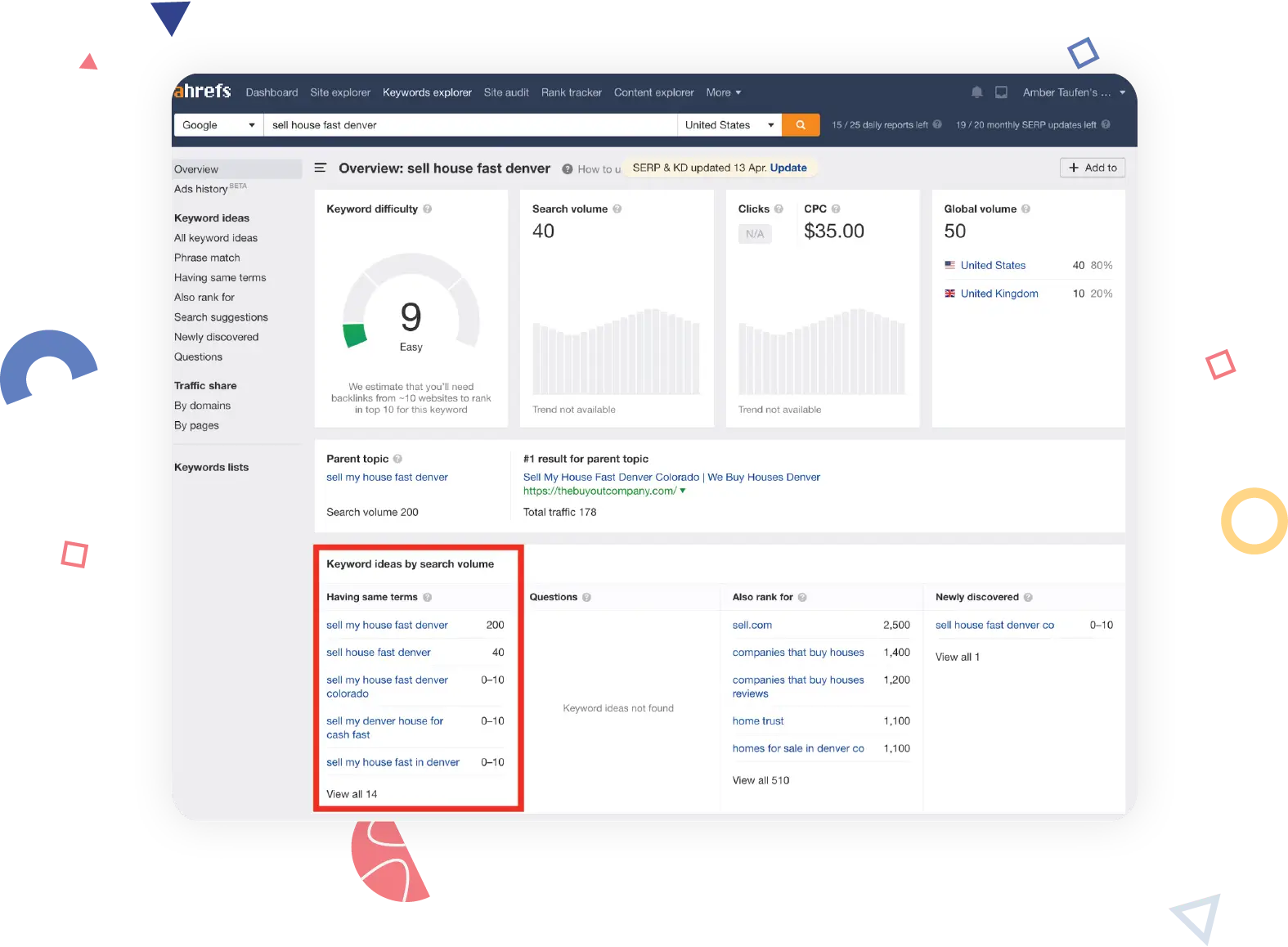
The Ahrefs site explorer can also show you which keywords your competitors are ranking for. Click on “Organic Keywords” on the left menu after entering the site domain.

Ubersuggest
SEO expert Neil Patel created Ubersuggest, an SEO tool that helps you find keyword ideas and evaluate the level of competition for those ideas. If you don’t want to pay for all of the features you can get with a tool like Ahrefs, take Ubersuggest for a spin and see if it will work for you.

Buzzsumo
One excellent tool for examining how your competitors are doing and what keywords are helping them rank is BuzzSumo. Its free version should be sufficient for most real estate SEO strategies.
Let’s take a look at the most engaging posts that BuzzSumo shows from maxrealestateexposure.com:

You can see that people read and share Bill Gassett’s content; he’s the agent behind maxrealestateexposure.com.
Google Ads Keyword Planner
Google Ads has built-in keyword search functionality, and it’s free to use; setting up Google Ads doesn’t mean you have to spend any money (though you will have to set up a campaign in order to use the Keyword Planner).
Keyword Planner lets you search for relevant keywords and access historical statistics and forecasts for those keywords. You can also download keyword ideas in a file.
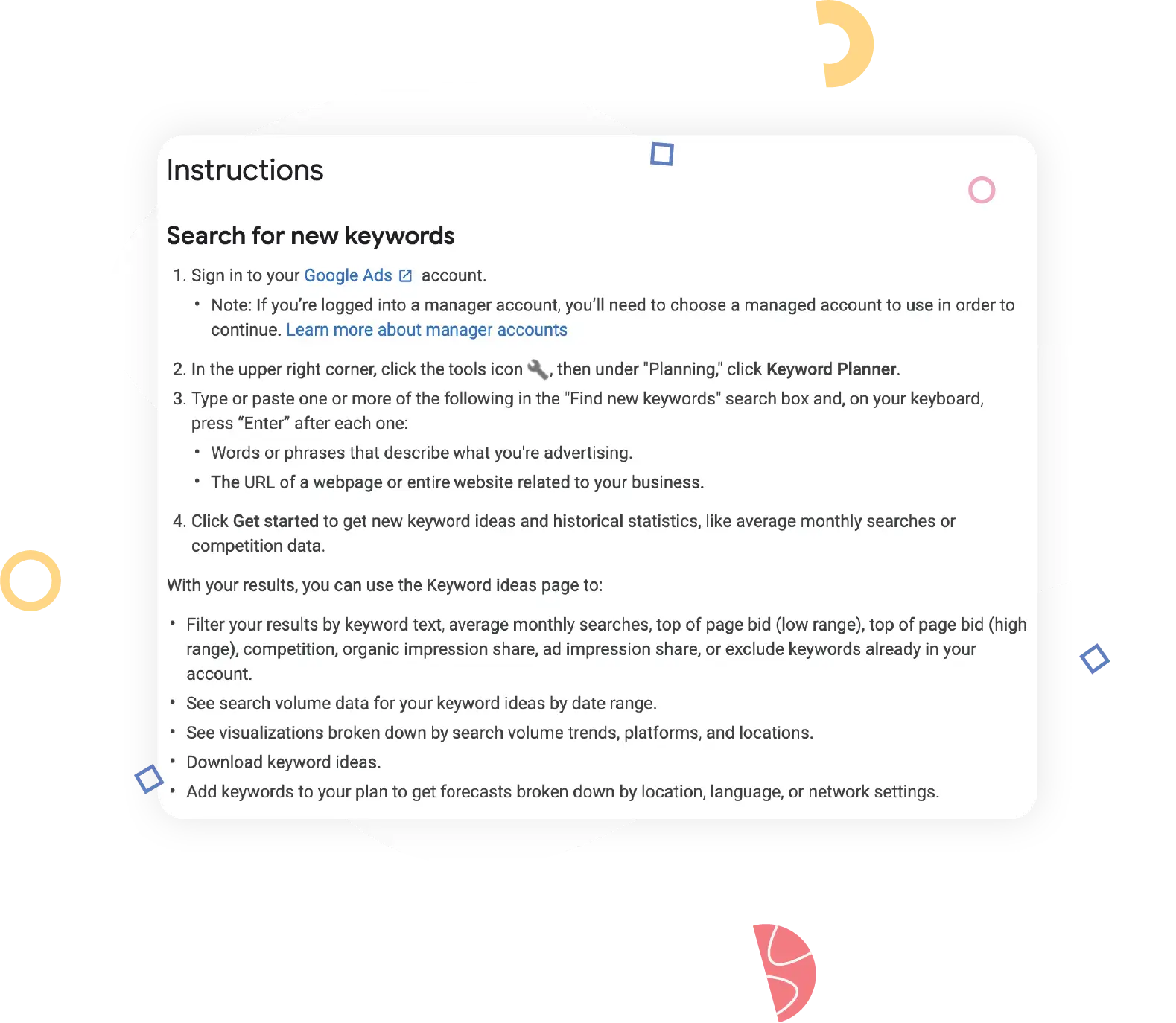
Google Analytics
If you’re already ranking for any organic search terms, Google Analytics will tell you about it. Set up a Google Analytics account for free to find keywords and track your website’s performance. Google Analytics will also come in handy when you want to iterate and improve upon what’s already working well.
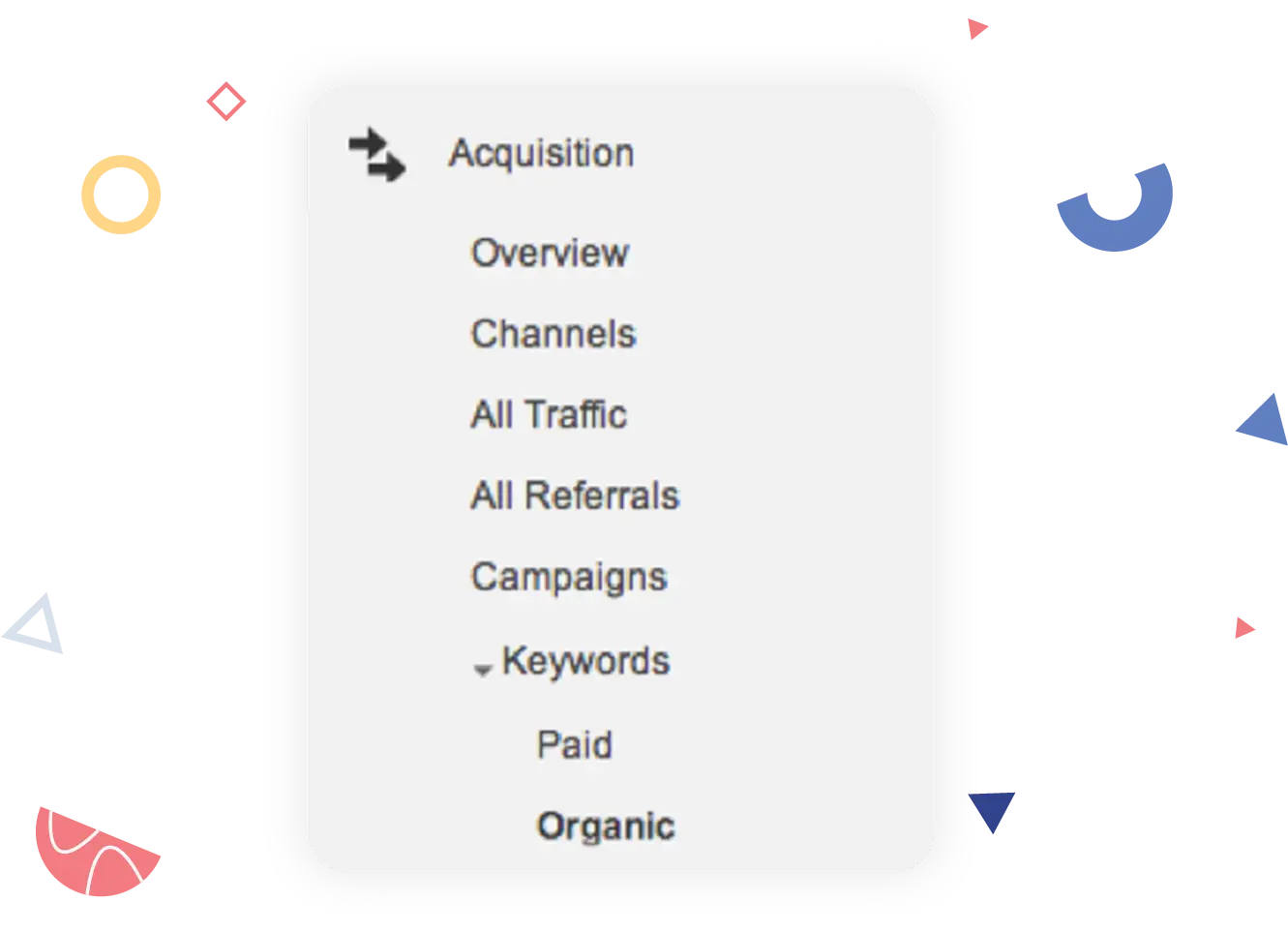
People Also Ask
You should be Googling the keywords that you’re targeting so that you can get an idea of what else is ranking and why it’s popular. One feature that Google offers is the “People Also Ask” box, which shares, well, what people are also asking around that topic.
If you don’t want to pay for a tool, this can be a good way to dig into keywords; even if you do pay for a tool, it can surface other potential keywords for you to target. It can also help you figure out more popular or better-phrased keywords without having to pay for a tool. This search for “saving for a down payment boulder” (about 9,500,000 results) shows that “can i afford a house in colorado” is another potential search opportunity (about 34,400,000 results).
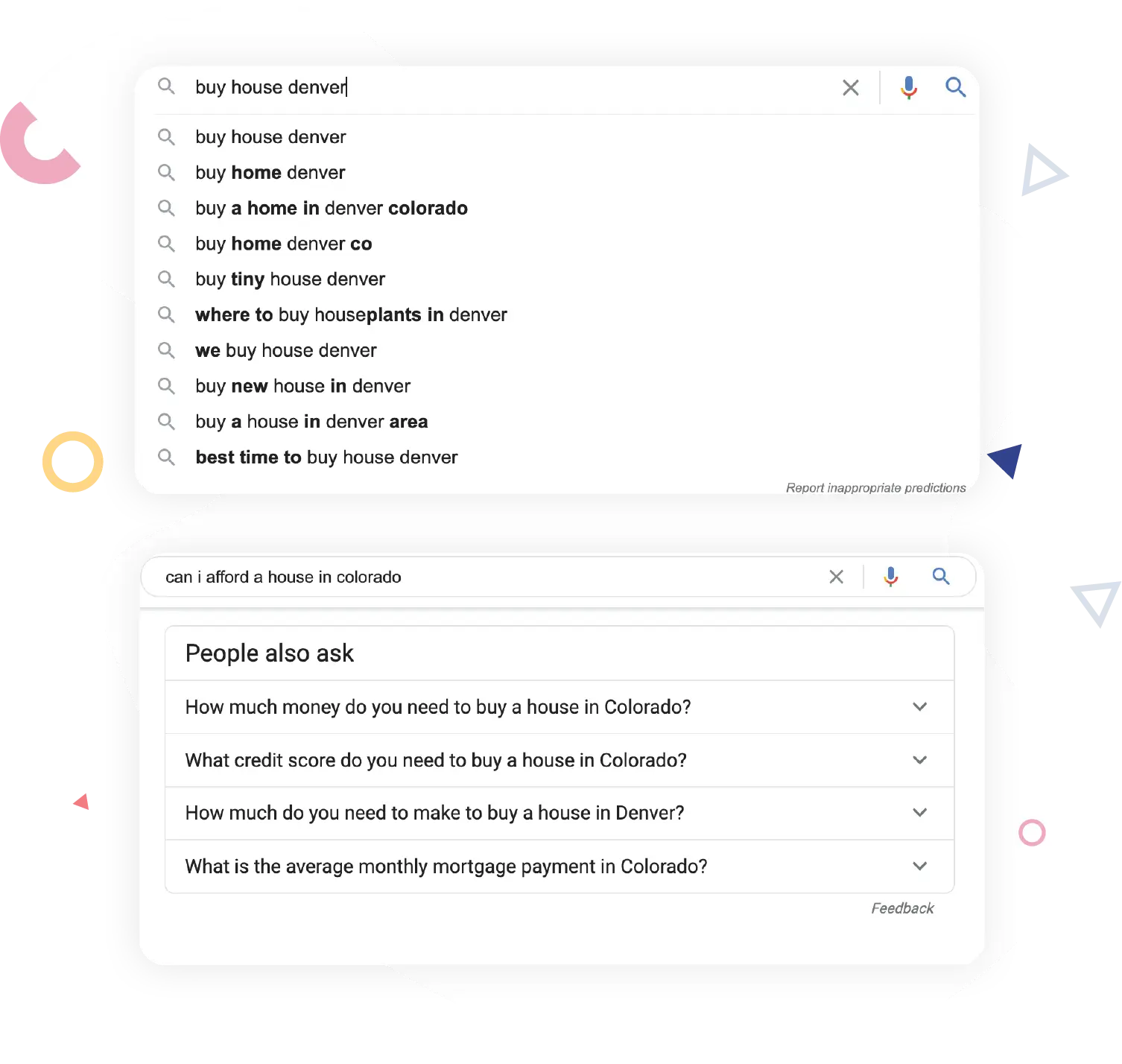
Combining tools
Let’s revisit maxrealestate.com to show how layering tools can give you even deeper insights into your competition.
One of the posts with the most engagement on BuzzSumo was about home renovation loans, an insanely competitive topic. When you combine tools, you can learn even more about your competition and further refine your keyword strategy. Ahrefs can show the keywords that Bill Gassett’s home renovation loans post is ranking for on Google:
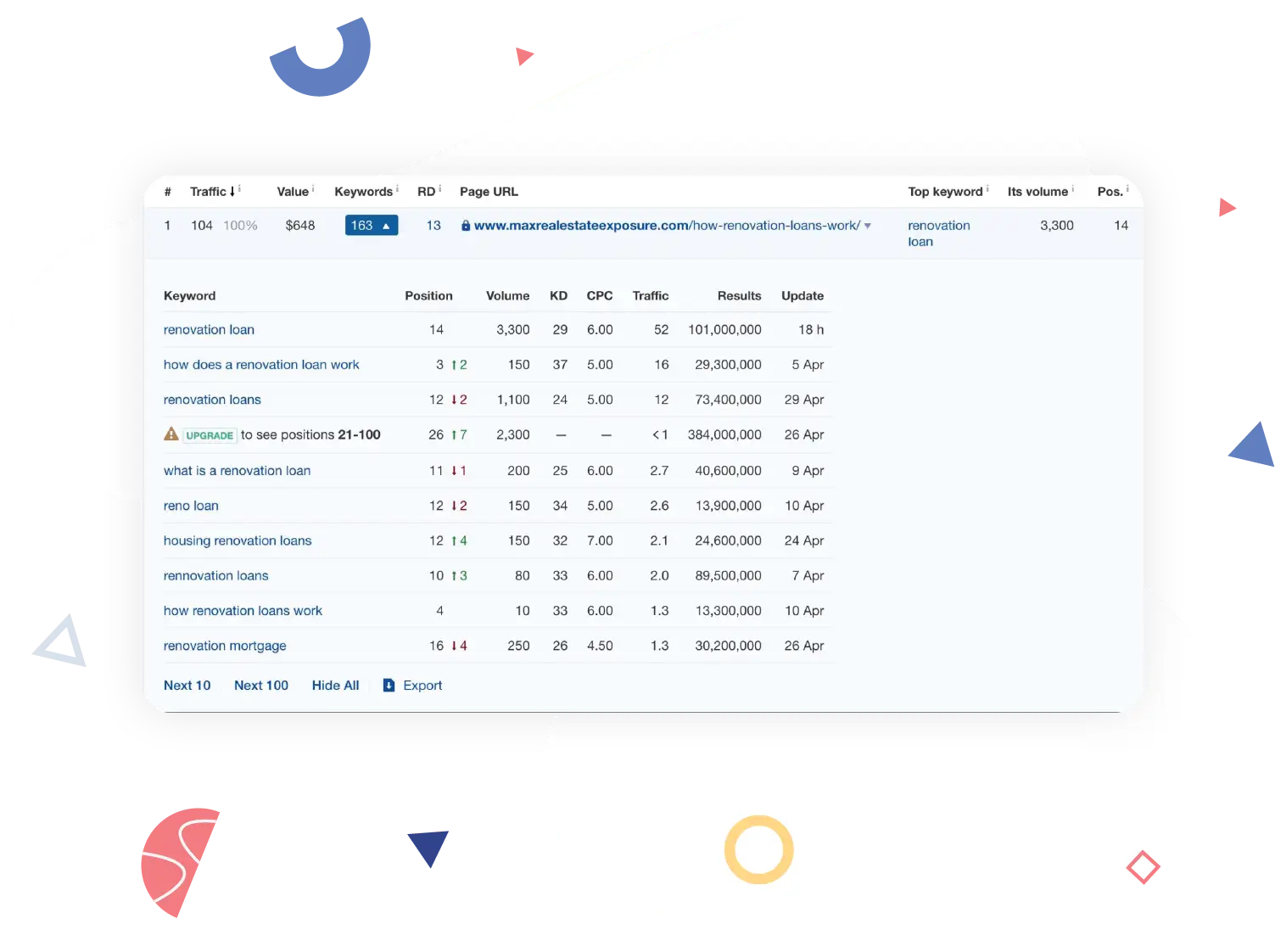
This one piece of content ranks for 163 keywords and drives more than 100 clicks to Bill Gassett’s website every month—and it’s far from the most popular piece of content on the website. At the time of this writing, that was a piece called “What Is Credit Karma And How Does It Work”:

The Credit Karma piece ranks for about 1,200 keywords and drives 404,000 visits to Bill Gassett’s website every month.
Moving back to BuzzSumo, we can look at how much of that traffic and engagement is generated by social media. And we can see it’s not as widely shared as the piece on home renovation loans.
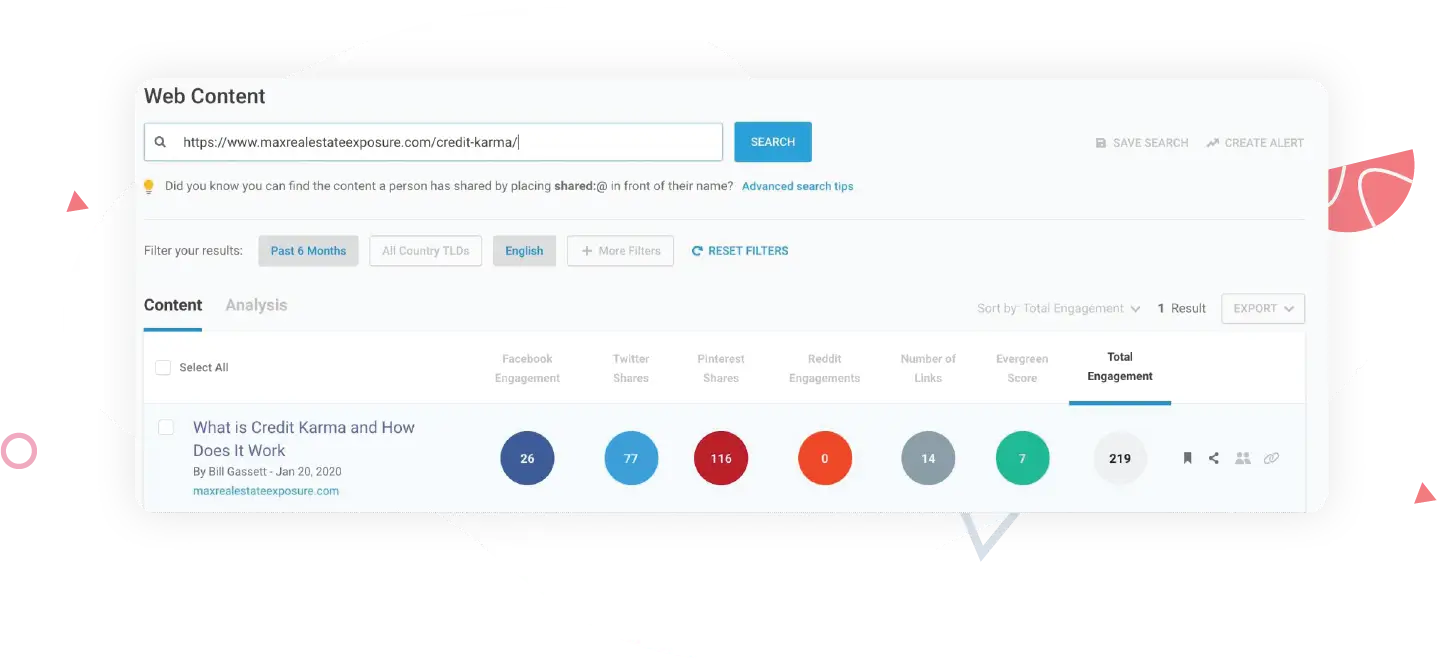
Going deeper: Long-tail keywords
A long-tail keyword is a keyword that’s built on a “head keyword” (a short, broad word or phrase) to become increasingly specific and niche. It’s called “long tail” because it falls in the long tail of the search demand curve:

These searches are less popular because they’re more specific and less competitive, but they can be wonderful conversion tools. Typically, the longer the keyword is, the higher the search intent, so long-tail keywords are almost always actually, well, long.

Why would you want to focus on long-tail keywords when they aren’t all that popular? Because the people who are typing these keywords into Google are seeking something very specific and targeted, which means they are more likely to convert into a lead if you can provide them with that something.
To beat a head keyword (such as “real estate”) and rank at the top of the SERPs, you’ll have to leapfrog over hundreds of established, high-authority websites. That’s going to be expensive and difficult … and even if you’re successful, there’s no guarantee that people who want to buy, sell, or rent in your area will be starting their search by typing “real estate” into Google. You might rank well for a head keyword, but that keyword isn’t going to generate very many actual leads for you.
About 60% of Google searches are for long-tail keywords, such as “buy 3 bed home in minnesota” or “lake house summer rental poconos.” Typically, the longer the keyword, the higher the search intent.
Here’s an example of this strategy in action—check out how two local small businesses are ranking ahead of Zillow and competing with big brands by using long-tail keyword targeting:
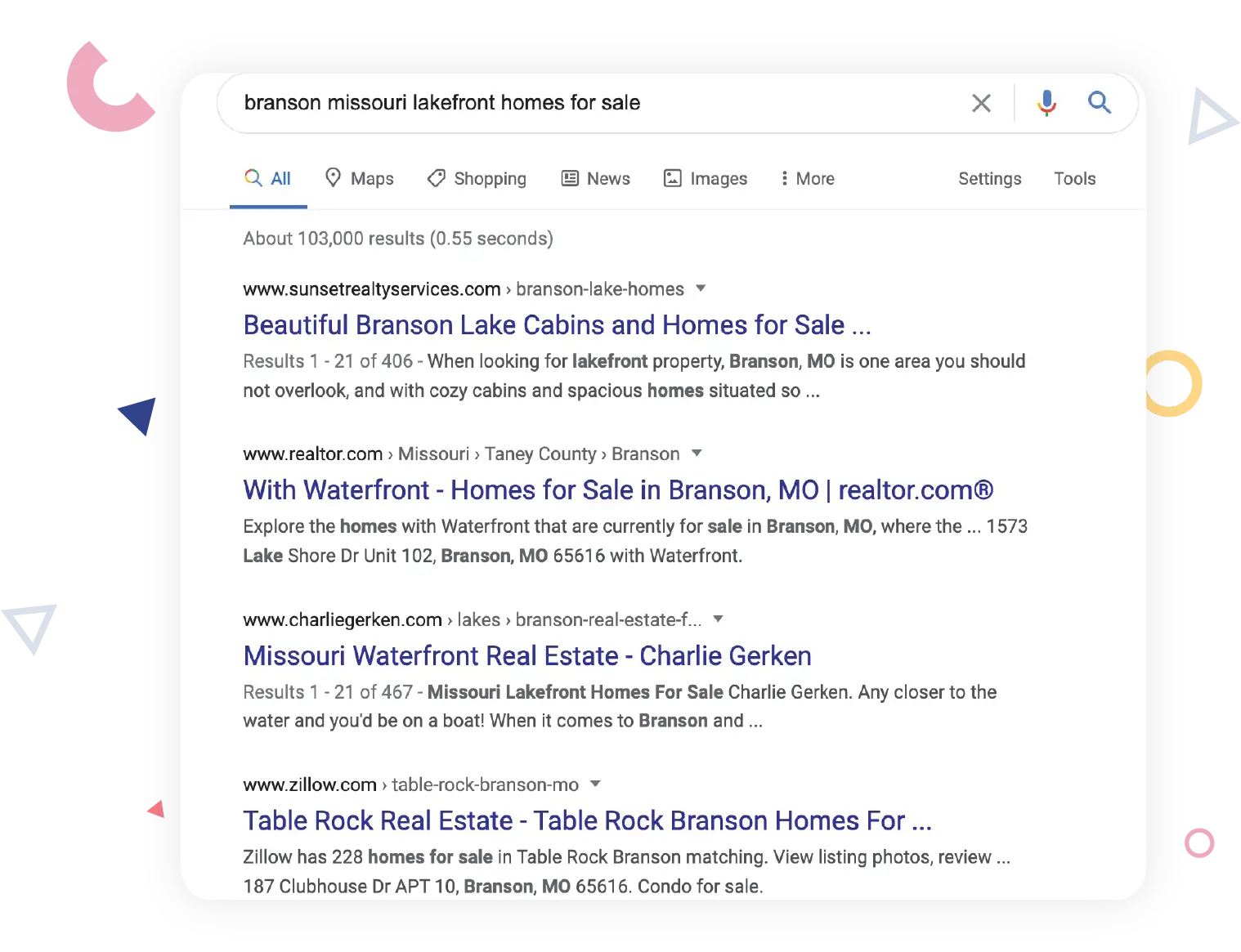
The top hit, sunsetrealtyservices.com, ranks for thousands of long-tail keywords; each keyword has low monthly search volume, but considering that it gets more than 6,000 visits per month, you can see how this strategy can pay off for a real estate business that understands its niche and knows how to use keywords to target it.

Finding long-tail keywords
You can use the keyword search tools mentioned above to find long-tail keywords, but an easy way to explore long-tail keywords is simply to use Google itself.
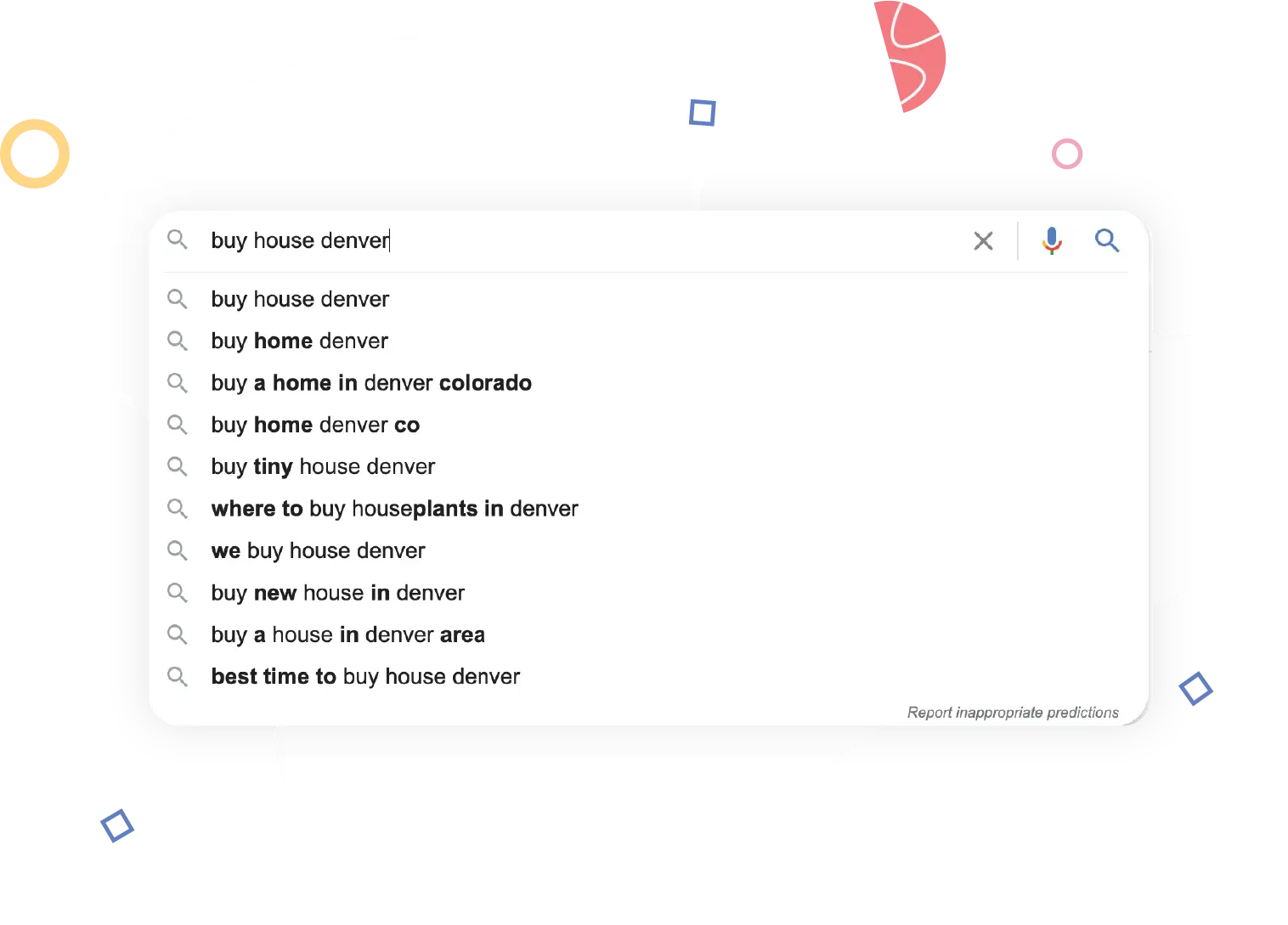
This will return a list of additional queries that users are typing directly into the Google search bar. You can follow those search queries further down the keyword rabbit hole by using the Google Ads Keyword Planner and People Also Ask tools.
Localized content
Real estate is a competitive industry, with millions of agents trying to reach the same group of buyers and sellers. The good news for you is that the real estate industry has a reputation for producing content that’s, well, fairly lame.

So if you can create quality content that educates, informs, and engages consumers through their entire home-purchase or home-sale life cycle, you’ll be well on your way to winning over Google. Here’s a repository of content ideas to help you get started:
Zillow is excellent at using local SEO and localized content to rank well on Google. According to Ahrefs, it ranks for more than 12 million keywords and generates tens of millions of organic visitors every month.
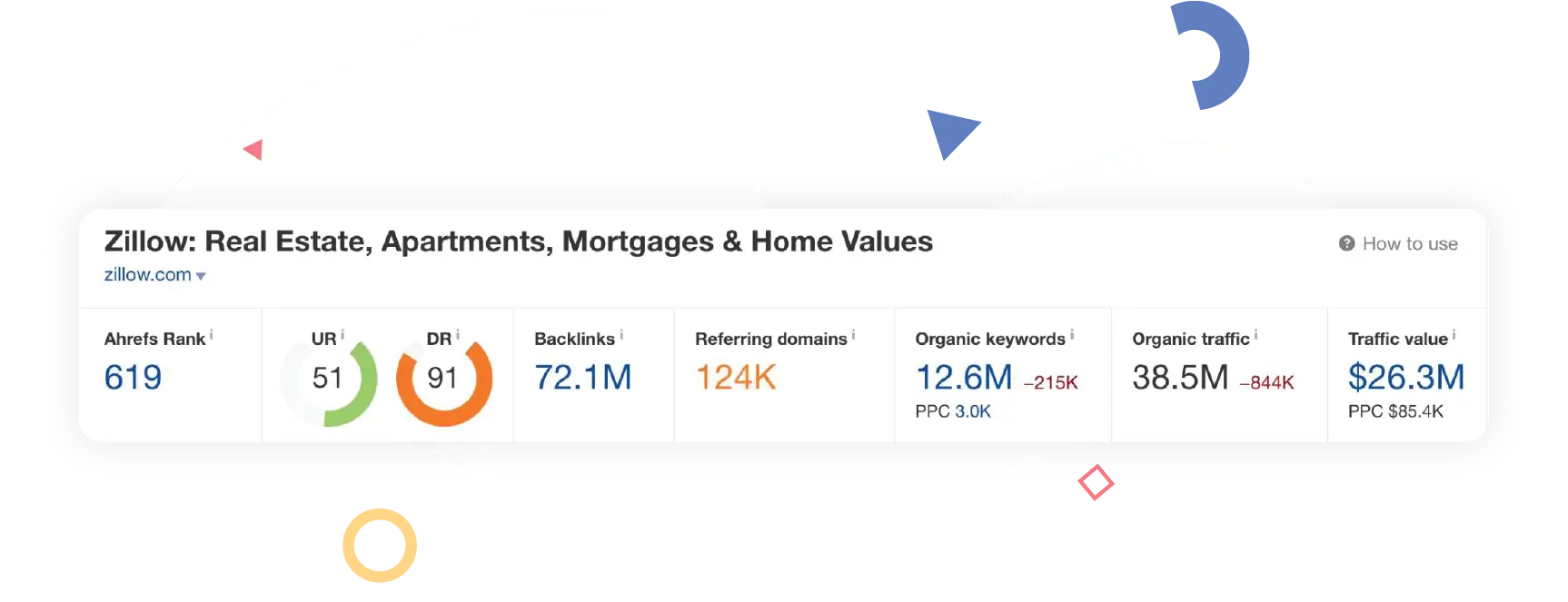
Obviously, a lot of that traffic comes from dominant listing and category pages that outperform other portals. However, Zillow also uses interesting, quirky local homes and topic ideas to entertain and engage readers (and, not incidentally, to drive traffic).
Remember when Zillow took us on a tour of the Albuquerque homes that were featured in Breaking Bad?
This is a consistent strategy across Zillow’s blog, which regularly features unique listings and supplements the photos with agent interviews, historical background, and other context that helps bring the house to life for readers.
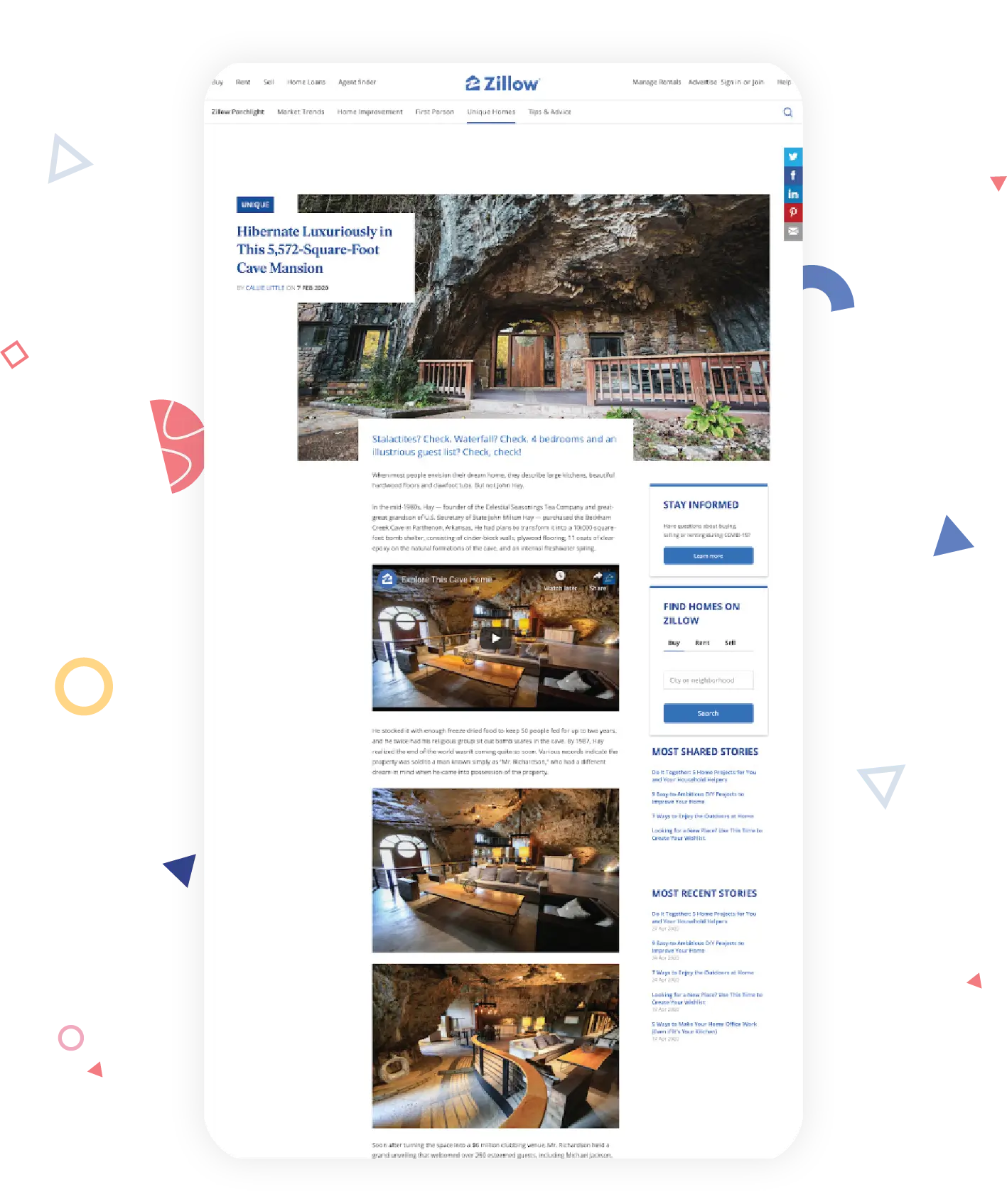
Here’s an example featuring a cave mansion in Arkansas. In addition to embedding the listing photos and listing video into the blog post, Zillow shares details about how it was built and its history (it was both a former bunker and nightclub!), then links to the vacation rental listing at the end.
Remember: You never have to reinvent the wheel—especially when other businesses have already drawn up the blueprints. Just check to see what’s working best for your biggest competitors, then do your best to iterate and improve on their best results.
Building a backlink strategy that works for real estate
Optimizing your website’s keywords and content is definitely the best way to rank on Google, but it’s only half of the puzzle. There’s a limit to how much you can do without backlinks, which is a key pillar to improving your SERPs.
Capturing backlinks as a real estate business (or any commercial enterprise, really) isn’t exactly a cakewalk, but it’s possible. For real estate, it means working to build local citations, backlinks, and reviews on popular platforms.
How do you get backlinks? There are a few methods you can follow to try to get high-authority links back to your website.
Content and outreach
The simplest strategy to get good backlinks to your site involves two steps, both of which are more difficult than they seem:
- You create a resource that’s valuable to your audience.
- You ask relevant websites or companies to link back to it.
If you’re using your keyword research intelligently and examining engagement and other metrics, then you should be able to figure out what your audience wants. That’s how you create resources that people like and want to share.
There are a few ways you can think about outreach, or asking relevant companies or websites to link back to your content. You can send infographics or data visualizations to news organizations, ask schools if they’ll link to your guide on area schools, share your overview on area recreation options with the local blogger who specializes in rock-climbing—it’s going to depend on the type of content and who is interested in reading it!
Another good way to get backlinks to your site is to search for local directories that might be relevant to your readers. Resource pages, groups, events, lists of real estate businesses, anything that might conceivably list your business: find those directories and then ask if you can be included with a link.
Tools like Ahrefs give you the ability to see where your biggest competition is getting its backlinks, and then you can copy-cat their technique. Are they using a lot of directory links? Do they have backlinks from local businesses or news sites? Can you tell how they’re generating those links? Are they sponsoring events, commenting to the press, blogging, donating, or using another strategy?
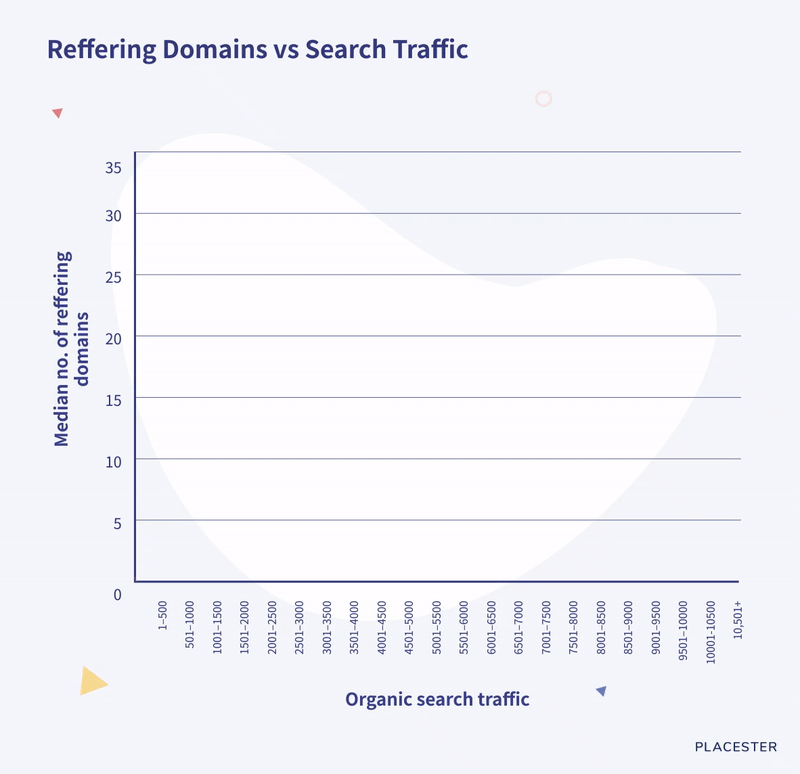
However, getting just one link isn’t easy; it’s important to recognize that to execute it properly, you’re going to have to throw a lot of resources at link-building in your real estate business. In general, it might be a better use of your time and money to engage an experienced SEO agency to help.
If you’d prefer to try to tackle it on your own, here’s a comprehensive guide on competitor backlink analysis.
Strategic internal linking
Think about your website’s structure. Ideally, you want visitors to be able to find anything they’re seeking easily, which means you’ll need to create an internal linking strategy that makes everything potentially relevant easily accessible to your audience.
In the sketch below, Moz demonstrates the ideal internal linking structure: each page links to multiple relevant pages, branching off from the home page, and no two pages are more than three clicks apart.
This gives your audience a clear path to follow on your website and multiple rabbit-holes to explore, but none of which will lead to a dead-end. And because internal linking is good for your audience’s search experience, it will also help support your SERPs.

When you publish a new blog post, you should make sure that you’re both linking to existing content on your website within that new post, and also thinking about areas of your website that reference the new blog post’s keyword so you can link back to it. This gives your brand-new post the accumulated authority that your site has managed to earn as soon as it’s published, which means Google will find it faster.
One often-overlooked opportunity for internal linking on real estate websites is on neighborhood pages. Neighborhoods right next to each other, or with similar attributes, are often referenced in another neighborhood’s guide. By making sure that every reference to the neighborhood includes a link to that neighborhood’s guide (even on a different guide page), you’ll create a rabbit warren that will entice your website visitors to get lost.
Why Google loves reviews and ratings, and how to use them
Google loves online reviews and ratings because as it turns out, people like them quite a bit, too. Qualtrics reports that reviews influence purchase decisions for 93% of consumers, and data from BIA/Kelsey showed that 97% of people read reviews for local businesses.
Online reviews not only help establish trust (critical for conversions), but are now a heavily weighted local ranking factor. According to Moz, Google weighs review factors for organic search results, but the company weighs reviews even more heavily for the local pack or finder (the map results) search results.


We can see how this translates to SEO when we look at the map results. The top result for our map search has significantly more reviews than the second and third hit, even though the overall score is slightly lower.
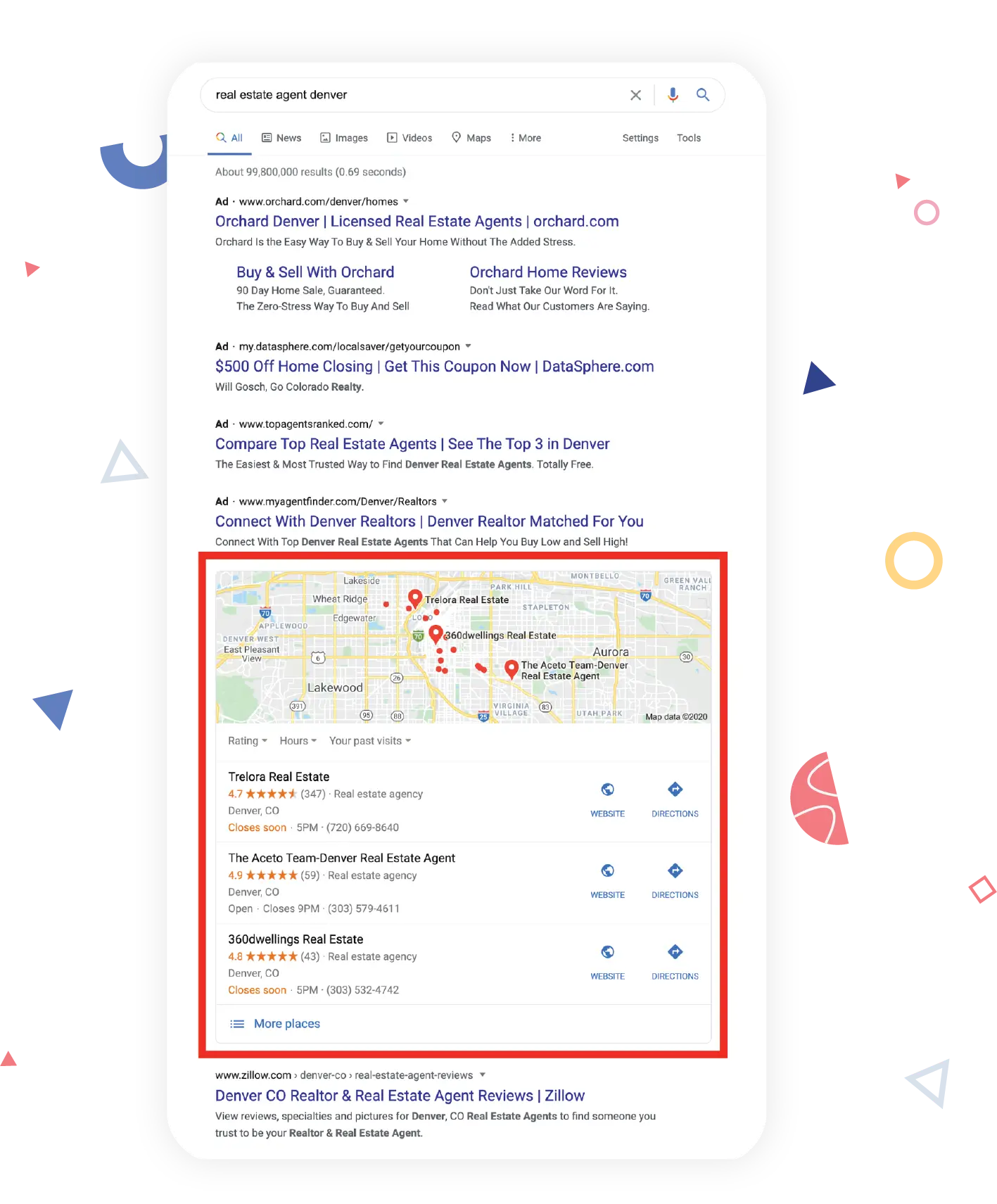
When you know you’ve worked with a buyer or seller who’s immensely satisfied with your service, invite them to write a review for you on Google, Facebook, and Yelp.
Yelp reviews
Yelp helps show your current clients how happy your former clients were with you, but it can also be used as an SEO vehicle. The site already has a ton of authority with Google, so if you can get a couple of good Yelp reviews in your area, it can be a big boost to your business.
How do you get Yelp reviews? The same way you get most things: just ask. Make sure you’re providing direct links so that it’s easy for your clients to get to the review.
Technical SEO: Small things that make a big difference
We won’t lie to you: There is some technical know-how involved in technical SEO. However, even though you might think that you can safely ignore these steps, you probably shouldn’t if you really want to rank well.
If anything (or everything) in this section makes your head spin, it would be a good time to talk to an SEO professional and have them handle this part of your website’s optimization—or to work with a platform that handles most (if not all) of these tasks automatically.
Schema markups
A schema is the standard for structured data on the internet; it’s a way to tell web browsers what your websit e is all about. Schema markups document important information on your website for Google.
We touched briefly on one kind of schema markup (your NAP+W) earlier, which looks like this:
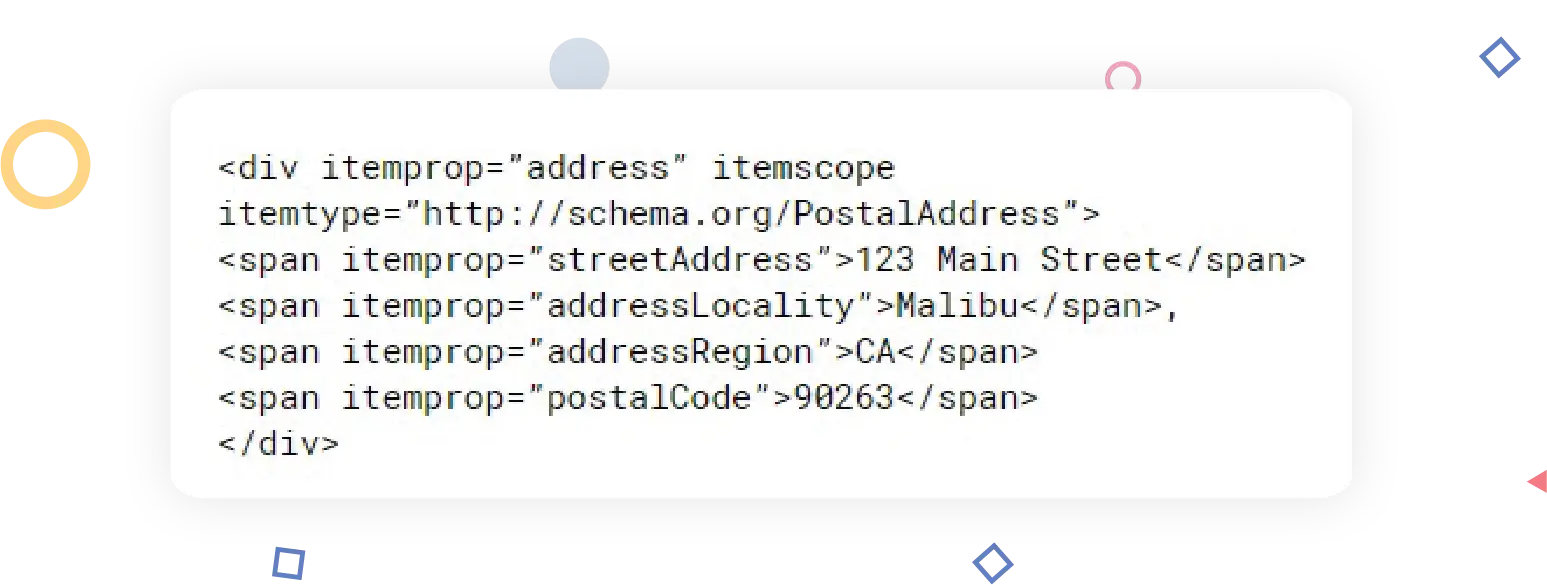
Google recognizes certain schema elements, like phone and address, and uses that to check its own Google My Business information for accuracy. But that’s far from the only thing you can use schema markups to flag.
For example, you might create and populate schema fields for a property’s price, square footage, bedroom and bathroom count, and more. This makes the listing page easier to read, and Google will therefore be more likely to feature it
There are two main sets of schema that you’ll want to think about on your real estate website.
The first is your business listing, your NAP+W plus your hours of operation and contact details.
The Schema project has an entry that exactly describes a real estate agency:
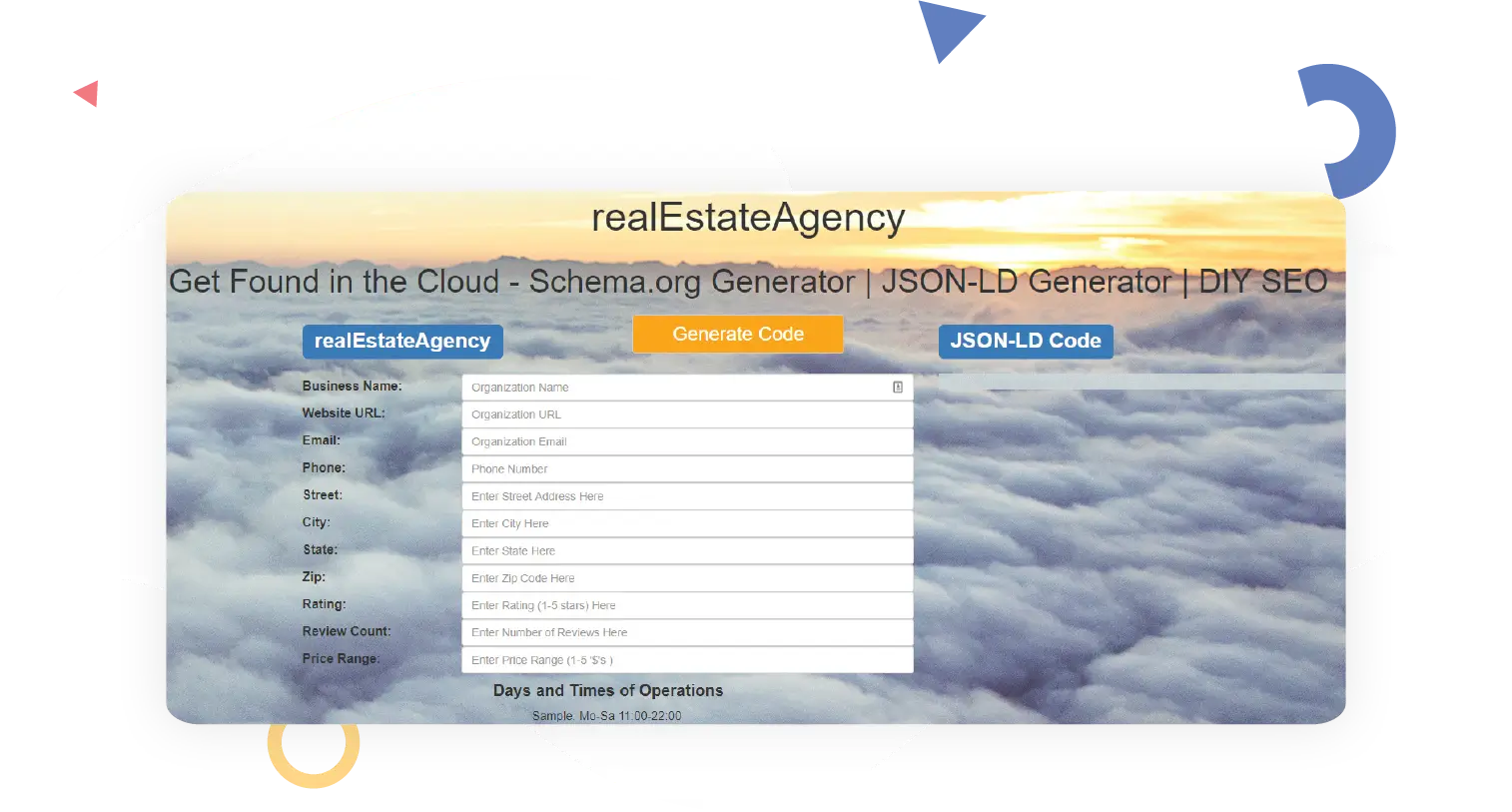
The second way to use schema markups is to mark up property listings.
Trulia uses the product schema markup for listing properties, including the following fields:
- Name (the property’s address)
- Offer price (329000)
- Offer currency (USD)

Fixing broken links
Depending on how long your website has been around, there might be one or several broken links, especially if you’ve played around with the URL structure in the past. This can hurt the user experience and have a negative impact on your SEO.
The free version of Screaming Frog SEO Spider is all you need to check for broken links on a site:
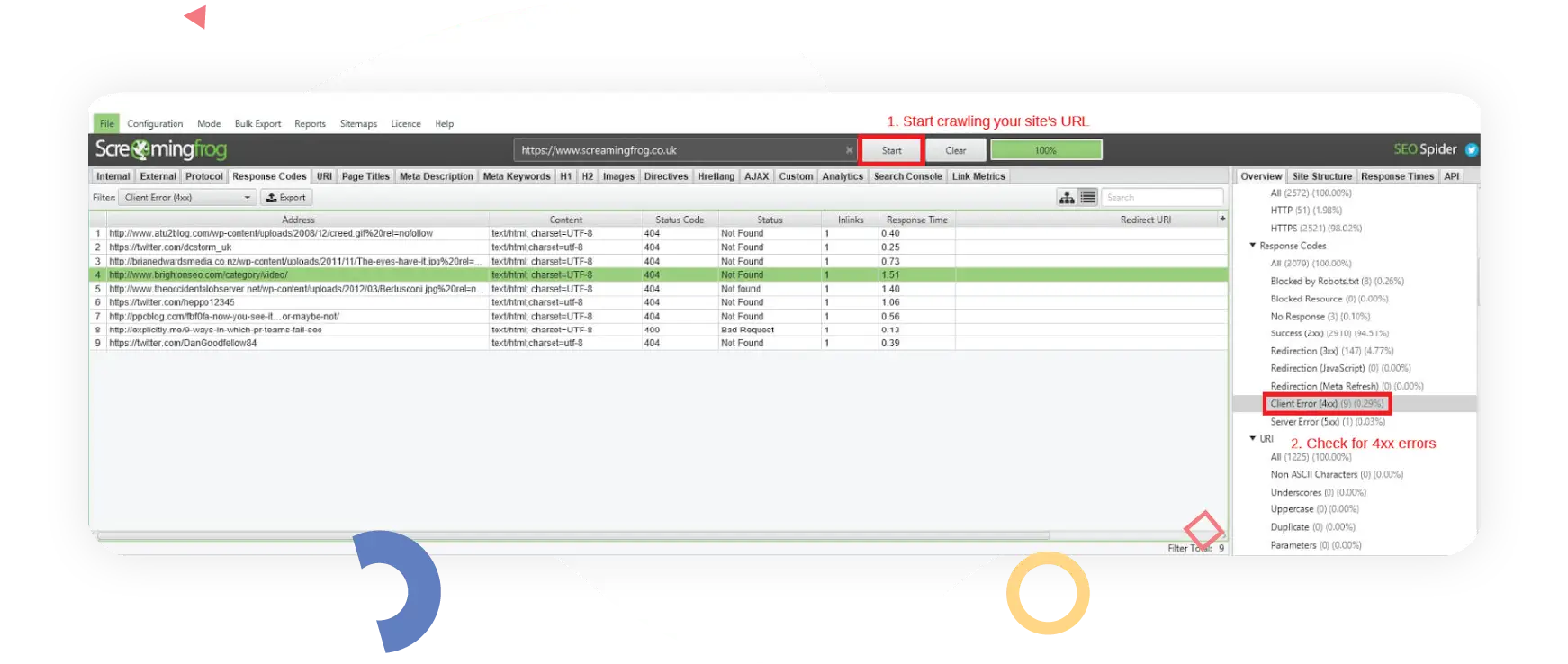
Download the tool, enter your site’s URL into the crawl box, and hit “Start.” Watch as your site’s links are crawled and check the 4xx errors filter; these pages are unreachable for users.
Google Search Console is another tool that can help you find broken links. Once it’s set up, you can configure it to notify you when it finds broken links on your website.
Is your redirect correct?
Broken links are bad, but improper redirects can leak SEO authority like a sieve. If you’ve ever redesigned your website, you’ll want to make sure you retain any domain authority you’ve earned, which means you’ll have to set up 301 redirects. This will ensure that anybody who clicks on the old URL will still get what they’re looking for on your newly refreshed website.
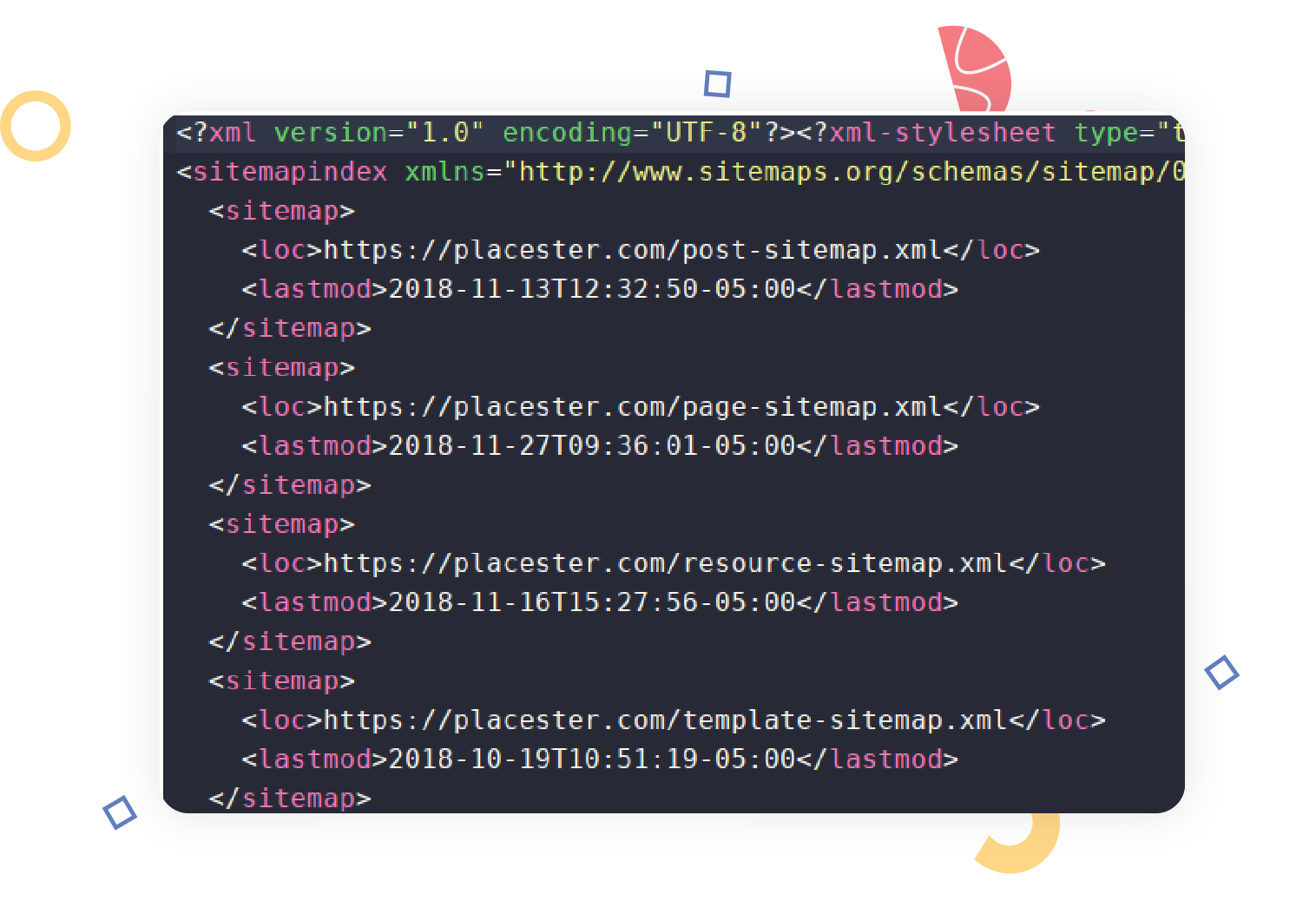
When done poorly, a redirect strategy can send users to broken pages and hurt rankings … so don’t do it poorly.
Creating a sitemap
Sitemaps are files that provide information (or a map) about pages, posts, videos, and other content on your site. Google uses sitemaps to identify the most important content and more efficiently crawl your website.
You can generate a sitemap with Screaming Frog, WordPress, Yoast, or using a free online tool like this.
Google Search Console
Once your sitemap has been generated, submit it to Google Search Console:
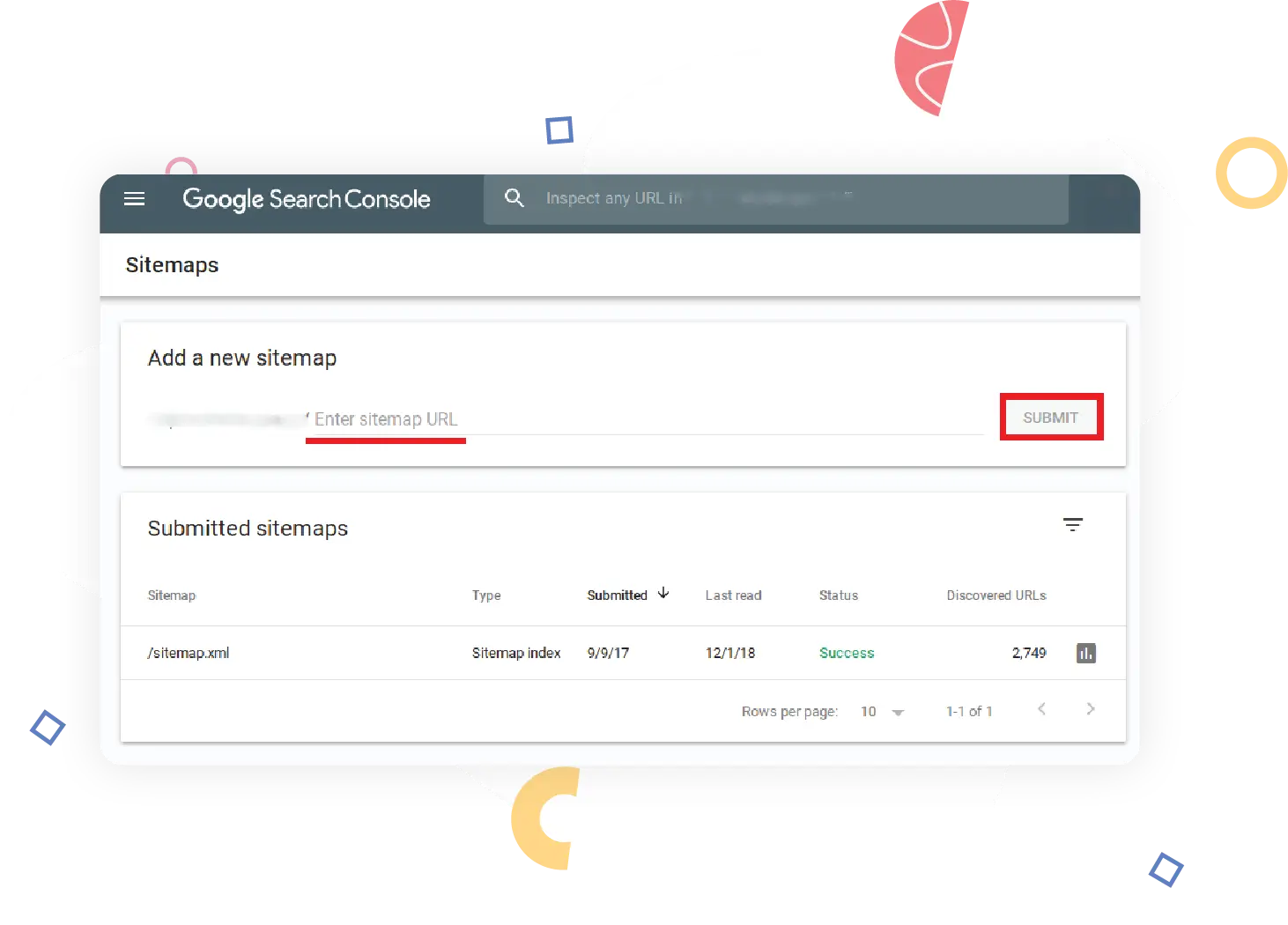
Google Search Console provides insight into your search performance, identifies technical SEO issues, gathers link data, and tells you exactly how Google sees your content:
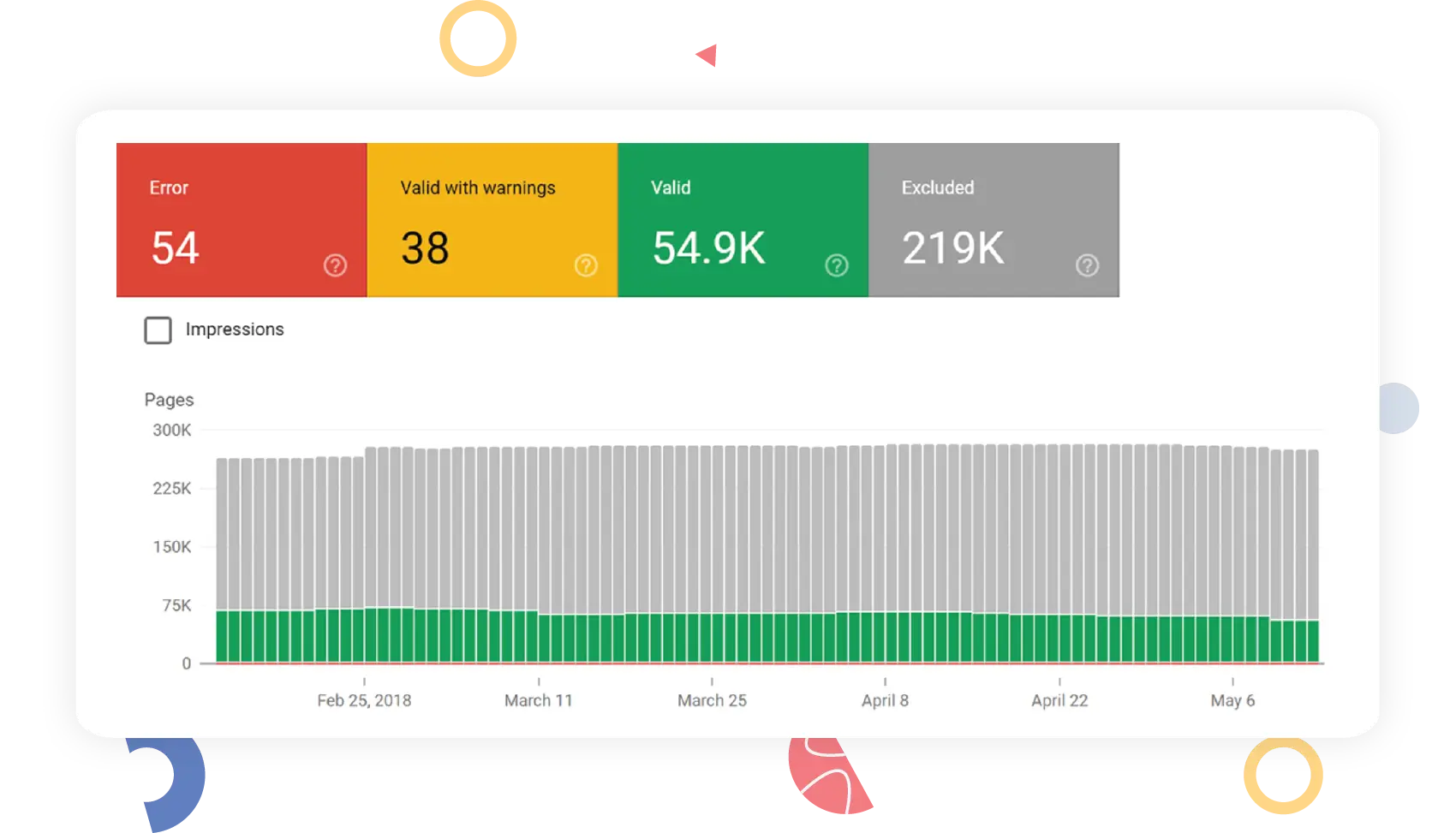
It has a few reports worth checking regularly, including your organic search performance, 404s (broken links), crawl errors, and warnings.
Google Search Console gives you warnings about your website that come directly from Google. It’s usually a good idea to follow their best practices because you’re playing their game.
Google Lighthouse
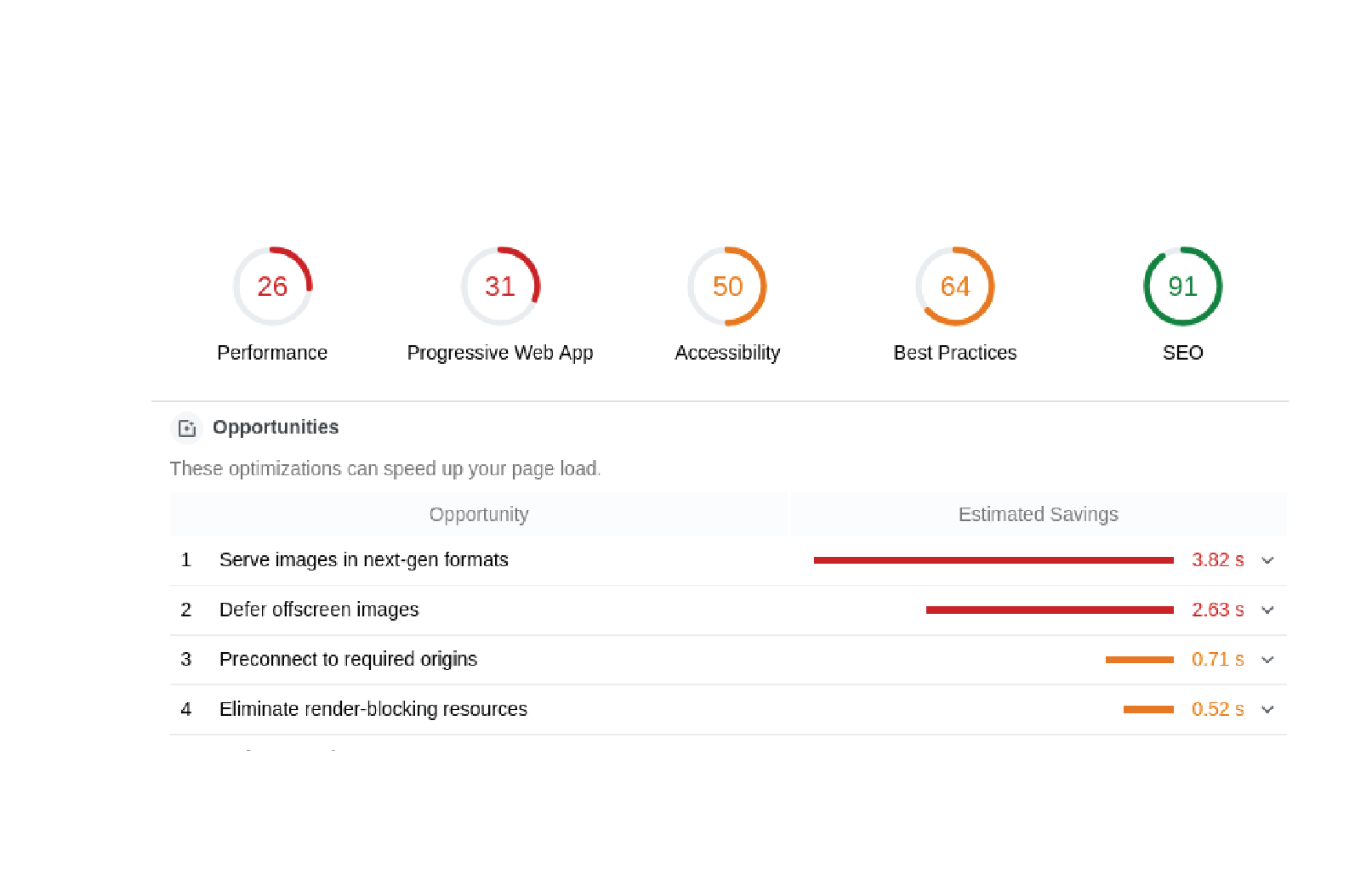
Lighthouse is the next generation of Google tools; it builds on PageSpeed Insights and the Mobile-Friendly Test. It’s a full suite of testing tools built into Google Chrome that gives you insight into both the technical SEO elements of your site on mobile and the usability (loading time, content-blocking scripts, and more).
The easiest way to use Lighthouse is to install its Chrome extension.
Social media as the icing on your SEO layer cake
We’ve been talking a lot about Google and your website, but you’ll need to think beyond search engines if you want to truly dominate SEO in your area. So don’t forget about social media! It’s a supplement to your SEO strategy, and one that has a strong influence on your overall SERP.
Optimize your Facebook page
You do have a Facebook page for your business … right?
A Facebook page isn’t a replacement for a website, but you shouldn’t ignore the social media giant just because it’s not business-married to Google. Facebook pages show up in real estate searches:
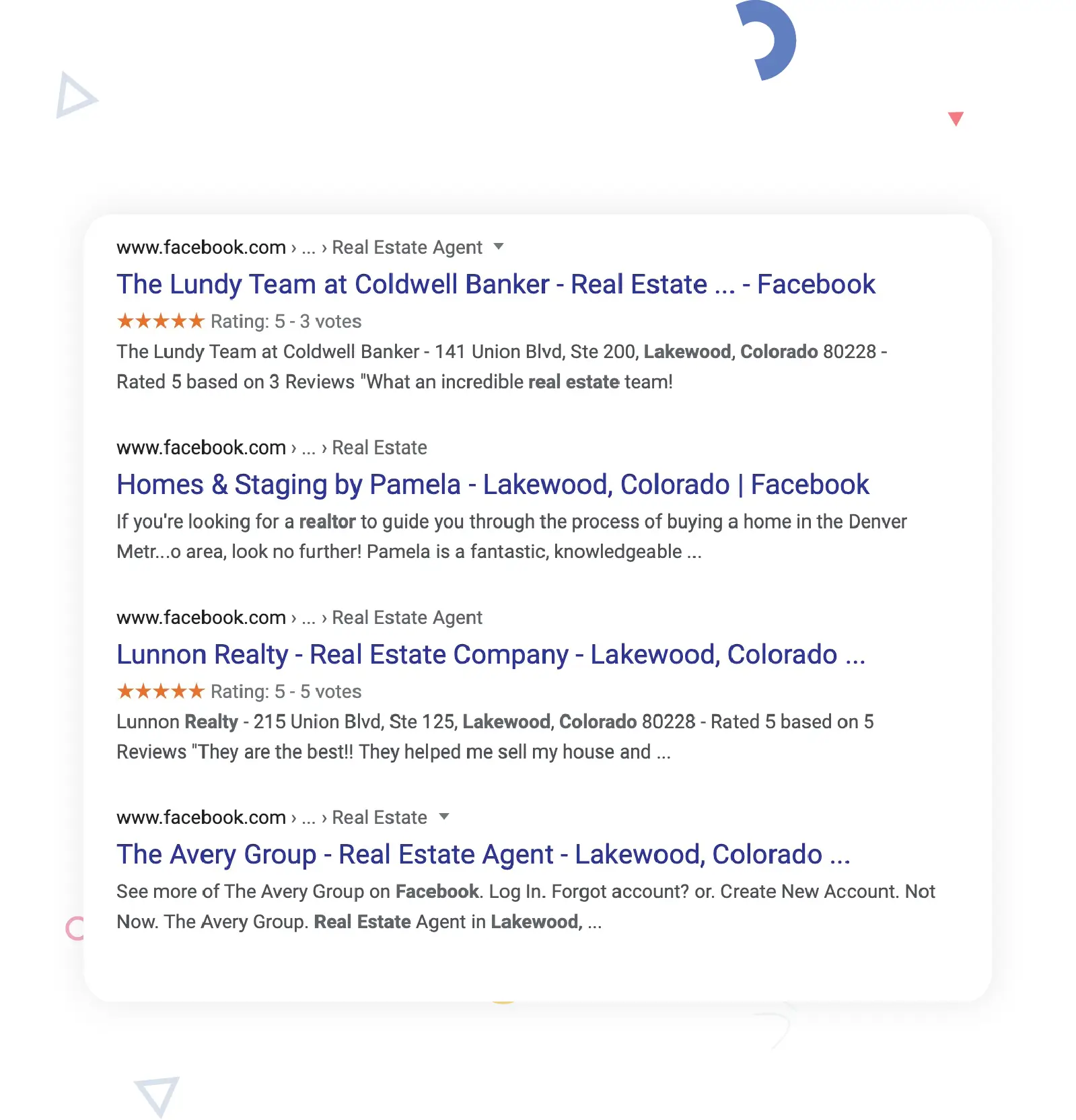
Facebook pages also use rich snippets to show star ratings, which gives social proof and evidence of your trustworthiness right there on the search engine results.
If you don’t have a Facebook page, create one, and make sure that the NAP+W is consistent here, too. Install a Facebook Pixel on your website so that you can retarget visitors, and then use the platform to share some of the content you’ve been creating. When used strategically, Facebook can be a wonderful supplement for your real estate SEO strategy.
Continuing SEO education for real estate agents
When you make SEO a core part of your real estate strategy, it means you’re signing up for a lifetime of learning. Think about how far websites have come in 20 years; a website that was at the cutting edge of technology and user experience in the year 2000 would not come anywhere close to the first page of Google if it were published as-is in 2021. The rules around SEO change all the time, and you’ll have to change with them if you want to keep the advantages you’ve gained.
So don’t get complacent once the hard work of ranking on Google is done! You’ll want to set up a system for staying on top of the changes and ensuring your website continues to dominate the SERPs as a result.
Set up a Google Alert
If you don’t already have a Google Alert set up for your full name, your brand’s name, and “real estate in (your town),” then you could be missing a lot of opportunities both to find quality content and to nip disruption in the bud.
It’s easy: Visit google.com/alerts and type in the phrases that you would like to track.
Then you can change the settings to deliver those results weekly, daily, or automatically as they are found; to deliver results only from certain sources; or to filter according to region and language, among other options.

Configure Google Analytics to track organic search performance
In the famous words of Peter Drucker:
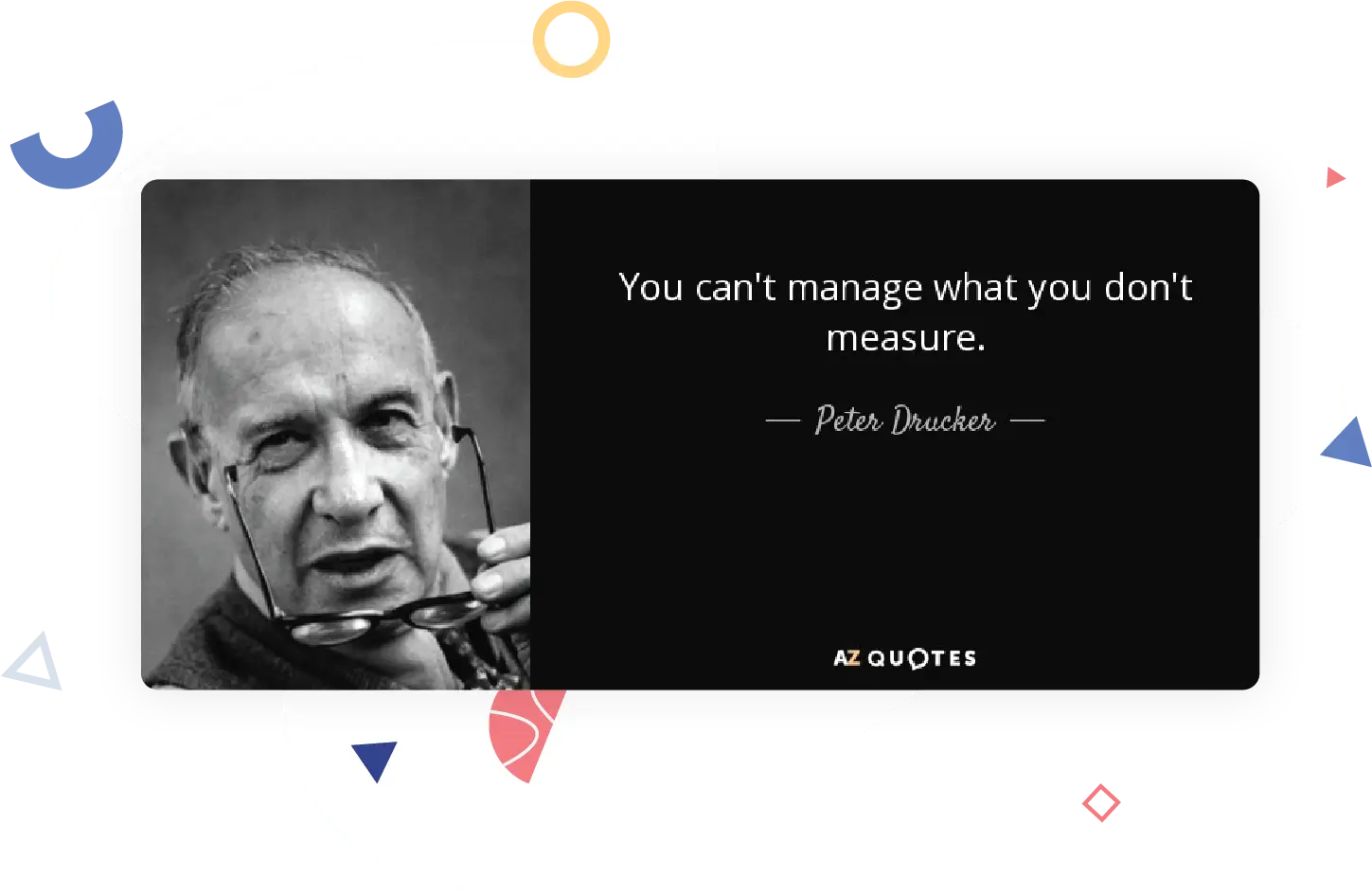
This also applies to your website. If you don’t know which pages are ranking and how well you’re performing for the keywords you’re targeting (if at all), then you won’t be able to manage it—or improve it. The best way to track your website’s performance is through Google Analytics.
You can set up a Google Analytics account for free (if you haven’t already) to monitor your digital marketing campaigns.
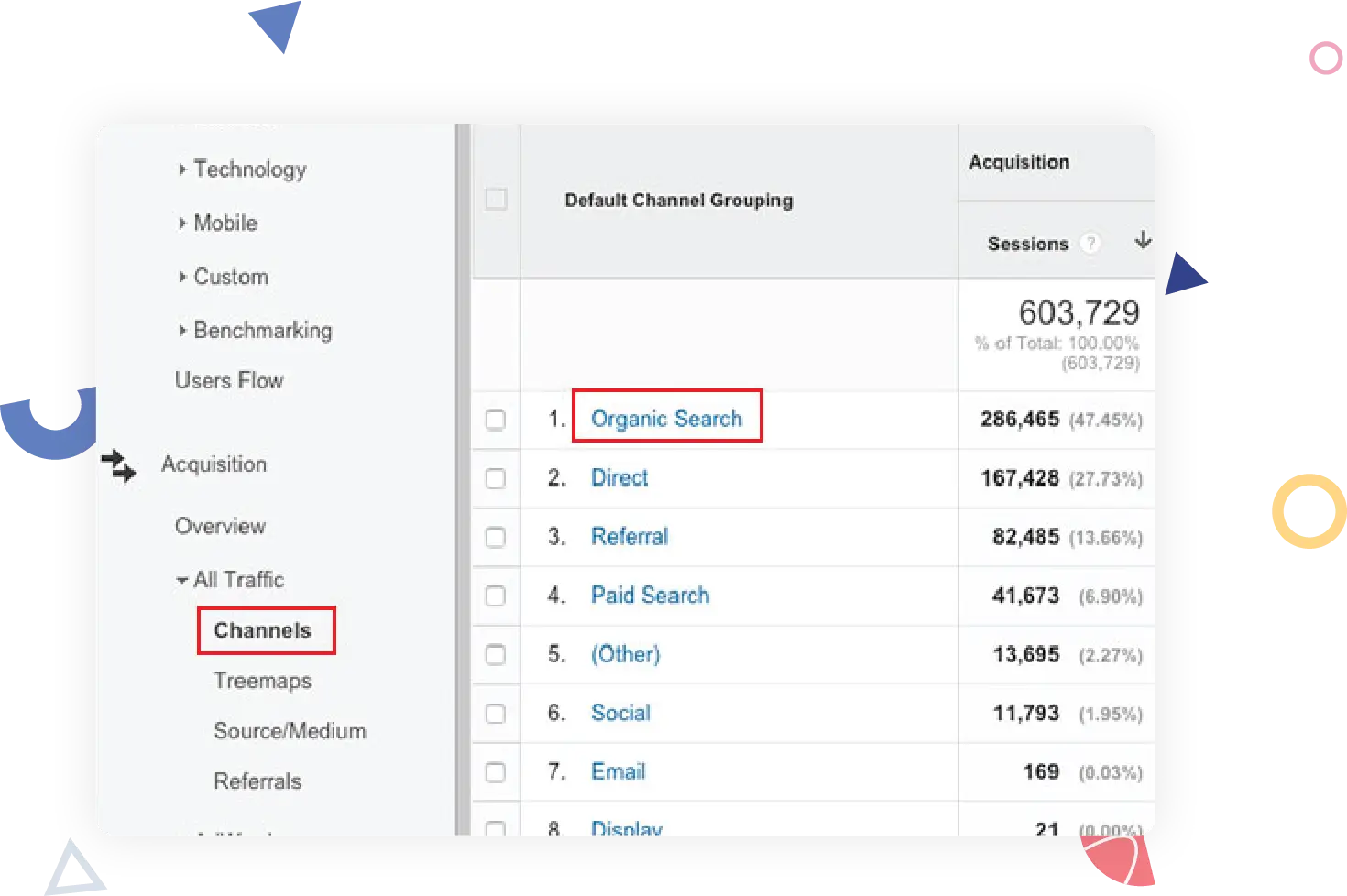
Google Analytics can surface data for you, but it can’t make you look at that data or determine your next steps based on what you’ve learned. To make the most of it, you’ll have to make sure you’re checking it regularly. So set up a recurring calendar event to remind you to check our analytics.
If you’re not sure which metrics you should be tracking, to start with, make sure you look at:
- Organic visitors
- Direct traffic
- Organic goal conversions
Google Analytics includes Analytics Academy, a series of free video tools that guide you through using Google Analytics and even offer certifications.
Bonus resource: For a comprehensive resource on how to set up Google Analytics, check out this guide.
Keep on learning
Ahrefs
Even if you don’t use or pay for the tool, the Ahrefs blog is well worth reading at least semi-regularly. It’s one of the best sources of SEO insights, facts, and studies, and one of the first places you’ll learn about Google’s algorithm changes.
Check out these studies to get started:
- 91% of Content Gets No Traffic From Google. And How to Be in the Other 9% (New Research by Ahrefs)
- How many keywords can you rank for with one page? (Ahrefs’ study of 3M searches)
- How long does it take to rank in Google? (A study by Ahrefs)
Moz
Moz has one of the most authoritative SEO blogs online, filled with practical tutorials and case studies covering a range of topics—technical, on-page and off-site.
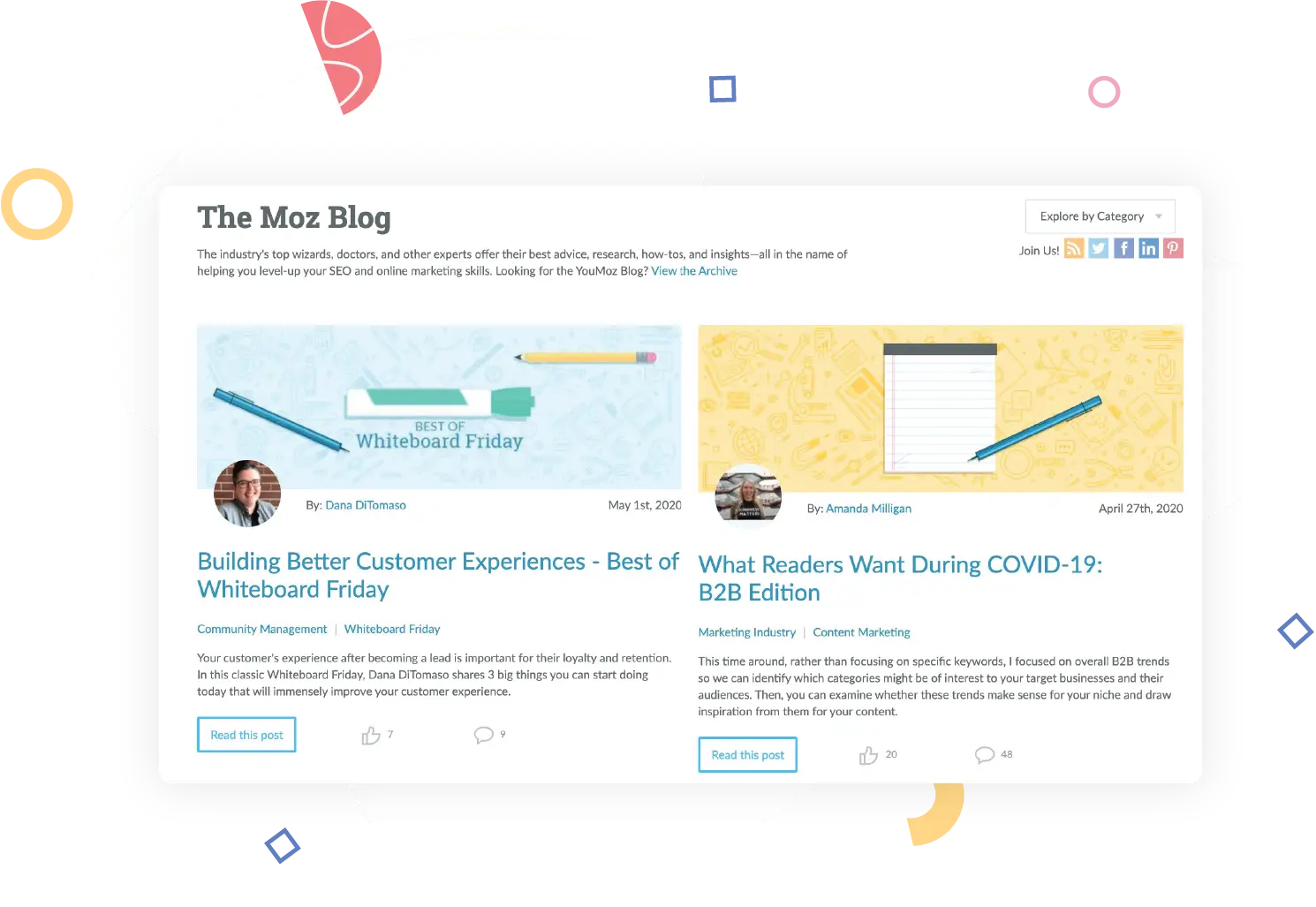
The Whiteboard Friday weekly video series is a must-watch. Here are some examples:
- What Does It Mean to “Write for SEO” in 2018?
- Should SEOs Care About Internal Links
- 5 Tactics to Earn Links Without Having to Directly Ask
And if you’re completely new to the topic of SEO, check out the Moz Beginner’s Guide to SEO.
Search Engine Land
Search Engine Land is a leading marketing industry publication that provides information on the latest algorithm updates, studies, and trends in search marketing.
You can either check the SEO section regularly, or you can sign up for daily recaps delivered to your inbox.
Bonus resource: Hungry to learn even more? Ahrefs put together a list of the top SEO resources (as voted by industry peers).
Believe it or not, we barely scratched the surface of real estate SEO in this guide—but it should be enough to get you started. Ranking well on search engines is one of the best ways to generate leads in today’s real estate environment, and real estate professionals who master this source find that it’s an ever-renewing well of prospects and clients.
Pay attention to appropriate keywords, focus on quality content, and do your best to satisfy the searchers who land on your page, and you’ll find that the real estate SEO seeds you plant today are bearing fruit years into the future.
<popup-trigger-campaign15><popup-trigger-campaign15>


![How to Dominate SEO for Real Estate [New Step-by-Step Guide]](https://app.plcstrint.com/wp-content/uploads/2024/04/636501912a3c821c62585533_How-to-Dominate-SEO-for-Real-Estate.webp)


